
Donation Request Letters
Sending out a donation request letter is a great way to increase fundraising from your supporters. Check out our templates to help you get started.

How To Write a Donation Request Letter
If you help run a charitable or cause-based organization, you’ve likely sent out a donation request letter before. Donation request letters are nonprofit fundraising letters to be sent out to individuals or other organizations, like local businesses. While these letters can be sent out at any time of the year, they are particularly effective during the holiday season in November and December, when people are feeling more charitable.
Donation request letters can be sent on their own, but some organizations also include additional information such as pamphlets or booklets. This can help your potential donor learn a little bit more about your organization and see if their ideals line up with your cause. These letters give you a chance to formally ask for donations and provide a space to clearly outline your needs and explain how a donation will benefit your mission.
Whether you’re a nonprofit organization, a school, or a church, you can send donation request letters whenever you need a little extra help fundraising for a project or if you’re in need of specific resources and supplies for an event.
Though many different types of organizations send out donation request letters seeking different types of support, the main elements in each letter tend to stay consistent.
3 key elements of any good donation request letter
What should you always include in your donation request letter? Think of this as your checklist, so make sure you have them all:
- Emotional appeal. Pull in your donors with an emotional story outlining your organization’s mission and what you’ve accomplished so far. Talk about how your organization has impacted constituents in a positive way. Whether you’re a nonprofit or you help run a faith-based organization, donors will want to know how you’ve been helping your surrounding community.
- How the donor can help solve the problem. Make sure to explain to your donors how their specific donation will contribute to your cause. Give examples of the specific, physical impact the donation will have.
- Donation information and details. Don’t forget to include information on how to send a donation, as well as details for further communication. Always provide a way for the donor to ask questions or request additional information.
Use these 3 key elements to guide your drafts as you write your donation request letters. For more specific templates, click below depending on what kind of organization you are.
Formatting your donation request letter
While the content of your letter is most important, the format and overall design can make a major difference in someone’s decision to donate.
An overloaded or otherwise unreadable donation letter will quickly turn prospective donors away, so take the time to put it into an attractive format. Here are some of the essential design elements you’ll want to consider when creating your letter:
- Letterhead: Include your nonprofit’s name, contact information, and branded logo .
- Graphics: While you might like the simplicity of a traditional black-and-white letter, images can elevate your fundraising appeals. You might include images of beneficiaries and artistic graphics.
- Typography: Choose one easily readable font and font sizes that are large enough.
- Colors: Stick to black ink. If you want to incorporate colors, choose ones that fit your brand guidelines and have enough contrast against your background.
- Envelope: While not technically part of the letter, the envelope is crucial since it’s the first impression prospects will have of your letter. Leveling up your envelopes could be as simple as including your organization’s logo in the corner or printing the text in your official brand colors.
Putting thought into your design will result in a more professional letter that inspires donors to actually read it. In any case, remember that the heart of your fundraising letter is the appeal. Because of that, you don’t want to overpower your text with an overloaded design and vice versa.
If you’re struggling with putting your letter into a compelling format, consider reaching out to a graphic designer to help. Those with experience designing letters, like Kwala , will know how to strike the perfect balance between text and graphics. That way, you can focus on perfecting the appeal itself while an expert graphic designer puts it into an appealing format that catches prospective donors’ eyes.
Take a look at this example donation request letter that Kwala’s team created:
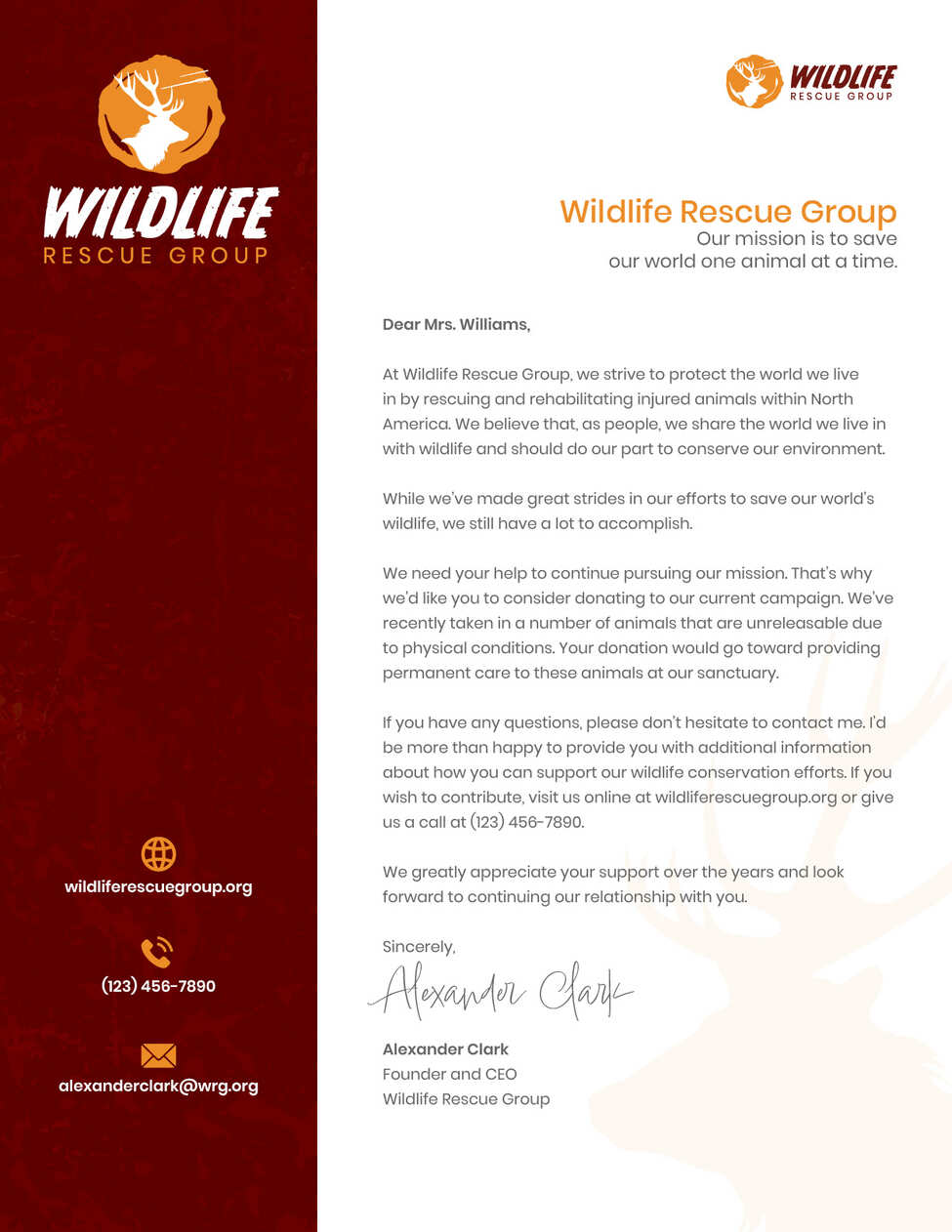
The text and graphics complement one another rather than compete with one another. The result is a professional, sleek design that keeps the recipient reeled into the message.
Sample Donation Request Letter for Nonprofits
Silent Auction Donation Letter
In-kind Donation Request Letter
Donation Request Letter for Event
Sample donation request letter to a company, donation request letter for school supplies, sample donation request letter for church, donation request letter for church building.
Donation Request for Temple
Corporate Donation Request Letter
PTA Donation Request Letter Template
Sample Food Donation Request Letter
Donation Request Letter for Sports Team
Donation Request Letter for Old Age Home
Subject: Help us raise money for [nonprofit mission]!
Dear [donor’s name],
I am [name] and I am the [position] of [nonprofit’s name]. At [nonprofit’s name], we seek to help [nonprofit mission] by [actions nonprofit has taken, use an emotional story about what your nonprofit has one so far and the lives they have changed. Give a specific example of your impact.]
While we have made some great strides, [nonprofit’s name] still has a lot to accomplish.
We need your support to [new project or event that you’re asking donations for].
Would you consider donating [donation amount, items, or services that you need] to help us achieve our mission?
If you have any questions, I would be happy to provide you with more information about how you can help support our work at [nonprofit’s name].
We greatly appreciate your donation, and it will be used to [insert how the donations will be used and the impact that this donation will have]. If you wish to contribute, please fill out the attached form or give us a call at [phone number].
Please join us! With your donation, we’re one step closer to [insert goal]!
[nonprofit website]
What makes this donation request letter effective?
Nonprofits depend on charitable donations in order to keep up their support for a cause, so writing an effective donation request letter is key. This donation request letter is effective because it immediately pulls in the potential donor with an emotionally appealing story describing who the nonprofit and its work.
Use this letter to explain that your nonprofit makes an actual difference in people’s lives with a specific example. This will show donors that this isn’t an empty request and that your organization wants to make a true difference. Be specific in what you’re asking for and what you want to do with that donation.
Silent Auction Donation Request
Subject: We need your help to make our auction a success!
My name is [name] and I’m a part of the team at [organization’s name]. Our organization was created to help [organization’s mission] and we have [stories of how your organization has helped your cause in the past. Talk about specific accomplishments you have made].
We’re hosting a silent auction on [date] as a way to raise funds and continue our work!
In order to make our auction a reality, we are seeking unique and interesting items to auction off. In previous years we’ve had contributions like [examples of items and experiences you’ve auctioned off in the past]. With our last auction, we were able to [positive physical impact of the previous auction, for example: broke a fundraising goal].
We would like to ask your company if you’d be willing to donate, [specific item or service]. If an in-kind donation isn’t possible, monetary donations are always greatly appreciated, as well.
Your contribution will be vital to helping us succeed in planning our auction. With your generous donation, [specific impact that their contribution will have on your event and organization].
If you’re interested in learning how you can help our auction, contact our procurement team at [phone number] or [email address]. Or feel free to fill out and send the attached donation form with your contribution.
As always, your contributions are valuable to the continuation of our cause.
[contact information]
Key Takeaway from This Donation Letter
Hosting a silent auction can be difficult, especially since it requires items that others will actually want to buy. Writing a donation request letter in order to procure these items can be a great way to ensure your auction is ready. This donation request letter is effective because it starts off by describing the silent auction and what your organization stands for.
Bringing up past accomplishments and previous auctions shows the potential donor that your organization has made differences in the past and that their contribution can do even more. Specifically mention successful past auction items to give your recipients a better idea of what they could donate. Let them know exactly how their donation or service can impact your organization’s event to incentivize them.
In-Kind Donation Request Letter
Subject: Do you have any [in-kind item] to help [organization’s mission]?
I work with [organization’s name] and since [year of founding] we’ve been working hard to help [organization’s mission]. [Describe your organization’s mission with an emotional story].
Each year we plan a fundraising event to help [the specific impact of the fundraiser, for example: bring supplies to homeless people]. Last year, with the help of our community and other supporters, we were able to [positive impact]. It was an incredible opportunity, and we are so thankful that we had the resources to help.
That is why we need your support for [new project or fundraiser]. Would you consider donating [items or service] to help us achieve our mission? With just [item or service], we would be able to accomplish [specific positive action]!
I would be happy to provide you with more information about how [you/your company] can help [organization’s name]. Feel free to contact me through [phone number] or [email], or look at the attached form we have provided. We would love to start this relationship with you. [organization’s name] cannot thank you enough.
Nonprofits write in-kind donation request letters when they would prefer items or volunteer services instead of financial support. These are usually written to corporations but can also be sent to specific individuals.
If you’re in need of something in large quantities, companies can provide a large resource of various supplies. On the other hand, if you need something like canned food or used clothing, the community of individuals around you are also great recipients for your donation request letter.
Make sure your letter clearly outlines what your organization is and the problem you are trying to solve. When you ask for specific items or services, the recipient needs to know why. Explain how these contributions will clearly impact your cause so that potential donors have a good idea about how they can help.
Subject: Help bring this year’s [event’s name] to life!
My name is [name], and I’m part of the team at [organization’s name]. We’re hosting our annual [event’s name]. This event not only helps raise funds for [organization’s cause], but it also will raise awareness for our cause across the community. Our previous events have [describe an emotional story speaking to the specific positive impact of event].
We’re proud to announce that this year’s event will be held on [date] at [location].
Since the event’s inception, we’ve raised over [fundraising amount], and this year, we plan on raising even more! So far, we are expecting approximately [number of attendees] participants.
However, this event wouldn’t be possible without the support of local companies who provide valuable products and services so that we can support our attendees and participants.
Would you be willing to donate [donation amount, in-kind donation, or volunteer service] to help make this year’s event possible? With your donation, we’d be able to [specific action].
If you wish to support us, I would be happy to provide you with more information and [incentive, for example: put your logo on our event materials]. Feel free to contact me at [phone number/email] or feel free to fill out and send the attached donation request form with your contribution and we can start our conversation.
Thank you for your consideration! With your help, we’re one step closer to [your goal]!
When planning an event, organizations will often send out donation request letters to supporters and local companies in an effort to raise enough money or supplies to bring their event to life. Make sure to clearly explain what your event is and mention if it has been successful in the past. It’s smart to initially reach out to corporations, as they will have the most resources for a bigger event.
Whether you’re in the search for physical supplies or want a generous monetary donation, contacting a business can be extremely beneficial. To further incentivize your recipients, you can offer to thank them publically at the event or display their brand name on event materials.
Tips and Tricks for Donation Request Letters: Segmentation
When your organization sends out donation request letters, it makes sense to reach out to your entire donor database and cover as much ground as possible. However, you don’t want to fall into the trap of writing the same letter to every person. You might attempt to at least personalize each letter with the recipient’s name, but that runs the risk of becoming a huge time waster.
Many online donation software and CRM systems have segmentation capabilities to group donors in your donor base into more specific categories. Using these segmented groups, you can more efficiently target your messages by:
- Donation history. Segment your donors based on whether they have donated to your organization in the past. For example, when requesting donations from those who donate every year and those who have never donated before, it makes sense to frame the content differently.
- Location. If you are hosting a local event or focus your on-the-ground work in a specific community, you can segment your donors based on where they’re located. When asking supporters who live in your neighborhood, begin your donation request letter with a reference to something beloved by the locals.
- Demographic markers. Your supporters are made up of individuals of many ages. With Millenials and Gen Z becoming older, they’re turning into the next generation of donors. For those who are younger, it makes sense to send a donation request email more so than a letter. Furthermore, you can develop other marketing strategies that are targeted for certain age groups. For example, an online peer-to-peer fundraiser will likely attract a younger, tech-savvy audience.
Subject: Would you be willing to help [organization’s name]?
Dear [donor’s name, for more effectiveness, find the business owner or CEO],
We are [organization’s name] and we work hard to support and bring awareness to [organization’s cause]. Ever since [year of founding], our team has been [hosting events, raising money, etc.] to help [specific positive impact of your organization].
We are currently planning [your next initiative] that will hopefully bring [impact of your efforts] to our community. That is why we are asking for your help. With your resources and [specific reason why this company should donate, for example: it is a local business and a member of the community], together we could make an incredible difference.
Would you be willing to donate [specific donation amount, in-kind donation, or service] to help our cause? We’d be happy to provide [incentive, for example: we will thank you publically, put your company’s name on our website or on event literature] in exchange to show how much we appreciate this.
If you’d like to begin this partnership, please don’t hesitate to contact us at [phone number], or feel free to fill out and send the attached donation request form with your contribution and we can start our conversation.
Thank you for your help,
[organization’s name]
Key Takeaway from This Donation Request Letter
Often times, nonprofits and other organizations will try and appeal to corporations, whether big or small, for donation requests. Although structured similarly to donation request letters for individuals, often people ask for in-kind donations (non-monetary) in addition to financial help.
Corporations and businesses have more resources, so sending them a donation request letter is smart if you’re in need of specific material or supplies. Keep in mind that businesses might want something in return, so it can be a good idea to offer an incentive. For example, offer to post their logo and business name on your literature or publicly thank them at your event. That gives them some positive exposure!
Subject: Be [school name]’s next hero!
Dear [donor’s name]
My name is [name] and I work at [school’s name] as [job position]. Each year we welcome a new class of eager and bright students that we’re so excited to get to know. We work hard to make sure we provide amazing learning opportunities and engaging events to bring our school’s community together.
This year, we are trying to [event or program you are raising money or supplies for]. [Attention grabbing story that explains why you’re raising funds. For instance, if you’re raising money to start an after school art program, share the story of a young student that needs the program to pursue his dream of becoming a graphic designer].
However, due to our school’s budgetary constraints, we had to cut back [school supplies/creative program/etc]. While we strive to offer our students the best education possible, we need the resources and supplies to keep our [program/club] running
We would like to ask that you help us continue [event or program] by donating [donation amount, specific item, or service].
If you choose to contribute to our school, you will give more than just [product or service]. You’ll be a hero to the students who will be able to [the positive result of your school reaching its goals].
Please feel free to contact me at [phone number] or by email [email address] if you have any additional questions about our program or if you’d like to support us in another way. If you would like to donate, please fill out and return the attached form with your in-kind donations.
All of us at [school’s name] thank you in advance for your support!
Warm regards,
[school’s name]
Pull at your potential donor’s heartstrings by talking about your school’s students. Mention the programs and events that your school hosts and write how your goal is to help these young students learn and grow into future leaders. Explain clearly what you’re asking the donor to contribute to, whether that is a specific program or end-of-year event.
Be specific in what you’re asking for as well, and give the recipient multiple options. Sometimes people would rather volunteer than donate monetary contributions, so it’s helpful for your donation request letter to include this as well. Make sure your donors know the specific impact of their donation to really solidify that donation!
Subject: Help lift our congregation higher!
As you know, we are [church’s name] and we are nothing without supporters like you. Thank you for continuing to keep us in your mind and contributing to our community. Every week we offer various services as well as host a number of programs and events to help empower and raise the people around us.
Lately, we’ve been trying to [talk about the reason why the church is requesting donations, for example: trying to provide clothes for those less fortunate or raising money to have a new youth program]. This will help our community by [talk about how specifically is the church going to make a positive impact].
Would you consider increasing your role in the church and donating [specific donation amount, in-kind donation, or service]? We would greatly appreciate any help you can provide, and our community will recognize your generous contribution.
If you’d like to continue this conversation and help us make the world a better place, please don’t hesitate to contact us at [phone number] or fill out the attached form. Additionally, our doors are always open and we’d love to talk to you in person at [church’s address]. [church leader’s name] is always available to discuss future steps.
[church’s name]
If you’re a church, the bulk of your support is going to come from the community around you. From tithes to other fundraising events, many churches write donation request letters to garner more personal contributions. This donation letter is effective because you’re only going to be asking your existing community of supporters.
Oftentimes your church is going to need a little bit more funding, especially if you’re creating a new program or hosting an event. Those who support your church will want to show their altruism, so make sure to emphasize how much this donation will impact your church and help the community.
Subject: Help us build a new [church building name] for our community!
My name is [name] and I am a part of the community of [church’s name]. Recently, we have been working hard to [explain what needs repairing or building for the church]. [Explain why this project is urgent, for example: the building is supposed to be ready by a certain date, or you’re so close to your fundraising goal to finish construction].
Our community is looking forward to [creating or repairing] a place where we can all come together. We would really appreciate your support and that is why we are writing to you today. Would you be willing to donate [specific donation amount or in-kind donation or volunteer activity]? With your generous help, we’d be able to [explain specific positive impact the donation will bring]. Together we can reach our goal and bring [church building name] to life!
I’d like to thank you for any help you’d be able to offer. We’re so excited to get started and [details of the church project]. If you’d like to donate, please contact me at [phone number/email] or fill out the attached form and come by the church at [address]. I would love to start this relationship with you and begin the conversation.
Hope to see you soon,
Often times, churches will need extra funds or resources to help them finish a project. Whether you’re expanding your church or just want to make repairs, a donation request letter to your community members is a good idea.
Make sure to reach out to those who frequent your church as they are the ones who want to help the most. Let them know what your goal is with the construction project so they are aware of exactly what is going on. Since you are a faith-based organization, reach out in personal ways. Include specifically how they can help and invite them to talk in person to begin this positive relationship!
Donation Request Letter for Temple
Subject: [temple’s name] calls out to you for support.
My name is [name] and I work with our local temple, [temple’s name]. We have been active for [amount of years] and strive to engage our community in celebration of our shared history and traditions. More than ever it’s important that there is a safe, cultural place for us to come together and share experiences. Over the years, we have worked hard to [describe past events, past fundraisers, etc.]
Every week we host [weekly religious event, for example: shabbat] and see [amount] of families and individuals come through our door. Coming together to celebrate as a community is our core purpose and one of the main ways in which we give back, but we can’t do it alone. That is why we are writing to you today.
With a donation amount of [donation amount, in-kind donation, or volunteer service], it keeps [physical impact, for example: our lights on for a day], and a donation of [larger dollar amount, in-kind donation, or volunteer service] can [larger physical impact, for example: gives seven children the chance to join a program].
If you’d like to make a contribution, please contact our office at [phone number] or send the attached donation request form with your contribution and we can start our conversation. Additionally, we’d always love to talk in person, so feel free to visit us at [temple’s address].
Thank you again,
Temples and other faith-based establishments send out donation request letters in order to garner additional support from their community. A lot of temples rely on their community in order to perform many of their recurring events and religious services. With Shabbat services happening every weekend, it can take a lot to handle the logistics and costs.
It’s smart to send your temple donation request letter to people of the same faith, as they would likely be the most familiar with your religious events. Along with asking for financial gifts, you might want to ask for volunteer help from older, more experienced members, as well as in-kind donations such as clothes, food, and other resources.
Tips and Tricks for Donation Request Letters: Prospect Research
If your organization needs extra help, whether it is financial gift or an in-kind donation, it’s likely that you’ll send out a couple of donation request letters. But how does your team choose who will receive them? With prospect research tools, your organization can do research to find those who might have the ability to become major donors.
Major donors are those who make large contributions to your cause . For many organizations, a majority of their funds are provided by just a couple of those major donors. According to DonorSearch , on average, over 88% of all funds come from 12% of donors — your major donors.
Prospect research is a method used by any organization that deals with donors in order to learn more about them. Filtering your past donors and the surrounding community, prospect research tools can look at a donor database and filter for:
- Business affiliations.
- Past giving history.
- Personal information.
- Real estate ownership.
- More markers of financial ability and philanthropic tendencies.
These factors can help evaluate a prospect’s giving affinity (to indicate how much they care about the cause), giving capacity (to indicate if they have the means to make a major gift), and giving propensity (to indicate where they are likely to be philanthropic), make up the three key factors of major gift fundraising.
Sample Donation Request Letter for Animal Shelters
Subject: Help us find homes for [pet names].
We are [animal shelter’s name] and we have been in operation since [year of founding] to help [types of animals] who don’t have homes or need medical help. Earlier this year, we [emotional story about an animal you have saved or found a home for].
Furry friends like [pet names examples] are looking at shorter, harder lives without organizations like ours. We wish we could give each animal a home, but it’s always a challenge. We need funds for supplies like [food, medicine, shelter, etc] to keep them safe and healthy in the meantime. That’s why we are asking for your help.
With a donation of [donation amount or resources], you can help our shelter [physical impact of the donation, for example: help some kittens get vaccinated or help puppies stay warm for the winter]. We are able to provide these lovable animals with homes and love because of our community and supporters like you.
If you’d like to help in any way, please don’t hesitate to contact us at [phone number] or visit our shelter at [address]. Additionally, you can fill out the form we’ve provided.We’d love any help you can provide, and we know [pet names examples] will be grateful.
[animal shelter’s name]
If you work for an animal shelter, you know that you can’t provide homes for or save every animal, even though you want to. If you’re looking for some extra help, sending out donation request letters to your community can be a good idea.
Pull donors in with an emotional story about an animal you have recently saved. This way they can get invested and you can prove that your animal shelter really does make a measurable difference. End your letter by giving the donation details. Let your donors know that they can help in other ways if they can. Pet supplies and volunteer work can also be a great help to your shelter.
Sample Donation Request Letter for Museums
Subject: [museum’s name] needs your help!
[museum’s age] years ago, we opened our doors to our first visitors and officially began operating as the [museum’s name]. Since we opened, we’ve seen [number] international exhibits, [number] first-time visitors, and [number] groups of schoolchildren come through our halls.
Did you know that [percentage]% of our budget comes from the donations of supporters just like you? We as an organization rely upon donations of all sizes, from the change in your pocket to much larger endowments and grants.
Our mission is to provide education about [museum’s focus] and bring joy to everyone from the youngest to the oldest members of our community, and we can’t continue to do that without your support.
A donation of just [dollar amount] keeps [physical impact, for example our lights on for a day], and a donation of [larger dollar amount] can [physical impact, for example: gives seven children the chance to join a program].
If you are able to donate at this time, you can do so by returning the form attached to this letter, calling us at [phone number], or by visiting us online at [museum webpage]. We also gratefully accept in-kind donations of office supplies and technology to help keep our administration running smoothly.
Please consider becoming a member, as well, to take advantage of year-round benefits and provide more stable support for our work.
We appreciate your support of the [museum], and hope you come visit us soon!
[museum website]
Museums often rely on their community of supporters to help them launch new exhibits or provide fantastical events showcasing a new artist. Major gifts make up a large part of the revenue for museums, so maybe look into some prospect research tools as well. Learn to write an effective donation request letter by starting out with a history of the successes of your museum.
Make sure to highlight your successes, whether it is the amount of exhibits you’ve hosted or the amount of schools you provided educational content to. Donors will want to know what your museum has done so they’ll have a better idea of what their money will be used for. Further explain how different donation amounts help impact your museum to show donors that any amount will help.
Sample Donation Request Letter for Theatres
Subject: The show must go on!
My name is [name] and I work at the [theatre name]. For the past [years] years, we’ve been putting on productions that showcase our talented actors and actresses and work hard to provide unforgettable experiences for our audience.
Currently, our cast and crew have been practicing and rehearsing to help bring [new show name] to life. We are so excited to bring [show details] to the community, and we know it’s going to be a special night.
Last year, our biggest production, [show name], brought in [amount] attendees in the audience. This year, we hope to bring in even more people to our seats. That is why we need your help. With the costs of [expenses, for example: stage materials, costumes] piling up, it’s getting harder to put on the show that we’ve all envisioned.
Would you be willing to donate [donation money amount or other in-kind donations] to help out our cast and crew? With that small gift, we would be able to [positive physical impact], and bring us so much closer to putting this show on the stage. We would appreciate any help that you can offer.
If you’d like to make a contribution of any kind, please don’t hesitate to contact us at [phone number] or to check out our website, [website URL]. We have also provided an attached form for you to fill out. Let’s start this conversation. The shows that we put on would not be possible without supporters of the arts like you.
Please, don’t hesitate to visit us!
Theatres often need support from their community so writing a donation request letter is a common occurrence. Whether you need financial help or specific materials and resources, reaching out to those around you is a great way to ensure that your productions are the best as possible.
This donation request letter is effective because it creates a connection between people who are inspired by the arts and possible donors. Pull them in with an emotional story about how your theatre came to be and some general history on it.
Subject: [organization’s name] needs you.
My name is [name] and I am in the [position] for [organization’s name]. Our team works hard to support and bring awareness to [organization’s cause]. Ever since [year of founding], our team has been [hosting events, raising money] to help [specific positive impact of your organization].
We are planning something new, so get excited. By [date], we are hoping to launch [upcoming project or event] that will bring [impact of event] to our community. That is why we are asking for your help.
As a leader of your community and business, you must know how difficult and costly large initiatives like ours can be. With the resources [corporation’s name] has and your incredible history of charity work, I know that together we can make a huge difference. [Bring up a common goal or mission of your organization with the corporation].
Would you be willing to donate [specific donation amount, in-kind donation, or service] to help our cause? We’d be happy to provide [incentive, for example: we will thank you publicly, put your company’s name on our website or on event literature] in exchange to show how much we appreciate your support.
If you’d like to begin this partnership, please don’t hesitate to contact us at [phone number/email]. We have also attached a form and other materials for you to review.
Hope to talk soon,
Corporations and other large businesses have a wealth of resources that individuals might not. If you’re planning an event that is in need of a large amount of supplies, whether that be uniforms or food, or support to rent a venue, a corporation is a good recipient of a donation request letter. It can certainly be a challenge to get a large corporation to send a donation, however, so that is why you have to frame your request letter carefully.
Find a corporation whose mission aligns with yours or who has helped other similar charities or fundraisers in the past. Bring up how they specifically, can help your cause. Additionally, talk about all the great impacts your organization has already made. Larger corporations will want to donate to an organization that already has a positive reputation.
Tips and Tricks for Donation Request Letters: Matching Gifts
Writing donation request letters can really help your organization raise some revenue if you send them out to your community of supporters. Oftentimes, you will receive donations, and whether they’re big or small, they make a huge impact. Each contribution adds up, but did you know there was a way to maybe double the impact of each donation with matching gift programs?
Corporate matching gift programs are a form of corporate philanthropy where businesses will financially match a donation that an employee gives to a charitable organization. Whether you’re a charitable organization, a faith-based group, or an educational institution, you can potentially take advantage of these programs, depending on the individual rules set by each business.
To see if any past donations can be matched by employers, you should invest in a trusty matching gift database. This way, your team and your donors can look up employers’ guidelines and determine eligibility. For even stronger results, Double the Donation , the largest and most accurate matching gift database, offers a robust automation tool called 360MatchPro . You can check your donors’ business affiliations as well as access the necessary forms and deadlines to see each matched gift through to completion.
PTA Dontation Request Letter Template
Subject: Let’s make this the best year yet for [school’s name]!
My name is [name] and I’m a part of the Parent Teachers Association at [school’s name]. As you probably know, we work hard each year to build strong relationships among parents, teachers, and the school, all while creating engaging programs for our students.
[describe the emotionally compelling reason why you’re reaching out to this donor. For example, they are a parent of a student, or they are an alumnus, or they are a local business]. You know how important the school experience is for students, which is why we are planning [new school event or program].
[new school event or program] is set to take place during [date]. [Describe the event/program, talk about what’s the event/program consists of and how it will help your students]. Working with the teachers of [school’s name], the PTA is so excited to bring this to our kids. However, with the costs of [school supplies, food, resources, venue], we need to reach out to our school’s community for the extra support to push us to the finish line.
Would you be willing to donate [specific donation amount, in-kind donation, or service] to help us bring this experience to the students? We would love to offer you an incentive and thank you during our event. Please contact our office at [school’s name] using this phone number, [phone number] or you can send us an email: [email address]. We have also provided a form which you can fill out.
We’d love to start this conversation with you and see how you can help make this year the best for our students!
If you’re a member of a school’s PTA, you are tasked with planning events and programs each year and work with both teachers and parents to engage your students. If you need extra funding or even some resources from local businesses, it’s smart to send out a donation request letter to the community.
Keep in mind that depending on who you are reaching out to, you can use their relationship with your school to create an emotionally compelling story. Reach out to parents, alumni, and local businesses, as they will connect to your school the strongest.
Also, don’t forget to describe the event or program your school is planning. Talk about the specific ways it will benefit your student life and engage them in educational and unique activities!
Subject: Help feed our community with [organization’s name]!
We are [organization’s name] and we work hard to provide awareness and support to [organization’s cause]. [Describe emotional story about how your organization started working towards this cause].
In the past, we have hosted a number of programs that have helped our community. [Describe past events or activities your organization has hosted in the past. Talk about the specific positive impact of these events]. We hope to break our own records this year with our new, upcoming event, [new event name]. Taking place on [date], we want to bring [details of what this new event will do for your community, explain how food plays into your event].
However, to make this event a true triumph and bring the best experience to our community, we want to ask for your help. Would you be willing to make a food donation to our organization? In order to [goal of event, for example: feed our attendees, help homeless people], we would love any help you can give. Look through your pantry, because just [small donation amount] will help us [small positive impact] whereas a [larger donation amount] will help us [large positive impact].
If you’d be willing to contribute a gift of any kind, please contact us at [phone number] or visit our website at [website]. There is also an attached form with additional information. We’d love to begin this conversation!
Whether your organization is a charitable nonprofit, a faith-based institution, or a local elementary school, oftentimes you will be in need of more in-kind donations rather than monetary donations. Donation request letters for food can be sent to either individual supporters or local businesses, depending on the gift that you’re looking for.
Make sure to mention specifically what your organization needs from the donor. It helps if you give specific amounts or a list of accepted items so they can look through their pantry and resources to gauge whether they can donate. Give them different donation levels to pick from with different impact levels as well, this way they can donate a smaller amount if that’s all they have and know it has made a difference.
Sample Donation Request Letter for Sports Team
Subject: Help [team name] bring home that trophy!
My name is [name] and I’m [describe your association with the sports team, for example: I am a coach, I am a parent] with [number] other amazing players and teammates. [Give a description of your sports team and how it started. Try to make your story emotionally investing, for instance, describe a specific player and their journey on your team].
Each year, this league brings players so much joy and enjoyment, allowing them to engage with others who are passionate about [sport]. We are beginning to prepare for the new season, and we are so excited to help [team name] bring home that championship trophy. However, with transportation, new uniforms, and equipment for over [amount] of individuals, the costs are adding up.
Since you are [describe the reason why you’re asking them for a donation, for example: you used to play in the league, you are a parent of the league, you are a local business], would you be willing to make a donation of [donation amount, equipment, food, other in-kind donations]? With just that contribution, we’d already [positive impact, for example: give a whole team of young girls new softball uniforms].
If you’d like to make a donation or want to help out in other ways, please call me at [phone number] or visit our website, [URL], for more information. We have attached a form for convenience as well. The players of [sports team] can’t thank you enough.
Best wishes,
[photo of sports team]
If you help manage a sports team, you’ve probably had to raise funds before. Funding transportation, snacks, uniforms, and other team necessities can be difficult without some help from your surrounding community. You can ask for donations from both individuals or local businesses, depending on what you’re trying to fundraise for.
Remember to be specific in asking for what you need and why you need it. For example, whether you need help with transportation costs in order for your team to go to a different town for a game or need a new set of baseball uniforms, write that down. Additionally, be specific with the resources you are asking for. If you want a financial donation, talk about the exact amount you’d want and how that donation will impact your cause!
Subject: Come and help out the residents of [old age home’s name]!
My name is [name] and I am on the [position/connection to old age home] for [retirement home’s name]. We support over [number] of elderly folk, some who have families and some who don’t. Ever since [year of creation], we’ve tried to help our older individuals be comfortable and engage with others in various activities. [Talk about a specific resident and how your old age home has helped them].
From day-to-day care, healthy meals, medical attention, and community programs, [old age home’s name] strives to create the best environment for our elderly to thrive in. However, the costs of looking after all these people can start to add up, especially since many of them don’t have any outside family. [old age home’s name] is proud to be a family to all residents and community members.
Currently, we have a shortage in [medical supplies, resources, etc.]. Would you be willing to donate [donation amount or in-kind donation or volunteer service time]? With your help, we’d be able to [positive impact on surrounding community and elderly residents].
If you’d like to make a gift, please contact our office at [phone number] or stop by the home. We can start talking about how you can best help. We have also attached a form to fill out for convenience. The elders of [old age home’s name] are so appreciative.
Thank you so much,
Old age homes help the elderly who don’t have a place to live or need extra day-to-day support. While they are an important institution in society, many forget about them unless they themselves have a relative at one. Many old age homes depend on their community for support, both with financial help and volunteer services, so it’s good to learn how to write a great old age home donation request letter.
Make sure you open up with an engaging story to really let your recipients know how crucial it is that your elderly residents receive help. Be specific, it can help to talk about a specific resident or patient you have and how your old age home has helped them in particular. Describe exactly what you need and the services you’re looking for, and give them a wide range of choices.
Sometimes your community members can’t give a financial gift but would be happy to volunteer!
About FundraisingLetters.org

FundraisingLetters.org is a project put together by Nexus Marketing and ECardWidget as a way to help individuals and organizations across the world effectively communicate with supporters. Feel free to use our fundraising letter templates for your organization.
Most Popular Resources
The Basics of Fundraising Letters
Donation eCards
Matching Gift Letters
Sponsorship Letters
Digital Greeting Cards
Work with Us / Contribute
Do you have deep expertise in nonprofit marketing, fundraising, or communications? Let's see if there's an opportunity to work together!
- Work with Nexus Marketing
- Apply to contribute to FundraisingLetters.com and our team will be in touch.
- Sponsor an Upcoming Event or Email Series
10 Steps on How to Write an Inspiring Donation Letter with Templates
Donor Acquisition and Retention
Share this article

Donation letters, also referred to as donation request letters, are one of the most effective ways to reach your donors and solicit a gift. However, it’s not enough to simply send the same appeal to your entire supporter base and ask them to donate.
Writing a great donation letter is an opportunity to engage your supporters and show them the impact they have on your mission. By personalizing your donation letters, your nonprofit can not only increase your fundraising revenue but also develop relationships with your supporters.
Whether you’re just starting your donation letter strategy or seeking ways to improve it, it’s always a good idea to review the basics and make sure your communication strategies lay a solid foundation for growth.
Ready to start crafting the perfect donation letter to send to supporters?
- What is a donation letter?
- How to write the perfect donation letter in 10 steps
Donation request letter templates
- Donation letter writing best practices
What is a donation letter?
Donation letters are used to request financial contributions or solicit in-kind donations through traditional channels, like direct mail, or using digital channels, like email. Donation request letters are an essential tool for nonprofits seeking to connect with potential donors and inspire them to contribute to their cause. These letters are particularly impactful during nonprofit giving days like GivingTuesday and targeted fundraising campaigns, providing a personal touch that can resonate with recipients.
Whether delivered through traditional direct mail or digital channels like email , donation request letters offer flexibility to suit the preferences of different donors. While they are commonly utilized to request financial contributions, it’s important to note that donation letters can also effectively solicit in-kind donations , such as goods or services, from generous supporters. This versatility allows nonprofits to leverage donation letters across various fundraising initiatives, maximizing their outreach efforts and fostering greater community engagement.
What is the purpose of a donation letter?
The primary goal of donation letters is to encourage your supporters to give to your cause by showing them the effectiveness of your organization’s mission. Not only can donation letters help boost your fundraising, but they can also help you establish a personal connection with your supporters to foster long-term relationships built on shared values and philanthropic impact.
A simple donation letter can also help you raise awareness for your cause. While not everyone you send a letter to may be able to give, you can provide them more information about the work your organization does so they think of you in the future.
Who do you send donation letters to?
As you’re first building out the recipient list for your donation letters, your best bet is to look at your previous donors. They’re already familiar with your organization and your work, meaning they’re more likely to give again. Plus, you can segment your previous donors by how often they engage with your organization and what campaigns they’re most likely to respond to. This allows you to create more specific donation letter templates for different types of donors and keeps you from flooding unresponsive donors’ inboxes.
Besides previous donors, donation request letters can help you motivate others to give as well. Here are some other examples of who to send a donation letter to:
- Social media followers. These supporters engage with your content and mission, meaning they’re already invested in your cause.
- Past volunteers. Even though you know they’ve never given, you also know that they support your mission.
- Previous event attendees. Remind your past attendees of your mission to respark their support.
- Corporations. You can send businesses a donation appeal to encourage them to create matching gifts programs with your nonprofit.
- Local clubs. Local community groups can be a great source of mutual aid for your organization.
How often should you send donation letters?
Determining the right frequency for donation letters can vary based on your donors’ preferences and nonprofit’s needs. While the conventional suggestion is about four direct mail letters per year and one email monthly , it’s essential to adapt to the evolving landscape of donor engagement .
An effective strategy includes promptly surveying donors for their communication preferences post-donation or opt-in to email lists. Recording this data in your fundraising platform enables tailored correspondences in line with donors’ preferences, ensuring more meaningful engagement. Focusing not only on frequency but also on personalization and relevance is key to fostering deeper connections and driving impact for your cause.
What channels should you send your donation letters through?
Sending donation letters through direct mail or email remains the most common practice among fundraisers, allowing them to cater to donors’ preferences effectively. However, with the continued evolution of digital communication and the emergence of new fundraising channels, nonprofits have expanded their approaches to include various methods beyond traditional mail and email.
Here are some other ways your organization can send donation appeals to help you achieve a greater impact:
- Social media messaging platforms
- Mobile apps
- Personalized vi d eo messages
- Text messages
Leveraging donor data is crucial in determining the most effective communication channels for your organization. By analyzing donor behavior and preferences, nonprofits can tailor their outreach strategies to match how donors prefer to engage. For instance, if a donor has previously donated online, sending donation letters via email might be more effective, while donors who have primarily engaged offline may respond better to direct mail campaigns.
In addition, conducting donor surveys to gather insights into donors’ communication preferences is another valuable strategy. By directly asking donors about their preferred communication channels and frequency, nonprofits can refine their approach and ensure that donation letters are delivered in the most impactful way possible.
What types of donation letters are there?
There are many different types of donation letters your organization may need to send out over the years. The most common letters are general donation appeals, thank-you letters , and sponsorship pitches. There are a lot of situations where sending a letter could help your nonprofit increase funding. Create a donation letter specific to your cause or create letters for specific events.
- General appeal letters: Use a general appeal letter to ask for donations, call for crisis funding, or request items your organization needs. These letters can also be used to recruit volunteers or invite your supporters to a fundraising event.
- Donor thank-you letters: Send a thank-you letter to encourage donors to upgrade their one-time donation to a recurring donation or apply for their employer’s gift matching program while updating them on your campaign’s progress.
- Donation request letters: Donation request letters are also a great way to pitch to local businesses for sponsorships or help convert a mid-level donor into a major donor. Taking advantage of templates and ChatGPT decreases the time it takes for you to reach out to your donors!
What do you write in a good donation letter?
The contents of your donation letter should be customized to your campaign, but there are several key elements you should include:
- Introduction
- The problem
- Your solution
- How donations help
- How to donate

How to write the perfect donation request letter in 10 steps
To write an inspiring donation letter, follow these simple steps:
1. Start with a personalized greeting.
The first thing that your donors look for is a personalized salutation, begin your letters with a nice greeting and include your recipient’s name. Donation letters without a name seem impersonal and are more likely to be ignored. Some studies show that emails including names in the salutation are 26% more likely to be opened, but only 79% of donation emails actually use donor names! It’s also important to include your organization’s logo on the letterhead so donors recognize who the letter is from and don’t throw your letter away.
2. Explain your mission.
If the recipient hasn’t heard of your organization before, explain your mission at the beginning. This way, readers get a good understanding of what you’re fighting for and the goals you want to accomplish. One of the best ways to do this is by sharing a story from someone who’s benefited from your organization, and then sharing how your donors helped make a difference in that person’s life. This connects your donors to your mission and shows them the people they’ll help with a gift.
3. Describe your current project/campaign/event.
You’re likely sending out donation letters for a specific reason, whether that’s a project, campaign, or event. Describe that reason clearly and include key details like dates or guidelines. The story at the beginning of your donation letter will reinforce your appeal!
4. Include why this project is in need and what you hope to accomplish.
Don’t forget to explain why it’s important for your donors to support this project in your donation letters. How does it help them make a difference? Why should they give to this program in particular? For instance, if you’re raising money to provide resources to schools around the world, tell your donors the exact school and community their donations will support. Giving a backstory is a great way to connect deeper with your prospective donors.
5. Add meaningful photographs or infographics.
Humans are visual creatures and often make connections to a cause through visualizing it. Include photographs of your impact, especially photos featuring people you’ve helped! If your appeal is focused more on data, use infographics that show statistics to make important information easier to understand and bright colors to attract your donors’ attention. If you’re sending your letters via email, include a behind-the-scenes video.
6. Show the tangible impact associated with specific donation amounts.
Donors like knowing exactly where their money is going and how it will help make a difference. Within your donation letter, make a strong ask by describing specifically what their gift will do. For example, stating that a donation of $100 provides a dog with food, shelter, and medicine helps your donors understand their impact. It may also inspire more generosity—they might decide to increase their original $50 donation to $100!
7. Highlight past successes.
Share specific examples of how past donations have made a difference and contributed to the success of your organization’s projects or programs, if applicable. Demonstrating tangible outcomes and success stories can inspire confidence in potential donors and illustrate the impact of their contributions.
8. Include authentic testimonials or endorsements.
Incorporate testimonials from satisfied donors, volunteers, or community members to add credibility and authenticity to your donation request letter. Positive endorsements from individuals who have firsthand experience with your organization can resonate with potential donors and reinforce the value of supporting your cause.
9. Use a clear and direct call to action so readers know how they can give.
It’s essential to provide a clear and direct call to action (CTA) that guides donors on how they can give. Whether it’s directing them to visit your website’s donation page , filling out and mailing back a donation form, making a text donation , or calling a designated phone number to make a contribution, clarity is key. By clearly outlining the steps donors need to take to support your cause, you remove any ambiguity and make it as easy as possible for them to act on their desire to make a difference.
Furthermore, it’s essential to create a sense of urgency and importance around your call to action, emphasizing the immediate impact that donors’ gifts will have and highlighting any deadlines or matching gift opportunities.
10. Sign your name with any contact information and thank your reader for their future gift.
Express sincere gratitude to your donors for considering supporting your organization. Even if the primary purpose of your donation letter is to solicit a gift, taking the time to thank recipients for their attention and potential contribution demonstrates genuine appreciation for their support.
Additionally, ensure that your letter is signed by hand personally, ideally by a member of your organization’s leadership or a recognizable figure associated with your cause. Including contact information, such as phone numbers, email addresses, website URLs, and social media handles allows donors to easily reach out with any questions, concerns, or to make their donation. Providing this accessibility reinforces transparency and trust, essential elements in fostering strong donor relationships.
To get you started on your donation letter journey, here are some templates for common situations:
General donation request letter
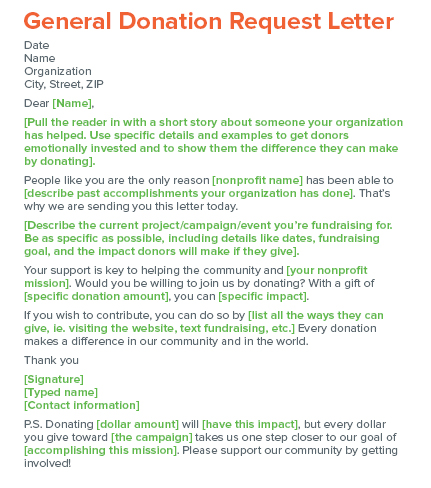
When sending donation letters, there’s a standard format you can follow or adjust to suit your unique voice and audience. Above all, your donation letters should be personalized to the recipient and effectively explain how their donation will make a difference in the world.
This template is very generic and can be referenced for any type of fundraising effort. Use this simple donation letter sample for guidance to ensure you hit the most important points, but feel free to add your own spin to it to better connect with your audience.
Thank you letter for donation
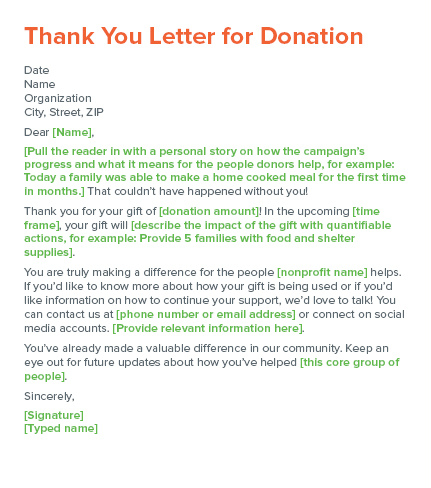
Every donation you receive should be answered with a heartfelt thank-you letter! After all, without the support from your donors, your organization wouldn’t be able to make the meaningful difference it has.
When crafting your thank-you donation letter , feel free to use this template to guide you. This way you know you’re keeping the content personal and effectively showing appreciation to your donor. Remember to include the impact of the gift so that your donors know it was put to good use. Include receipts for your donors’ taxes when sending thank-you letters to take care of both items in one fell swoop.
Donation letter during a crisis
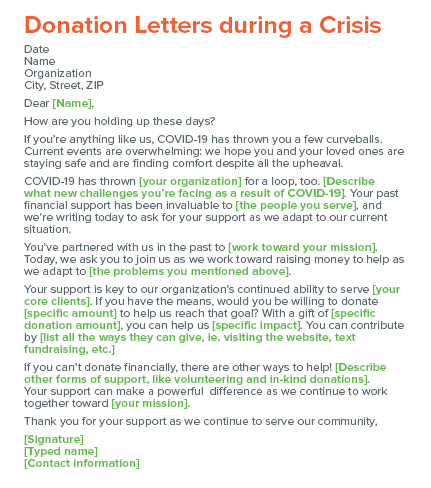
Writing donation letters during times of crisis and instability may seem like a daunting task. When approaching delicate topics like this, your best bet is to acknowledge it right off the bat and let your donors know you understand their situation. In the end, it’s important to remember that these letters should be donor-centric and focus on connecting your donor to the people they’ll help.
Follow this template to ensure you hit the important points and details. As always, you can add additional information that’s pertinent to your organization.

Best practices for successful donation letter writing
Donation letters and other donor communications are a great way to build important relationships and, in turn, increase your donor retention rates . To be the most effective, your communications must be personable and relevant to the recipient.
To best connect with your donation letter recipients, here are some best practices you can incorporate, in addition to the steps highlighted above:
- Tell a story. As mentioned before, it’s been proven that a captivating story is one of the best ways to connect with your donors. Include a personal story from someone that’s benefited from your programming in your donation letters. Instead of telling your donor what your organization does, show them! This is a compelling way to introduce your mission to those who haven’t heard about your organization before.
- Appeal to your donors’ emotions. Your donors are more likely to connect with your mission if your donation letters appeal to their emotions. Humor or heartwarming stories are both great ways to get your donors to feel good about donating while reading your letter. You can also play on people’s sense of urgency by relaying the need you have for funding. Remember to center your donors with actionable language about what they can do to help. Make your donors the hero of your organization.
- Make sure your letter is easy to read. Your donation letters won’t have the desired effect if they’re unreadable. Choose your font and letter style carefully to guarantee your supporters can easily skim through your letter. Don’t use overly complicated language either. Having to look up what your letter says takes the reader out of the donation mindset.
- Know your audience. You’re going to be sending donation letters to a wide variety of supporters, whether they’re young or old, past donors or new donors, one-time or recurring donors. Your donation letters should reflect those differences by catering to those various donor segments. For instance, a donation letter to someone who previously gave before should include an acknowledgment of that fact as well as the impact of that gift.
- Segment your donors. Divide your donor database into distinct segments based on factors like donation frequency, amount, and engagement level. By understanding the unique characteristics and behaviors of each segment, you can tailor your donation letters to resonate more effectively with specific donor groups, ultimately maximizing engagement and donations.
- Personalize your donation appeals. Customize your donation request letters by addressing donors by name and referencing their past interactions or contributions. Incorporate personalized anecdotes or stories that illustrate the impact of their support, fostering a deeper connection and motivating continued engagement. By personalizing your communication, you demonstrate appreciation for each donor’s individual role in advancing your organization’s mission, ultimately inspiring greater loyalty and support.
- Be specific. When asking for donations from your supporters, you have to be specific about what you want them to do. Don’t just specify why your organization needs funds during this time— specify how much you want them to give by suggesting exact donation amounts. It’s also helpful to explain why your donors should give now instead of waiting to make a gift. When your recipients understand the appeal’s urgency and have an idea of how much they should give, they’re more likely to donate immediately instead of waiting.
- Track your donation letter data. Each time you send a donation letter, whether by email or direct mail, you should be collecting and storing data in your CRM about that letter’s performance. Make sure your tools can track important data points like the recipient’s name, whether the recipient responded, and how often your donation letters convert to gifts.
- Pick the perfect time to send it. Send a direct mail donation letter at the beginning of your campaign. You don’t want to risk asking too late. The recipient may not have enough time to make a gift before your campaign ends! On the other hand, sending one too early can have its drawbacks, too. For example, if you’re sending a donation letter asking for gifts to your Giving Tuesday campaign, sending too early may result in the recipient forgetting about the event before it even happens. Carefully consider the perfect time to send donation letters and find that sweet spot between too late and early.
Your donation letters have one primary purpose: to inspire your donors to give. But a great donation letter does more! By following these donation letter best practices, you lay the foundation for future engagement. Sending an engaging, inspiring donation letter gives you the opportunity to get to know your supporters better and build long-lasting relationships.
Final thoughts
Feel free to use any of these donation letter templates to help you with your communication and fundraising needs . Having the resources to effectively reach your donors is the best way to develop relationships and increase fundraising for your organization! Donation letters help you expand your donor base and improve your connection with your current donors.
Additional resources
Check out these additional resources for more donation appeal templates!
- Donor Appreciation Email Templates: Showing donors you genuinely appreciate them can strengthen connection and loyalty. Use these donor appreciation email templates to make the work a little easier.
- Peer-to-Peer Fundraising Email Templates: Effective communication is one of the best ways to inspire your peer-to-peer participants. With these peer-to-peer fundraising email templates and tips, keeping your supporters motivated is simple.
- Text Message Templates for Nonprofits: Here’s a collection of handy text message templates for thank-you texts, impact messages, volunteer appeals, event reminders and more!
- Interactive Donation Form Templates: The layout of your donation form has a major impact on donor conversion rates! Should you use a multistep layout to break up the process? Is a single step form the best answer? These interactive donation form templates to help you decide!

About the Author
You might enjoy

The Nonprofit’s Guide to Legacy Giving

15 Donor Appreciation Event Ideas for Every Budget

Digital Fundraising Guide: Ideas & Steps to Reach Your Goals
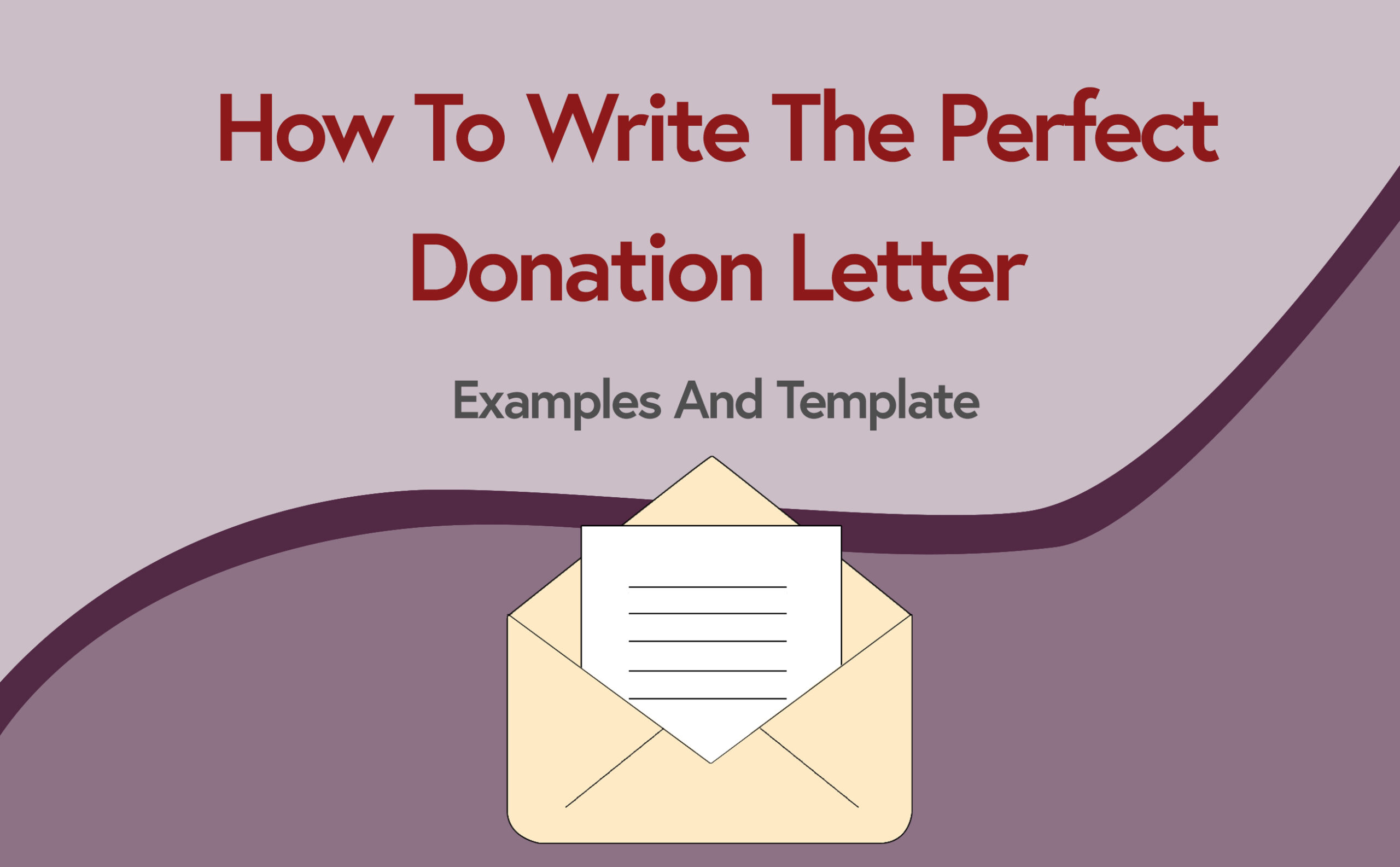
How to Write A Donation Letter (+ Examples & Template)
If you work in a nonprofit, you’re probably knee-deep in crafting your donation letters.
After all, donation letters are one of the most effective ways to connect with your supporters and inspire them to contribute to your nonprofit.
Effective letters also deepen the trust between your nonprofit and supporters by highlighting where their financial gifts will go and what impact they will have.
Now the question is: how do you get your donation letter to stand out from the crowd?
Truth be told, everything from your intended audience to your donation letter format matters if you want to attract donors.
So, in this post, I’m breaking down how to write a donation letter.
I’ll also highlight two stellar nonprofit donation letters, provide you with a sample donation request letter and share some best practices to help you along your letter-writing journey.
If you’d like to skip down to the template, click here . Otherwise, read on!

Why: The Purpose of Donation Letters
Donation letters, also known as appeals, are a tool nonprofits use to entice prospective supporters to donate. Most of the time, they include a written ask for donations like financial support or an in-kind gift.
Donation letters can ask for:
- Individual financial donations from people and families
- Corporate financial donations from businesses and corporate partners
- In-kind donations for non-cash gifts, such as office equipment
- Volunteer requests for someone’s time, like helping out at an event
Although they’re fairly short and don’t necessarily have the depth of your typical pamphlet or other marketing materials, donation letters address the specific need a nonprofit is trying to meet. Many letters also include basic information about the overall organizational impact and acknowledge a donor’s past philanthropic efforts, much like you’d include on your donation website .
As an essential part of a nonprofit’s fundraising strategy, these letters engage your supporters and show how their gifts will make a difference. By committing to transparency and outlining where funds will go, donation letters also help build trust with your supporters.
Consider the power of donor intent . This refers to how your supporters want their gifts to be used. For instance, a donation made towards a scholarship fund needs to be used for that purpose. Honoring donor intent and showing exactly how donations are used reinforces the trust supporters have in your nonprofit.
In a nutshell, donation letters are meant to inform your supporters about your efforts and ultimately encourage donations.

Who: Individual vs. Corporate Appeals
Fundraising letters generally fall into two separate categories: individual and corporate appeals. Wondering what the difference is — and why it matters? Read on!
Individual Appeals
As the name suggests, individual appeals are donation letters directed to individual donors. This category also includes couples and families who give collectively.
You know those letters you receive in the mail from March of Dimes, the ASPCA and the World Wildlife Fund? Those are individual appeals! Individual appeals are personalized to a donor or family and usually request a one-time or recurring gift . Appeals can be geared for everyday donations, or a specific campaign, like #GivingTuesday , depending on your nonprofit’s needs.
Corporate Appeals
Corporate appeals are a type of donation letter sent to businesses. Nonprofits can reach out to local, national and international small, medium and large companies. Often, nonprofits may choose to find a business whose mission aligns with theirs or those that have a history of supporting nonprofits.
Although the audience is different, corporate donation letters are structured similarly to individual appeals. Many nonprofits write in-kind donation letters to corporations requesting contributions. In-kind donations can include gift certificates for a raffle, employee gift matches and corporate sponsorship .
For example, if you want to supply pizza for a volunteer thank-you party and are looking for a local pizza parlor to provide the pizza in-kind, you’d write a corporate appeal.
This type of donation letter often focuses more heavily on the benefit to the organization donating and how it helps their business goals. For the example above, you could say that your volunteers will now recognize the pizza parlor that donated and will be more likely to eat there in the future.
Corporate giving is also great for diversifying your revenue streams . By getting support from several businesses or corporations, you can earn more revenue, expand your network and increase your nonprofit’s stability.

How to Write a Donation Request Letter
While the goal of your donation letter is to inspire people to give, it also creates the opportunity for you to deepen your relationship with supporters .
I’ll show you how to craft an engaging letter that showcases the great work you do, resonates with long-time and new donors and shows supporters how they can make a difference.
1. Understand Your Audience
From past donors to potential ones, you likely have a wide audience that you can reach out to. Your donation letter should reflect the audience you’re speaking to. That’s where segmentation comes in.
By segmenting your letters, you can tailor their content to capture your audience’s unique preferences and interactions with your nonprofit. For example, you can thank regular donors for their continuous support and encourage future donations from them.
You can segment your audience by:
- Donor history: Create messages that speak to first-time, lapsed and recurring donors
- Interests: Send campaigns that align with your supporters’ interests, like a fundraiser dedicated to a local school or youth sports team
- Preferred communication methods: Depending on your audience’s preferences, they may want their donation letter emailed or physically mailed to them
2. Tell a Powerful Story
Telling an impactful story is an effective way to resonate with your audience. If someone is new to your nonprofit, start by explaining your mission . Share the cause you’re championing, the community you support and the goals you want to achieve.
For people familiar with your nonprofit, you can tell the story of a recent project. In this case, break down the issue your nonprofit wanted to tackle, your team’s solution, the people helped and how your supporters’ donations made this work possible.
To make your stories more impactful, get quotes, pictures and videos of your team or the community you help. For instance, a team member can discuss how meaningful their work is and a community member can show the difference your nonprofit has made in their life.
3. Make the Ask
You likely have a specific objective that you’re raising money for, like a resource or event. Make sure that you clearly detail the reason your nonprofit needs donations and why it matters. Having a concrete understanding of what they are contributing to can make your audience more likely to donate.
Imagine that your nonprofit wants to give individualized coaching to public school teachers. Tell your audience how this initiative will benefit teachers and students. Also, be specific about how donations will be used for this program, such as for hiring coaches and buying classroom resources.
4. Personalize the Letter
Your recipients have likely been asked for donations by countless organizations. Use personalization to make your audience feel appreciated and have your letter stand out from the crowd.
The more personal you can make your fundraising letter, the more likely your recipient will donate. Use information you have about your audience, like their name and giving history, when writing your letter. Having a donor database makes gathering and leveraging this information easy.
5. Format & Design
Your donation letter’s visuals also play a major role in connecting with your supporters. When formatting your donation letter, make sure that you use fonts and colors that are easy to read and match your nonprofit’s branding.
Visuals are another great way to demonstrate your nonprofit’s impact. For instance, you can include pictures of the people you helped, your team at work and infographics that illustrate your nonprofit’s progress.
6. Express Gratitude
Before your recipients even send a gift, be sure to thank them for their time and consideration when reading the donation letter.
No matter the size of their gift, sincerely thank your donors for their contribution. Later, follow up with your donors by sending another message that shows how their contributions support your work and uplift the community you serve.
7. Proofread & Edit
Make sure that your donation letters are as impactful as possible by proofreading and editing them. Be on the lookout for any typos and confusing sentences. Reading your donation letter out loud will also help you catch errors.
As you review your letter, put yourself in the mind of your audience. Ask yourself if it’s clear why your nonprofit is looking for donations, how the funding will be used and exactly how recipients can support your nonprofit through monetary gifts or in-kind donations.
8. Measure Success & Improve
Every time you send a donation letter, you should be gathering and organizing data about its performance. Having a robust donor management tool will streamline this process and let you drill down into the details. For example, you can measure the letter’s response rate and the total amount raised.
This data is essential for optimizing future donation letters and learning more about your supporters. Plus, you can leverage valuable information about your audience, like their gifting history, to deepen your donor relationships .
What Your Donation Letter Should Say
Now you may be asking: What should a donation letter say?
Donation letter content varies from every nonprofit and even each fundraising campaign you run. But there’s good news. The core elements of donation letters for nonprofits will always stay the same.
These foundational components include:
Header: Include your nonprofit’s name and branded logo if you have one.
Nonprofit Contact Information: Include your physical address and phone number. Listing a contact person, nonprofit website, and email address, although helpful, is optional.
Date: Include the date when you plan to mail/email the letter.
Donor Salutation: Address your donor by their preferred name. Decide whether you prefer a formal salutation such as “Dear Mr. and Mrs. Richard Smith,” or a more informal one like “Hi Rick.”
Acknowledgement of Donor Relationship: At the beginning of your letter, recognize your relationship with the donor. Understandably, this is difficult if you’re working with a donor base of hundreds, if not thousands. If you don’t have the time or capacity to personalize each letter, segment your donors based on previous interactions, like lapsed donors, current donors, volunteers, board members, etc.
A simple donation letter sample can start with, “You’ve been a big part of our organization’s fabric over the years. We can’t thank you enough for your support as a donor, and a frequent volunteer.” This lets your donor know that you recognize and appreciate their past commitments.
Nonprofit Story: Your story is the hook that connects your reader to your mission on an emotional level.
For your donation letter, your story should follow this format:
- The Need: Explain the need your nonprofit addresses. Feel free to throw a statistic out there, but put your main focus on who or what is in need of help. Tell the story of a family sheltered from winter winds at your soup kitchen, or the animal in need of a forever home.
- The Solution: After writing about the need, outline the solution. What is the ideal result? Describe what it looks like when your nonprofit succeeds.
- The Hero: Every story needs a hero: someone who makes the change happen. Yes, your nonprofit is doing much of the work, but it’s all because of your donor’s support. Make your donor the hero of the story every time.
Read More: An Introduction to Nonprofit Storytelling
Call to Action: You’re sending this letter to bring in donations, so reinforce that message! At the end of your donation letter, write a clear, direct call to action, outlining exactly what you want from your reader. Don’t assume they know what you’re looking for.
Thank and Sign: Finish your letter by thanking your recipient for considering a gift and signing it. Ignore the temptation to sign from your organization. Instead, choose an employee, board member, or key volunteer to represent the collective whole. This helps promote the ideal “human-to-human” element you’re aiming for and reinforces the personal connection between you and your donor.
Tips For When To Send Your Donation Letter
Whether you work at a small, hyper-local nonprofit or an international organization, you’ll need to create fundraising appeals for every campaign.
Before you get started distributing appeals, there are important questions to consider.
- How many letters should you send? It’s up to you to decide how many letters are right for your nonprofit and campaign. If you don’t know where to start, aim for around three fundraising letters (or emails) for campaigns up to thirty days. Naturally, longer campaigns need more letter touchpoints.
- How often should you send them? Send the correspondence either right before kickoff or by the first day of the campaign. Follow up with another letter halfway through the campaign, and then again during the last days/week. Depending on donor trends, speed up or slow down send frequency. For example, if many of your donors give during the first few days of a campaign when momentum is high, cluster your correspondence to match this.
- How should you distribute them? Depending on your target audience, you may want to send emails, letters or a mix of both.
- If you’re sending appeals online through email or on social media, use your data analytics (like Google and Facebook) to track when people open your emails and engage with you online.
- If you’re sending appeals through direct mail, ensure that each piece is postmarked and mailed before your fundraising deadline.
At the end of the day, you’ll need to consider how long your campaign lasts, the response rate of your typical donor and your urgency when crafting a donation letter plan.
Read More: 5 Year-End Fundraising Emails That Are Sure to Increase Donations
Donation Letter Template & Sample for Individuals and Corporations
Now it’s time to start writing your own donation letter! To get you started, here’s a donation request letter template using the framework covered above, plus an example letter. Just click the link, enter your email and you’re good to go! Once you’re in the document, make a copy for yourself to enable editing.
2 Gold Standard Donation Letter Examples
If you want a little more inspiration, here are two letters I’ve received lately that inspired me to donate.
Letter #1: Friends of the Larchmont Library
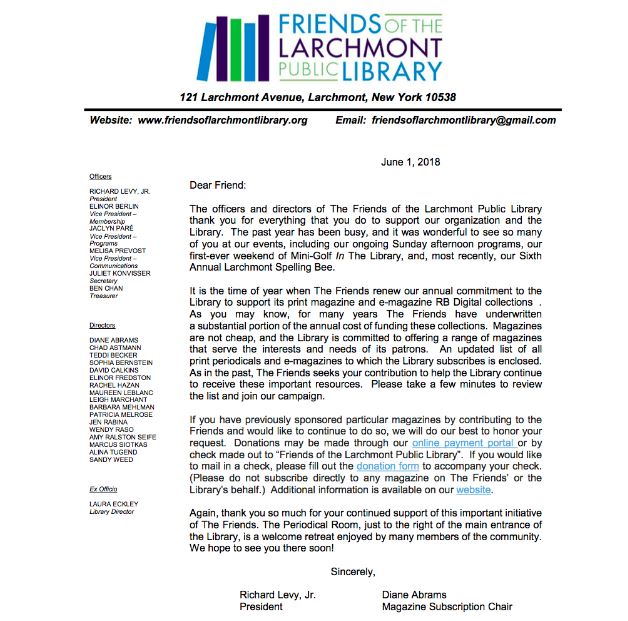
This donation letter receives high marks for its structure, content, and overall appearance. Although this copy doesn’t speak to a specific donor, it does address their past support, current happenings at the library, and the current need. The ways to give are clear and precise, and the letter ends on a very high note, with a solid “thank you.”
Letter #2: Save the Children
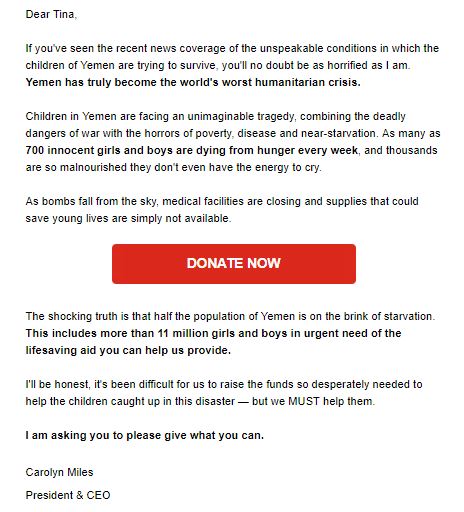
This email is stellar because it follows a traditional donation letter format, but appeals to someone reading an email (as opposed to a physical letter). It begins with an informal yet personal salutation, speaks to a timely world issue (bonus!), mentions their need, the solution, and concrete ways the organization is helping, a direct call to action, and a personal plea. Finally, it’s signed by a person. It’s easily absorbable, personal, and timely.
Best Practices To Write Request Letters That Wow Donors
I know that there are many things to keep in mind when it comes to crafting engaging donation letters. To guide your writing, follow these four essential best practices:
- Be Conversational & Ignore Jargon: You understand your internal lingo, but your donor may not be as comfortable with nonprofit jargon. So toss those “collective actions,” “synergizing,” and “alignments” aside, and opt for something more human and personal. Write your letter as though you’re speaking to someone face-to-face.
- Track Your Data: Record metrics like response rates from your donors. This donor data can help you improve your letters and timing for campaigns down the road.
- Add Extras: Set your nonprofit up for success later on through fundraising “extras.” These include asking your donor to consider setting up a recurring or monthly gift . Also, you can invite donors to participate in the campaign by sharing your fundraiser with their network or launching their own fundraising initiative on your behalf.
- Make it Easy to Donate: After reading your letter, potential donors should know exactly how they can contribute to your cause, whether it’s by filling out their credit card info and mailing it back or contributing via your online payment system.
Bringing It All Together
Donation letters need plenty of TLC, but do you know what the best part of the writing process is?
Once you write a solid donation letter template, you can build on it for all your future campaigns.
There’s no time like the present to perfect your donation letter and stand out among the crowd. You’ve got this!
Ready to elevate your fundraising software next? Check out this article: How to Fundraise in 13 Steps: Why it Matters + The Software You Need

Related Fundraising Articles

Donor Engagement Strategies to Level Up Your Nonprofit + Donor Engagement Plan Checklist!

How to Get Funding for a Nonprofit: Tips on Tapping into 12 Top Funding Sources

How to Step Up Your Donor Cultivation Strategy: 14 Useful Ideas
The Membership Growth Report:
Benchmarks & insights for growing revenue and constituents.
Platform Overview
Learn how Snowball’s effective and customizable fundraising tools make raising money easier.
View All Features
Snowball 💜s Churches
Learn how to grow your church, engage your members and sustain your mission.
- Accept Donations
- Donation Forms
- Fundraising Pages
- Text-to-Give
- Fundraising Events
- Tickets & Items
- Text-to-Bid
- Storefronts *New*
- Recurring Donations
- Custom Branding
- Supporter Feed
Secure Payments
- Contact Management
- Donation Management
- Ticket Management
- Importing & Migration
Design Services
- Email Blasts
Snowball Resource Center
Browse our library for articles, how-tos and guides on effective fundraising for nonprofits.
Full Resource Library
Featured Articles
Text-to-Give Guide
Charity Auction Websites
Auction Software
Fundraising Topics
- Best Practices
Featured Services
Donor Engagement
Fundraising Campaigns
Text-to-Give Fundraising
Take a Tour
Schedule a walkthrough with our team and learn how to maximize your fundraising.
Writing a Donation Letter: 10 Example Templates & Pro Tips
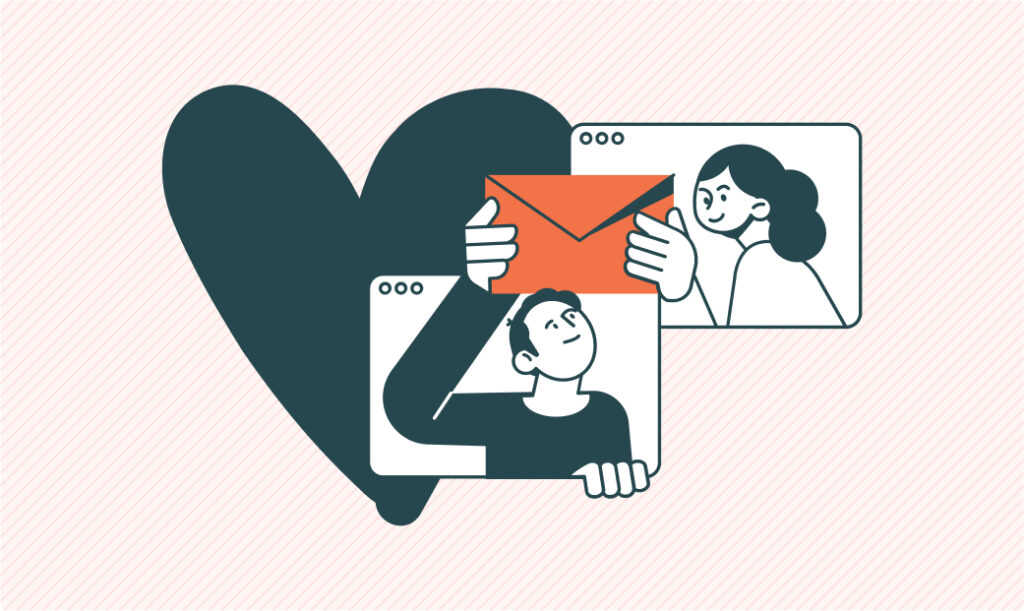
- July 21, 2023
- Snowball Fundraising
Even in the digital age, a donation letter is still one of the most direct and effective ways to raise money for your cause.
That’s because donation letters are such a flexible strategy – whether they’re direct mail appeals or email messages, tailored to a specific campaign or event, or asking for more general support. You can’t really go wrong with a well-written, concise appeal for donations.
We’ve written before about how to create the perfect donation page , the actual place on your website where you’ll accept online donations. But how do you promote it to potential donors? Or, if you’re mailing physical messages, how do you let supporters know they can find you online or send a check? Reach out with a letter.
Nonprofit fundraising letters are a fantastic way to drum up support and awareness for your cause. And thanks to the plethora of powerful resources available to organizations like yours, you can make the most of this fundraising opportunity while making the most of the time and money put into your own mission.
However, you have to make sure your donation letter stands out. Following a foolproof template is the best way to make sure you’re hitting all the essentials. Then, you can customize and personalize your letter to really catch your donors’ attention.
Let’s walk through common examples of donation letters, starting with a template of the basic format to follow:
- The basic donation letter format
- Donation request letters
- Letters for fundraising events
- Letters for online fundraising
- Letters for pledge campaigns
- Letters for peer-to-peer campaigns
- Letters for sponsorship requests
- Letters for new nonprofits
- Letters for schools
- Letters for churches
Use the list above to jump to a particular letter template, or just follow along with us from the top. We’ll wrap up with a few of our pro tips to make your donation letters as impactful as possible. Let’s get started!
Bonus resource! Once you’ve used these templates to write your fundraising letter, head to GivingMail to use their direct mailing services to get your letters in supporters’ hands! This allows your team to send appeals to the largest number of recipients in the most efficient way possible, allowing you to put your time and money into what matters: your mission.

Donation Letter Templates: 10 Common Examples
1. the basic donation letter format.
Let’s start with the basics. Here’s a template of the essential elements that any effective donation letter will include:
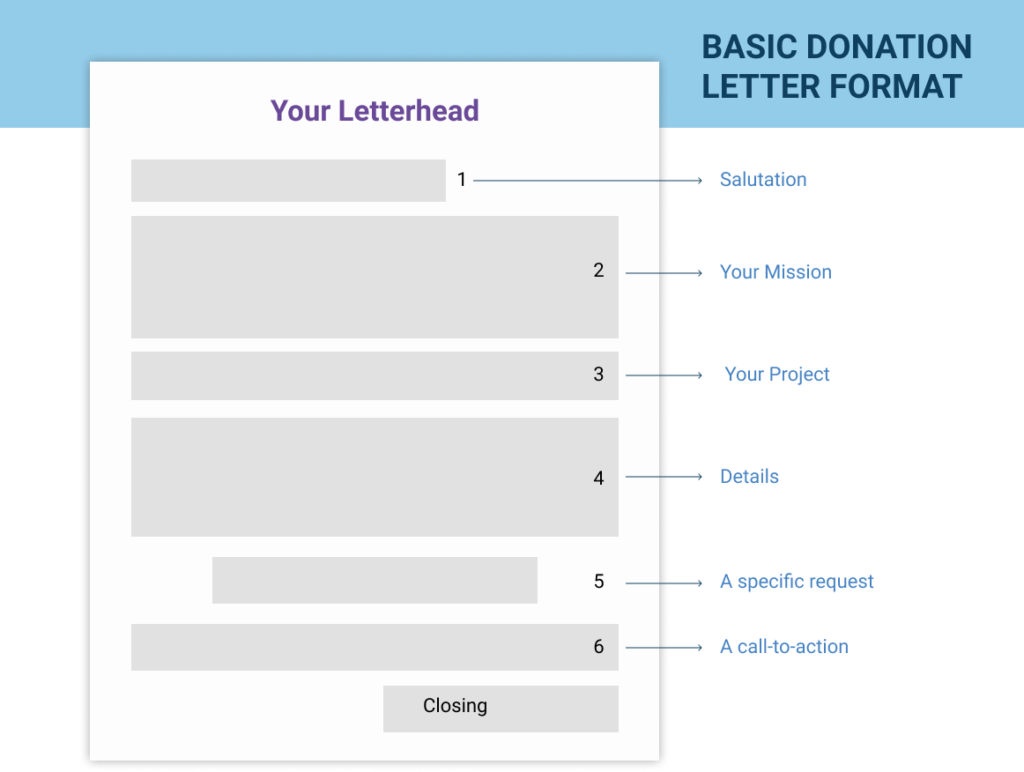
- Salutation. Greet your potential donor with a friendly opening, and personalize it with their name whenever possible. You might need to do this manually, or you can use nonprofit software and marketing tools to automatically populate names into your letters and emails. By including supporters’ names and addresses on your letters, case studies show that you can increase your response rate by 14%, average gift size by 19%, and overall revenue by an astonishing 31.5%!
- Explanation of your mission. If your recipient isn’t very familiar with your organization, a concise explanation of your mission and purpose is important. This is the “hook,” the first place to encourage readers to emotionally connect with your work. If your recipients have engaged with your nonprofit before (whether as current or lapsed donors, volunteers, etc.), this is also the place to acknowledge that.
- Your project, event, or needs. Next, briefly explain what you’re fundraising for. Why are you sending the letter? It might be a specific project or event that needs funding, or you might be conducting a fundraising campaign to raise support for your organization more generally, or you might be sending letters to matching-gift eligible donors to encourage them to submit their match. Whatever the reason, be exact and transparent about it.
- Compelling details. In the middle section, add some compelling details to help illustrate your needs. Describe your project or event and the impact it will have on your community. Provide examples of your past work, or share a story about a particular constituent or campaign. This is where you should focus on engaging your reader emotionally to motivate them to take action.
- A specific request. Next, clearly state your specific request. Your reader won’t feel as compelled to donate if your request is too generic. Ask for a specific amount, but make it clear that any support will be appreciated. If possible, tie your request to a specific impact it will have. For example: “Your donation of $25 will help provide a backpack full of school supplies for a local student in need.”
- A call-to-action. Wrap up your letter with the concrete next steps that you want the reader to take. This will depend on the exact purpose of the letter. For an email, include a direct link to your donation page. For a physical letter, provide clear instructions for readers to send you a check or find your online donation page.
The main idea is to focus your letter around one key goal. Depending on your exact goal for the letter, you may choose to promote your main donation page, recurring gift options , event registration page, or volunteer sign-up form. Never overwhelm your reader with multiple or vague requests.
You just need to ensure you’ve got easy-to-use online fundraising tools set up to direct your readers to. Create a Snowball account to cover your bases with a free online donation page.
By sticking to the essentials outlined in this basic template, you’ll already be ahead of the game and boost your chances of success.
Now, you’re ready to adjust your letter a bit more based on your specific goals, community, or project. Let’s walk through some common examples.

2. Donation Letter Template: Donation Request
Dear [name] , We here at [your organization] are so proud of our recent work to [provide a few details about your past initiatives] , and we’d like to thank you for being a part of our community. However, our mission to [short description of your organization’s mission] is a 24/7 undertaking! We need your help to continue our work. [Provide illustrative details about your needs. Why are you sending them the letter?] Past campaigns have enabled us to [provide an example or two of your organization’s impact] . As a nonprofit organization, though, we completely rely on community support. None of our efforts would be possible without the help of donors, volunteers, and supportive community members like you. Would you please consider making a donation of [a specific amount] to help us [refer back to your organization’s needs or next project] ? If you’d like to make a gift, please visit our donation page here: [if an email, include a direct link] [if a physical letter, provide basic instructions for finding your website or sending a check] Any and all support is greatly appreciated. We’re just excited to get to work! Thank you for being a part of our community and our story. Sincerely, [Your name and title, not simply the name of your organization]
This fairly general donation letter template covers all the bases. It describes your purpose for fundraising, highlights your organization’s impact, and has a clear call-to-action. Customize this template with your own specifics, and you’re good to go!

3. Donation Letter Template: Events
Dear [name] , We here at [organization name] are excited to announce our upcoming event, [event name/title] , coming up on [date] . [In a few sentences, describe the purpose, nature, and impact of the event, including specific activities or special opportunities.] As a member of our community, we’d love to invite you to join us! However, we need some extra help to make sure everything goes off without a hitch. Would you please consider chipping in a donation of [a specific amount of money, or a specific in-kind good/service] ? With this help, we can ensure that [explain the specific impact of the requested donation] . If you’d like to make a gift, please visit our donation page here: [if an email, include a direct link] [if a physical letter, provide basic instructions for finding your website or sending a check] . Or, contact us at [email address or phone number] to discuss our upcoming event and how you can get involved. Thank you so much for your support, and we hope to see you soon! Sincerely, [Your name and title]
Depending on the specifics of your event, you might send this letter to individuals or to local businesses, and you might promote one of several different giving methods (like online donations, text-to-give , in-kind contributions, or volunteering). Adapt the essential components to your particular needs for the event.
However, keep the content of the letter itself focused on one main request. Short and sweet will always be more compelling! Just be sure to tell readers where to learn more or get involved if they want to.

"> "> Take a Personalized Tour
Schedule a demo with one of our fundraising consultants. We’ll show you how the Snowball platform has benefited other nonprofit organizations, and how it can help you.

4. Donation Letter Template: Online Fundraising
Dear [name] , We here at [your organization] would like to thank you for being a part of our community. With the support of our friends and neighbors like you, we’ve been able to accomplish so much over the past year. [Include a few specific details about your recent projects and their impacts.] We’re happy to announce that we’re launching a new online fundraising initiative! This campaign is raising funds for [purpose of the campaign] , and will be essential for us to continue our work into the coming season. Would you please consider making a donation of [specific amount] to help us kick off our campaign? Please visit our donation page [include a direct link] to get started. [Add a button that says “Donate Here,” if possible.] For helping us kick off our online fundraising campaign, we’d love to offer you a special thank you. [Offer some kind of incentive for online donors, like a social media shout out, merchandise coupon, event or raffle ticket, etc.] Stay tuned for more updates on our campaign! Thanks so much for your support, and we hope to hear from you soon. Sincerely, [Your name and title]
While the other templates in this post can be adapted for both email and physical donation letters, this one is intended to be sent as an email.
For an online fundraising campaign, your recipients will most likely all have donated to your organization (or at least engaged with it) via online channels in the past. This means your letter should start off by acknowledging that existing relationship.
Express excitement about your newest online fundraising push, and use a clear CTA, like a button, to funnel readers directly to your donation page. Get creative to incentivize early-bird donors, too! If you know that some of your donors are matching-gift eligible, include information on how to access a matching gift database and complete their match for your nonprofit.
These kinds of extra steps can go a long way to boost engagement and help your online fundraising campaign stand out to busy supporters.

5. Donation Letter Template: Pledge Campaigns
Hi [name] , We need your help to reach our pledge goal of [total financial goal for the campaign] by [a specific time and date] ! We’ve launched this rapid-fire campaign to [purpose of the campaign – disaster relief, social or political advocacy, annual fundraising, etc.] , and we know we can count on our community to help us get there. At [your organization], we work hard every day to pursue our mission of [your mission] , and our last major campaign resulted in [examples of your impact] . We could never have done it without the support of our friends and neighbors like you. Pledge your support of [one or a few specific dollar amounts] now with our quick pledge tool: [provide a direct link to your pledge tool] Please note: [Explain the unique pledge conditions of your campaign, like triggers or matching periods] . Together we can make a huge difference in our community! Thanks in advance for your support! Be sure to share our fundraising challenge with your friends and family, and feel free to get in touch if you have any questions. Sincerely, [Your name and title]
Pledge fundraising campaigns are a unique way to raise support around a specific goal quickly. Check out our complete guide to pledge campaigns here for more information, including explanations of the pledge conditions mentioned in the template.
No matter the specifics of your pledge campaign, the main idea is to be short and to-the-point. These campaigns are all about speed and quick emotional connection. Remind readers of why the work you do is important, and then challenge them to get involved. You can collect the pledges later , but your goal right now should simply be to mobilize support.

6. Donation Letter Template: P2P Fundraising Campaigns
Hi! I’m raising money on behalf of [your organization] ‘s ongoing campaign to [support/fight/raise awareness for your mission] . For [your organization’s age] years, this organization has pursued its mission and enriched our community. Now, I’m excited to be lending my own support to their cause, and I hope you’ll join me! To reach my own personal goal for this campaign, I need to raise [the volunteer’s fundraising goal] . Would you consider making a donation of [a specific amount] or helping me to spread the word online? Check out my donation page here [include a link to the volunteer’s P2P donation page] to make a contribution or to learn more about [your organization] . [Include any information here if your P2P campaign involves events, like festivals, 5Ks, etc., and how donors can register to get involved.] This cause means a lot to me, so thank you for your support! [The volunteer’s name]
Peer-to-peer fundraising campaigns involve your supporters raising money on your organization’s behalf by setting up their own basic donation pages and then promoting them online to friends and family. You’ll need to provide supporters and volunteers with a template like this one to make it easy for them to hit all the essentials in their donation requests, social media posts, and emails.
Make sure your template mentions a specific fundraising goal and includes links back to the volunteer’s donation page, not just your organization’s website. The main idea is to empower and engage your supporters. After all, these campaigns are effective because the audience will feel compelled to support their loved one’s passions, not necessarily to support your organization that they may not have heard of before.

7. Donation Letter Template: Sponsorship Requests
Dear [name] , My name is [your name] , and I work for the local nonprofit organization, [your organization] , as a development and fundraising professional. If you haven’t heard of our organization, we work to [short description of your mission] , and we’ve [brief examples of your impact over recent years] . In fact, last year we raised upwards of [fundraising total] in support of our cause. I’m reaching out today because I believe the values and priorities of our two organizations align very well. A partnership could greatly benefit both of us, with more stable support for our work and extremely positive promotions of your brand to our loyal audience of supporters. Please feel free to explore our organization’s history and work here [include a link to your website] , and don’t hesitate to get in touch at [your email address or phone number] . We can discuss arranging a structured partnership, a one-time donation, or anything else! We’re always excited to work with new partners in the community, and we hope you’ll join us! Best wishes, [Your name and title]
This donation letter template is a bit more formal because requesting a sponsorship from a business (of any size) is really like arranging a partnership. You need to offer the business something in return, usually positive publicity at your events or online, for them to consider making a sizable gift.
Here’s a pro tip for identifying potential sponsors: Implement a matching gift search tool into your donation process, and look out for local businesses that have corporate philanthropy programs and employ a ton of your donors. Check out the Mercy Corps matching gifts page for an idea of what this looks like in action.

8. Donation Letter Template: New Nonprofits
Dear [name] , We’re [your organization] , a brand new nonprofit organization in your community. We were founded just [your organization’s age] ago to help support and lead [your mission] in [your city, town, or state] . We’re reaching out to you as a neighbor with a vested interest in seeing our community thrive. [Be more specific if you’re writing to a particular audience.] But getting a foothold as a new nonprofit is a huge challenge. Raising awareness for our cause and our work is crucial if we’re going to make any kind of long-term impact! Would you consider making a donation of [specific amount] to get us one step closer to our fundraising goal of [total] ? If we reach this target goal before [date] , we’ll be able to [the specific goal of this campaign, like renting an office space or hosting your first event] , and you can help us get there! Please visit our donation page here to get started: [include a direct link] Also, please explore our website [include a direct link] or follow us on social media [include a direct link] to learn more about our mission and the partners who have already joined our cause. Together we can make a difference in our community! Please reach out to me at [email address or phone number] if you have any questions about our organization or how you can get involved. Thanks, and we hope to hear from you soon! [Your name and title]
Brand new nonprofits have a few major challenges ahead of them – securing initial funding , setting up key partnerships, and establishing an original base of support.
Larger grants for startup organizations (learn more about grant writing here ) will most likely make up the bulk of your initial funding, but using letters like this one to find actual communities of supporters is essential in your early days. It’s usually not a good idea to include too many calls-to-action in a single letter, but giving your readers the option to donate, follow you on social media, or just learn more about your organization will cover your bases. Every little bit of engagement and attention counts!
Make sure you’ve got a donation tool set up and a way to track the donations you receive. You’ll want to immediately focus on building relationships with those first donors.

Snowball’s all-in-one fundraising software makes it easy to raise more for your nonprofit.

9. Donation Letter Template: Schools
Dear [name] , [Your school’s name] needs your support! My name is [your name] , and I’m part of the [your role – the school’s PTA, administrative team, teacher, etc.] . Every year, we work hard to provide the best possible educational and extracurricular activities for our students, but we can’t do it alone. Our tight budget has recently forced us to [provide a specific example or two – cut down on afterschool programs, etc.] . But we know we can count on our community to help us close the gap. Would you consider making a donation of [specific amount] to contribute to our fund for [describe your campaign’s purpose or goal] ? A gift of [amount] will allow us to [the specific impact of a donation, tied to the campaign’s main purpose] . Please visit our donation page here if you’d like to get started: [provide a direct link] . Or, reach out to us at [email address or phone number] to talk about our school’s needs and how you can get involved. Don’t forget! Our [your school’s next event, like a fall festival] is coming up soon, and we’d love to see you there! Get your tickets now: [provide a direct link] . Together we can continue making our school an environment of excellence for our kids. Thank you! [Your name and title]
School fundraising is a round-the-clock undertaking! Thankfully, schools are also fairly tight-knit communities, and every parent wants the best for their child’s school. Tap into that shared desire by clearly emphasizing your needs and making it easy for them to get involved. Quickly mention any upcoming opportunities or events, as well.
Use this template to make sure you’re including all the essentials in your next email blast or mailed letter to your community of parents. Then, adapt it to your particular goals, projects, and fundraising ideas .

10. Donation Letter Template: Churches
Dear [name] , [Begin with a story focused on your church’s recent successes, such as growth in membership or your positive impact on the surrounding community. Connect with the individual member by thanking them for being a supportive part of your community.] While we feel blessed to have been able to [refer to successful project mentioned above] , we need your help to [continue the project or pursue a new one] . With your support, we can [your next project or campaign] . Would you consider contributing [specific amount] to help us work toward our mission? Together, we can reach our community’s goals. On behalf of our church community at [your church’s name] , I thank you in advance for your support. Your contribution will go toward [specific elements of your project that need funding] . You can give online here: [include a direct link] . Or, you can use our text-to-tithe tool to give on the go: [include text-to-tithe instructions ] . Feel free to reach out to me at [email address or phone number] if you have questions about our new project. Gratefully yours, [Name of a leader in your church] While they can’t always fundraise the same way as 501(c)(3) nonprofits, churches are community-focused organizations that nonetheless rely on their members, supporters, and neighbors for support. Fundraising letters have always been a powerful tool for church fundraising teams to accomplish a wide range of tasks .
Reach out to your community with a concise, heartfelt letter explaining why you need support. Many churches have found great success with text giving tools in recent years, so be sure to promote that outlet, as well.
This is a fairly basic example, so check out our complete guide to writing church fundraising letters for even more templates .
Writing Donation Letters: Our Pro Tips
At Snowball Fundraising , we help organizations of all sizes get set up quickly with powerful but easy-to-use fundraising tools. Having those outlets ready to actually accept and process donations is essential, but how will you let potential donors know when and how to use them?
Here are a few of our own pro tips for maximizing your success with donation letters:
- Tell a story. The templates above cover the essentials, but you have to emotionally connect with your readers to motivate them to give. Do that by telling a story about your organization, your mission, your constituents, and your needs. Check out this guide to nonprofit storytelling techniques for more examples.
- Include visuals or extra materials. If you’re sending an email, include a picture or two in your message to illustrate your work and community. For physical letters, including a pamphlet, card, or one-pager (especially when you’re promoting a specific project or trying to secure a sponsorship) can be a good idea.
- Think about your audience. Don’t just write a single letter or email to send to everyone on your mailing list. Segment your mailing list into discrete groups, and then tailor your letters to those audiences. For instance, you should write different letters to your recurring donors and to your lapsed donors to really maximize their engagement with your messages.
- Be specific. Throughout the templates above, we mentioned asking for a specific amount of money in each letter. Vague requests are much less compelling for donors. However, this also applies to the type of donation; if you’re looking to increase your number of recurring donors, specifically ask readers to consider setting up recurring donations !
- Be conversational. Again, these letters are all about connecting emotionally, reminding readers of their relationship to your cause, and quickly making a donation request. Avoid using internal fundraising lingo and focus on being personable and warm with your wording. The one exception might be a corporate sponsorship letter, depending on the nature and scope of the partnership you’re hoping to form.
- Track data. This step is critical to ensure your donation letters are constantly improving. Always collect and track some form of engagement data when you send a donation letter. This could be as simple as recording how many donations your physical letter campaign generated. For email and social media posts, it’s a little easier to track a wider variety of data points. Use Google Analytics or a tool like MailChimp to track engagement with your message, and make sure your donation tools make it easy to report data back to your CRM or central data center.
- Partner with a direct mail fundraising company. You might assume that working with a direct mail fundraising platform to send out donation letters is more costly, and therefore detract from your mission. Not so fast! With a powerful and low-cost partner like GivingMail , you can raise more for your campaign for less than it would cost for paper, ink, envelope, and stamps on your own! That way, your own fundraising team can save time and effort for other important tasks.

The Snowball Formula for Successful Modern Fundraising
Before we close out this guide, let’s walk through the Snowball formula for successful fundraising in the digital age. This philosophy guides the development of all of our donation tools:
Don’t kill the donor’s buzz. Donating should be fast and easy, and donors should feel great while they’re doing it. Never slow them down with complicated steps, or you’ll risk distracting them from the spirit of generosity that inspired them to give in the first place. Secure a card to streamline the process. Once you’ve built a relationship with a donor, encourage them to save their card information on file with you. Not having to enter in payment information the next time they want to donate can play a major role in ensuring that they actually will. Promote recurring donations. Recurring donations are the ultimate goal because they represent a strong, sustaining relationship between that donor and your organization. Once you’ve secured their recurring support, you can focus on growing your emotional and philanthropic connections with them.
With these core steps, any organization, large or small, can start building a rock-solid base of support. Be sure to continue your research with a few additional fundraising resources, too:
- Direct Mail for Nonprofits: The Ultimate Fundraising Guide. Sending your donation letters via direct mail is a great way to stand out in the minds of your donors. Learn more about effective fundraising practices with this guide.
- Fundraising Ideas For Nonprofits | Directory Of 75+ Ideas . Looking for more fundraising ideas to promote to your donors? Check out our complete directory.
- 85+ Awesome Church Fundraising Ideas for Your Congregation . We’ve got plenty of fundraising ideas just for churches, too! Bookmark this guide.
- Best Nonprofit Software To Raise Money Fast . Looking to build out a fundraising toolkit on a budget? We’ve got you covered.
If you’re a new nonprofit, getting started with a free Snowball donation page will ensure you’ve covered all the essentials and are ready to start sending those letters!
Get Started Today
Get in touch with us to take a tour of the Snowball platform and find the right fundraising solutions for your nonprofit.
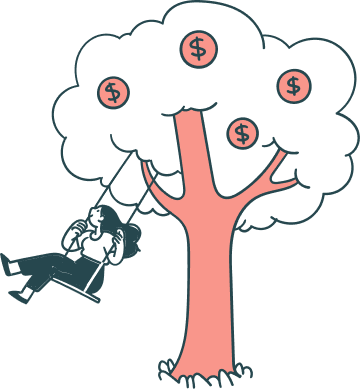
FEATURED SERVICES
Overview Auctions Donor Engagement Fundraising Campaigns Secure Payments Text-to-Give Fundraising
FEATURED ARTICLES
Text-to-Give Guide Charity Auction Websites Auction Software
Blog Pricing About us
Contact Help Center One-Click Login Schedule A Demo Referral Program
Terms of Service
Privacy Policy
Donation Request Letter Templates That Actually Work
Donation letters are an important fundraising tool for many nonprofits. Get the best tips and donation request letter templates that actually work.

Bryan Shanaver
Donation letters are an important source of fundraising for nonprofits , even in the digital age. Whether you’re planning to send physical letters or emails (or both!), donation request letter templates for nonprofits can help you find your voice – and bring in funds for your organization. Read on for the best tips and templates to help you fundraise effectively.
Tips for How to Write a Donation Request Letter
There’s no single formula for writing a donation letter – they should always come from the heart. However, we do have a few tips to help you as you work your way through the donation request letter templates below.
- Start strong . Open your letter with an engaging story about your organization, its mission and how it makes a difference in the world.
- Make it personal . You want the reader to feel compelled to make a donation. Sharing a personal story or a donor story can make a strong connection. Include a picture or two if you can.
- Provide details . If you have statistics about the impact your organization has had, include them. If your fundraiser involves an event, go beyond the date and time to provide information about who will be there and what you’ll be doing.
- Ask for a specific amount . The best charitable donation request letter templates include details about the difference each dollar amount can make. For example, “Just a $25 donation can provide a holiday meal for a family of four.”
- Build trust . Mention your organization’s history and achievements, like awards or partnerships, to build credibility. Donors also want to know their donation is going directly to the cause, so break down where you’ll be using the funds.
- Provide convenient options . It’s best to have multiple ways to donate. If you ask for donations by mail, include a self-addressed envelope. You should also have a fundraising page so people can make donations online. Many nonprofits also accept donations through Venmo or PayPal.
- Give thanks . Showing appreciation for your donors and potential donors is the most important part of any donation request letter template. Even if they haven’t donated previously, you can thank them for their time and consideration.
- Proofread . A well-written, error-free letter makes your organization look professional. Before you hit “send” or put your letters in the mail, have a colleague or another volunteer look it over.
Top 4 Donation Request Letter Templates
Donation letters often include some of the same information, but they vary depending on the request that’s being made. Here are 4 free donation request letter templates for various situations that any organization can use.
1. General Donation Request Letter
This is the most common example of a donation request letter. You’d typically send it to individual donors who aren’t familiar with your organization.
[Organization Name] [Organization Address] [Date] Dear [Name of Donor], Paragraph 1: Introduce yourself and your organization. Highlight your mission and add some statistics about what you’ve accomplished for your cause. Describe what you’re raising funds for and the difference you hope to make in your community. Paragraph 2: Appeal to the donor’s emotions with a compelling story that relates to the donations you’re requesting. It can be an example of a past project or a story of a person you’ve helped. Paragraph 3: Make your donation request. Give specific amounts with examples of how that amount will make a difference. Don’t forget to mention that any amount is appreciated. Paragraph 4: Tell them how to donate. Direct them to the donation website or provide a mailing address for a donation. Better yet, include a self-addressed envelope for checks. Paragraph 5: Thank them for considering your request. Restate that any amount is appreciated and let them know they will make a difference by donating. Sincerely, [Your Name] [Your Title]
2. Online Fundraiser
Online fundraisers are a little different than general fundraising through the mail or your website. Giving them a start and end date can create urgency, and fundraising for something specific can get donors interested. Here’s a sample request for donation letter for an online fundraiser.
[Organization Name] [Organization Address] [Date] Dear [Name of Donor], Paragraph 1: If they’ve previously donated, thank the donor for being a part of your community. Include a specific amount they donated in the past, if possible. Paragraph 2: Introduce (or re-introduce) your organization with a brief summary of your mission. Give an example of a past fundraising campaign and the impact it had. Let them know you couldn’t have done it without them. Paragraph 3: Announce your current online fundraiser. Provide a specific purpose for the campaign as well as a specific goal you’re trying to reach. Give a date when the campaign will end, and let them know you need their help. Paragraph 4: Ask for a donation in a specific amount to help kick off the campaign. Provide the URL of the fundraising website. If it’s an email, add a “Donate Today” button. Paragraph 5: Be sure they know that any amount is helpful. Offer an incentive for donating, like a social media shout out or a raffle ticket if you have an upcoming event. Paragraph 6: Thank them for their support, and direct them to the fundraising website or your organization’s website for updates on the campaign. Sincerely, [Your Name] [Your Title]
3. P2P Campaign
Peer-to-peer (P2P) campaigns are essential for many nonprofit organizations. They allow individuals to raise money on your behalf by setting up their own online donation page. You can send this 501(c)(3) donation request letter template to your volunteer fundraisers to use.
Hi [Name]! Paragraph 1: Introduce the organization you’re raising money for. Include a description of their mission and history, for example, how long they’ve been operating. Paragraph 2: If there’s a specific purpose or campaign you’re raising money for, include that here. If you have a personal story about how the organization has impacted you, include that here as well. Let the donor know how important this is to you and how excited you are. Paragraph 3: Tell them the total amount you’re trying to raise. Ask if they’d consider making a donation in a certain amount, and give an example of how that amount can make a difference. Provide a link to your P2P donation page. Paragraph 4: Include any specific information about the campaign here, for example the total fundraising goal, a date the campaign ends or any events involved, like a 5K or other fundraiser. Paragraph 5: Let them know that any amount is helpful, and if they can’t donate, they can share your page online to help spread the word. Thank you, [Supporter’s Name]
4. Sponsorship Request Letter
A sponsorship letter is a request for a business to sponsor an event you’re holding. For example, they might sponsor a table at a dinner, and receive a placard on the table showing their name and business information. This is a popular donation request letter for schools and teams, as community businesses are likely to get behind these types of organizations.
[Organization Name] [Organization Address] [Date] Dear [Name of Business Contact], Paragraph 1: Introduce yourself, your organization and your mission. Give an example of how you’ve made a positive impact in your community. Describe what you’re raising funds for and the difference it will make. Paragraph 2: Provide some benefits the sponsor will receive if they support you. For example, they might get networking opportunities, media coverage or exposure to a certain audience. Paragraph 3: Describe the details of the sponsorship. Provide a few different sponsorship levels, the donation amount, what they will get, and how that amount will help the community. Paragraph 4: Write your call to action. Let them know how to sign up for the sponsorship, whether by filling out a form and sending a check in the mail, or signing up through your website. Also provide a phone number they can call to get more information. Paragraph 5: Thank them for their time and consideration. If you can, recognize the business by including some details about how they make a positive difference in the community, and thank them for their hard work. Let them know you’re all in this together and their sponsorship will make a difference. Sincerely, [Your Name] [Your Title]
We’ve provided you with our top donation request letter templates that actually work – now it’s up to you to put them into action. Whether you’re writing a donation request letter for a church, school or another nonprofit organization, remember to make that emotional connection and also make it easy for people to donate.
That’s where fundraising sites like Donately come in. Our customizable forms and pages, plus P2P fundraising and features like text-to-donate and recurring donations , can help you reach every donor. And with a variety of pricing plans, including a free option, you can find one that suits your budget. Sign up for free today and start raising money.

What Nonprofits Should Know About Form 8283
Noncash charitable contributions, ranging from artwork to vehicles, offer substantial benefits to nonprofits but require careful handling. This blog provides essential guidance for nonprofits to assist donors in navigating these requirements, ensuring compliance and maximizing benefits.
How to Set Up a Nonprofit Donation Form the Easy Way (2024)
Crafting effective nonprofit donation forms is crucial for online fundraising success. From standard requests to customizable options like recurring donations, tailoring forms boosts donor engagement and fosters ongoing support for your cause.
13 Best Examples of Short Donation Messages
Whether you're collecting donations for a nonprofit, school, sports team or another cause, use these effective, short donation message examples to drive action.
Online Fundraisers: The Basics Every Nonprofit Should Know
Online fundraisers empower nonprofits to reach global audiences, making impactful changes across communities. Embrace digital tools like Donately for accessible, convenient, and cost-effective fundraising.
How to write a donation request letters + 6 sample letter templates you can use
In this article, we’ll cover how to write a donation letter. Use one of our six sample donation request letter templates to help get started.
In the age of social media fundraisers and crowdfunding campaigns, donation request letters may seem old-fashioned.
While they are a traditional form of fundraising, donation request letters are still a highly-effective and popular way to solicit donations. The letter format allows you to speak directly to your potential donors in a personal way, while giving them time to consider the request.
In this article, we’ll cover how to write a donation letter and the basics you need to include.
We’ve also made six sample donation request letter templates you can use for:
- Individual fundraising letters
- Church fundraising letters
- Matching gift donation request letters
- Sponsorship letters
- Volunteer letters
- Thank you letters
How do you write a donation request letter?
Donation letters are a fundraising tool used to reach prospective donors and ask for donations. They can be especially effective when you have a specific campaign or giving day, as it adds an extra level of urgency.
Obviously, the format of your letter will depend on the donor contact information you have. If you have donor mailing addresses, you may want to send a letter. However, if you have email addresses, you can also opt to send your letter out electronically. Always remember to stick to the recipient's preferences too. Physical mail is more likely to be opened, however it is a more costly option. Emails have a lower open rate, but they allow you to link directly to donation pages, videos and photos for a very low cost. Bulk email software also allows you to track open rates, so you can easily resend the email to recipients who didn’t open it the first time.
When you start writing your donation request letter, always think about the potential donors you are writing to. The level of formality will vary if you are writing to a corporation, a student or a volunteer. Below, we have some different examples of donation request letters depending on who you are writing to.
When it comes to the content of the letter, imagine you are the one receiving it - what would make you want to donate? What stories or statistics can you include that really highlight the great work you do? Can you clearly explain what the money, or in-kind donations will be used for, and how many people it will help?
All these factors will determine how effective your letter is at raising funds from your donor base.
Donation request letter template
We’ll go into more specific examples below, but these are the basic elements your donation request letter should have, regardless if you’re sending a physical letter or an email:
- Header: This should show your organization's name and logo.
- Contact information : List your address, phone number, email address, and website.
- Salutation : Always aim to use the prospective donor’s first name, as the letter is more likely to be read if it’s personally addressed. ‘Dear Andrew’ is perfectly fine, or you could opt for a more formal greeting like ‘Dear Mr Jones’ for corporate letters.
- Mission : Explain your organization's mission in a compelling way that captures the reader's attention. You should keep it concise, clarify why you’re reaching out and what your organization has achieved so far.
- Goal : Introduce your current project goal, and how much you are trying to raise to achieve the goal. Feel free to add a photo, or a link to a video, to further highlight your goal and add to the emotional appeal.
- Call-to-action : Add a clear CTA, with an easy way to donate. If you want financial support, link to a donation page, or include your bank details along with a suggested amount. If you are requesting in-kind donations or sponsorship, include further information about what donors will receive in return. Include instructions on how to take the next step.
- Additional information: Any additional information such as tax benefits, volunteer opportunities, or gift-matching days.
- Sign off: Add your signature, job title and name, and thank them again for their support.
1. Individual fundraising donation request letters
The most common type of fundraising letter is the individual letter, sent to supporters, donors or volunteers on your database during major fundraising campaigns.
You might choose to send the letter ahead of Giving Tuesday (the Tuesday after Thanksgiving) or in celebration of a milestone, such as your organization's 5-year anniversary. Remember to personalize the greeting with their name, which you can track using a donor CRM such as Blackbaud .
You could also include a success story and a picture to deliver an even greater emotional appeal and impact.
Dear [Name],
[Start with an emotional story about someone your organization has helped. For example, this week, we are able to feed 500 hungry families, make breakfasts for 2000 school students and rescue over 1 ton of food from landfill]. That couldn’t have happened without your support!
We have only been able to do this thanks to generous supporters like you. That’s why we wanted to reach out to you today to talk about our next ambitious goals and how you can get involved.
[Talk about your next big project and fundraising goal . Give as much detail as possible in terms of how many people it will help, the timeline and how the funds will be spent].
With your support, we know we can achieve our goals. Are you willing to donate? With a gift of [$amount] we will be able to [$impact]. And don’t forget, all donations are fully tax-deductible.
Donations can be made easily via [information on how to donate]. You will receive a donation receipt sent to your inbox immediately.
Alternatively, [include other ways to donate]. Every dollar makes a difference!
You are truly making a difference in people's lives, and we wouldn’t be able to reach as many people as we do without your support. If you’d like to learn more about what we do, and how you can get involved, click on the links below.
- Volunteer with us
- Read our blog
- Follow us on social media
We would be so grateful if you could pass this letter on to three family members or friends so we can smash our goals and help even more people!
Thank you very much.
[Signature]
[Job title]
2. Church donation request letters
Churches rely on the generosity of their congregants to keep the doors open and the lights on, so fundraising is an essential year-round activity. On top of the regular in-person collections, fundraising letters can be used when you have a specific fundraising effort - such as the restoration of a building, a mission trip, or an upcoming event or raffle.
You may choose to send fundraising donation request letters exclusively to your church congregation or to the wider community.
Church Name
Greetings! We hope this letter finds you well and that you’ve had a relaxing, blessed holiday season. As an important member of our wonderful congregation, we wanted to keep you up to date with our big plans for the year ahead.
As we continue to welcome new members to our church family, we have felt the need for more space and events to accommodate everyone comfortably.
We are now in the early stages of planning the renovation of the hall in the churchyard. This will enable us to host events on-site such as kids club, wedding celebrations, and morning teas.
The expected costs of the works are [$amount] and are expected to be completed by [date].
We will be hosting a number of special fundraising events to pay for the works.
The first one is a morning tea next Sunday 10th September at the church.
[Further details about event]. Admission is [$amount] for adults, and [$amount] for children under 10.
We look forward to seeing you there, and sharing this exciting project with you over the coming months.
As always, have a blessed day. We hope to see you Sunday!
Good wishes,
[Pastor’s Signature]
[Pastor’s Name]
3. Matching gift donation request letters
These are emails sent to your donor base after they make a cash donation, to encourage them to check if their company offers a gift matching program.
Gift matching is a form of corporate giving that many large organizations use to encourage employees to give to their favorite charity (similar to volunteer grant programs ). After they’ve donated individually, they can submit a form to HR, and the company will then also give the same amount - essentially doubling the donation.
Dear [Donor name],
Thank you for your recent donation. [Talk about how the donation will be used].
To make your donation go even further, check to see if your employer has a matching gift program. If they do, your donation may be instantly doubled!
We’d be so grateful for any extra support.
Click here [link] to access all the information you may need to apply..
If you have any questions, please don’t hesitate to get in touch with us at [contact email or phone].
4. Sponsorship request letter
Sponsorship letters are used to find potential sponsors that may be willing to become a sponsor for a certain event or project, in return for marketing and promotion during the event.
As well as writing a letter, you should also create a sponsorship document that goes into detail about what sponsors will receive at each sponsorship level. This can then be attached to the letter.
Dear (Name, Position, Organization),
[Start by introducing yourself. Share a compelling story about what your organization does and the impact you have made so far in the community. For example, this week, we are able to feed 500 hungry families, make breakfasts for 2000 school students and rescue over 1 ton of food from landfill].
We are getting prepared for our annual event [event name] on [date] at [location]. Last year’s event was such a huge success thanks to our generous sponsors and donors that we were able to raise [$amount] and [specific accomplishments you used the money for].
This year we’re hoping to raise even more! Our goal is [$amount], and we would love you to come aboard to help us reach that goal.
As a corporate sponsor, you’ll be able to help us achieve our goal of [goal].
In return, you will receive the following incentives and recognition:
Gold level, $2000+: [list perks]
Silver level, $1000+: [list perks]
Bronze level, $300+: [list perks]
All sponsors will be listed in our event program and a link to your website will be added to our event page.
We’re accepting cash donations as well as in-kind donations of goods or services for our charity auction. Any donation would be greatly appreciated.
We’ve attached a Sponsorship Pack so you can find out more about becoming a corporate sponsor. If you’re ready to make a donation, [instructions].
Want to learn more about what we do, and how you can get involved? Click on the links below.
Thank you in advance for your generosity. Please don’t hesitate to contact me directly at [phone number] or [email] if you have any questions.
5. Volunteer call out request letters
Along with donations, volunteers are the other major resource that non profits are constantly seeking. Research shows that volunteers are likely to also be donors, so tap into this trend by placing a call out for both. A volunteer call out letter can bring you both vital funds and new supporters!
[Start by sharing a compelling story about what your organization does and the impact you have made so far in the community. For example, this week, we are able to feed 500 hungry families, make breakfasts for 2000 school students and rescue over 1 ton of food from landfill].
As a valued supporter of [organization name], we wanted to get back in touch to share some news. [Talk about your next big project and fundraising goal. Give as much detail as possible including how many people it will help, the timeline and how the funds will be spent].
This year we’re hoping to raise even more! Our goal is [$amount].
Donations can be made easily via [information on how to donate]. You will receive a donation receipt sent to your inbox immediately. Every dollar makes a difference!
We are also seeking volunteers to help strengthen our existing team of [number] volunteers. We have a range of specific roles we are recruiting for, as well as seeking volunteers to help out on event day.
If you’re interested in finding out more about becoming a volunteer, click on the volunteer role descriptions below.
Our volunteers are truly making a difference in people's lives, and we wouldn’t be able to reach as many people as we do without them. Learn more about the benefits of volunteering here [link to volunteers page/video].
6. Thank you donation letter
At the end of the campaign, review your progress and the amount raised. Can you track the success of your letters? Did you achieve your goals?
If so, make sure to include that information in a thank you letter to all donors. Remember to highlight the amount of money raised, how it will be spent, and what progress you’ve already made towards achieving your goal. This will make donors feel appreciated, and encourage them to donate again in the future.
[Start with a compelling story about someone your charity or non profit organization has helped. For example, this week, we are able to feed 500 hungry families, make breakfasts for 2000 school students and rescue over 1 ton of food from landfill]. That couldn’t have happened without your support!
Thank you for your recent generous donation of [$amount]. In total, we raised over [$amount], smashing our fundraising goal of [$target], which was simply incredible! Over the coming months, we will [detail plans on how the funds will be used].
You are truly making a difference in people's lives, and we wouldn't be able to reach as many people as we do without your support. If you’d like to learn more about what we do, and how you can get involved, click on the links below.
We will be sharing regular updates on our website and social media pages, so keep an eye out to see the impact your donation is making.
Hopefully you’ve found these fundraising donation request letters useful, and you can use them as a starting point for your next successful fundraising campaign. Keep reading more about fundraising on our blog:
- 25 Easy Virtual Fundraising Ideas
- 10 Important Steps to Planning a Fundraiser
- GivenGain-Rosterfy partnership lets charities combine volunteering & fundraising
About Rosterfy
Rosterfy exists to connect communities to events and causes they are passionate about through volunteer and paid workforce management technology. Our proven end to end technology allows charities, events and organizations to recruit, register, screen, train, manage and report with ease, replacing manual processes with automations to better engage and retain your volunteers and paid staff.
Similar posts
How to write thank you letters for a donation.
Take a look at what makes a good thank you letter for a donation or use one of our provided templates to help get you started.
How to write a donation request letter
Streamlining the donation process and generating interest is essential to organisation continuity. Here’s how to write a donation request letter from...
What is an in kind donation, and can you accept them?
What is an in kind donation? In this article we cover who can accept in kind donations, how to report and record them as well as the pros and cons.
Join our Newsletter Mailing List
Be the first to know about new Volunteer Management insights, news and feature updates to Rosterfy.
Your Guide to Effective Fundraising — How to Write a Donation Letter for Nonprofit Organizations
- Testimonials
Donation requests are core fundraising strategies and techniques for most nonprofits, but how you ask for support makes all the difference in your success. Letters make an impact by connecting with the reader, sharing the importance of your cause, and providing a direct, simple route for offering support.
You don’t have to be a prize-winning author to write an effective donation letter for a nonprofit organization, but you will need planning and a dash of creativity. This guide will walk you through the structure of a donation letter and tips for personalization, follow-up letters, and corporate recipients.
Structuring and Writing Your Donation Letter
A donation letter’s fundamental structure should be familiar if you’ve written other letters. Follow these steps for writing and using donation letters.
1. Define Your Purpose
Before writing anything down, determine what you want to accomplish with this letter. Consider factors like these.
- Type of donation: Are you looking for money, time, or in-kind donations? Knowing what you want can help you include more relevant details for your readers.
- Purpose of donations: Do you have a specific goal, such as funding an event or campaign, or are your fundraising efforts more generalized?
- Format: Emails are an affordable way to target specific audiences and reach many people, but direct mail offers a sense of intimacy that many appreciate.
- Length: The best donation letters are usually short and sweet. You might use a longer letter for an extensive campaign, but people typically prefer concise, easy-to-read content.
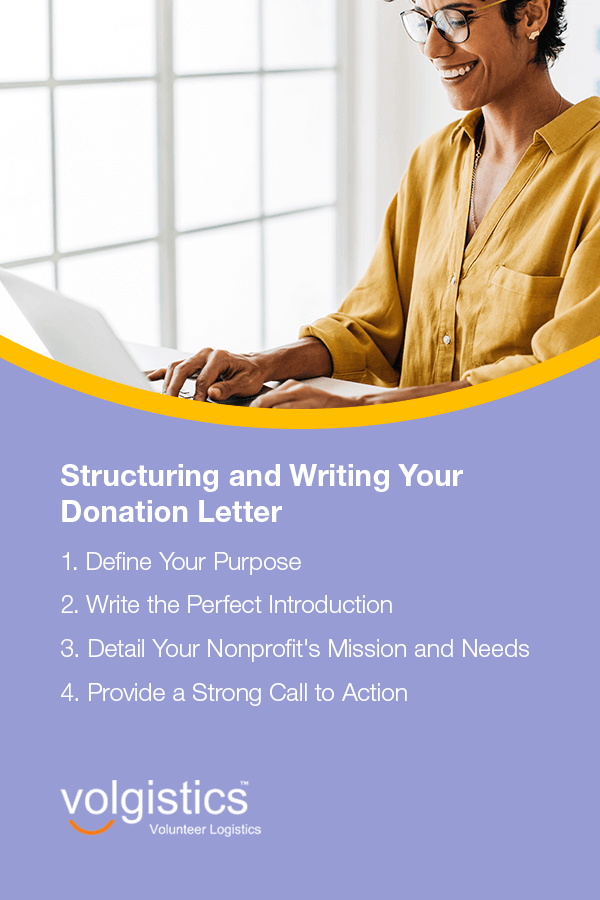
2. Write the Perfect Introduction
Once you know your goals, start crafting a stellar introduction. Focus on grabbing your readers’ attention with a hook. Some common approaches include using a question , quote, statistic, or story. Whatever method you use, try to make an immediate connection with humanistic, conversational language.
Two other elements to consider at the start of your letter include your salutation and subject line, if you’re sending an email. Use these to grab the reader’s attention, but be careful to avoid spammy-sounding language.
For your salutation, create a friendly greeting personalized to your reader. Many platforms can help you automatically populate an email with names from an imported spreadsheet or mailing list. Including the reader’s name rather than a generic “Dear Donor” greeting helps show that you see them as a person, not merely a source of funds.
3. Detail Your Nonprofit’s Mission and Needs
Next, tell your reader what you’re working on. Concisely describe your organization’s general goals and the project at hand. If you’re writing to a previous donor, this section is a good place to thank them and acknowledge their support.
After laying the groundwork, drive home the impact of the reader’s donation. Let them know the value of their time, money, or items, and explain how you used it. Share stories of people you’ve supported or describe your last campaign. Aim to create an emotional connection with the reader and tell them how you will use their donation to make an impact.
This part of the letter is your chance to tell a compelling story and connect with your audience. Pictures and videos can beautifully convey your impact by showing readers what your work looks like in action. Remember to emphasize how donations make it possible.
4. Provide a Strong Call to Action
This last component of your letter should make it as easy as possible for readers to donate. Provide an unmistakable, concise call to action that tells them what you’re looking for and shows them how to support you. You might ask for a specific dollar amount and provide a link to an online donation tool, or ask them to volunteer for only a few hours a week.
Providing a specific donation suggestion makes the process easier, since it reduces the decision-making the recipient must do. Instead of wondering if $20 is enough or thinking about the best way to donate, they can click a link and send money online.
Don’t forget to include a reminder that your organization appreciates any amount. The suggestion should make donating easier without discouraging smaller amounts. You can even offer choices, such as “Give $5,” “Give $10,” and “Give $15.” Research shows that this request style increases contributions by simplifying decisions.
If you’re sending out mailers instead of emails, you may need to provide more specific instructions, such as telling people to visit a URL or providing a mailing address for checks. You can also use a QR code to create and print an image users can scan with their phones.
How to Personalize Donation Letters to Increase Success Rates
A few personal touches can put your donation letters over the top. An easy way to personalize your donation requests is to segment your audience and send letters to people in specific categories. For example, you might send one letter to people who have never donated and another to thank recurring donors for their ongoing support.
Some ways to segment an audience include:
- Recurring versus one-time donors
- First-time versus high-amount donors
- Volunteers versus the public
- Preferences for email versus physical mail
The Importance of Personalization For Non-Profit Organizations
Personalization can boost donation rates by making readers feel more connected to your organization. One of the easiest ways to personalize a letter is to add the recipient’s name, but you can also mention their previous interactions with your company. You might tell a frequent donor how much you appreciate their contributions or share with a volunteer how helpful their work has been.
People get donation requests from many organizations. Personalization can help you stand out by making the reader feel valued, boosting their connection to the organization.

Donation Request Letter Template for Nonprofits
Below is an example of a personalized donation letter for nonprofit organizations, written for previous donors:
Dear [donor name] ,
Did you know that [provide a statistic or fact about your mission] ? On behalf of [your organization’s name] , I’d like to ask for your support in our mission to [describe your purpose and values] .
Your previous donations have enabled us to [describe one of your organization’s accomplishments from the last year] . We believe your contribution can help us make an even more significant impact. By supporting [your organization’s name] , you will help us [describe how you plan to use this donation ].
Please consider donating [specify an amount] today to directly benefit [name the community you serve] . We accept contributions through [list preferred donation methods or platforms] , and we use every penny effectively and transparently. You can also contribute your time by volunteering. Please contact [name your volunteer manager] at [email or phone number] to get started!
If you have questions about our organization or how we use your contributions, please reach out! We wholeheartedly appreciate your consideration and support. Together, we can build a brighter future for [name the community you serve] .
I sincerely thank you for your generosity,
[Your name] [Your title or role] [Your organization’s name]
Effective Follow-Up Strategies After Sending Donation Letters
Following up with your recipients is essential for getting many potential donors to finish the process. Sometimes, life gets in the way and they forget. Other times, they might be unsure if they want to donate, and your second request seals the deal. Whatever the reason, follow-up letters can transform an email recipient into a donor. Try these tips and strategies for following up on donation requests.
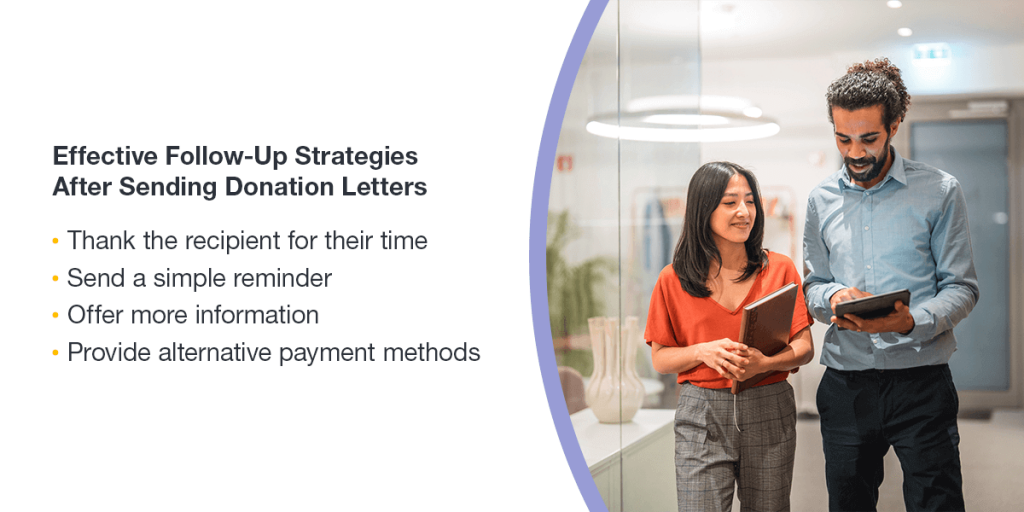
- Thank the recipient for their time: Even if your recipient hasn’t donated, thank them for their time and consideration. This thoughtful gesture shows your appreciation and facilitates a good relationship.
- Send a simple reminder: A straightforward reminder email can keep you top-of-mind and encourage more donations.
- Offer more information: If your reader is still on the fence about donating, an email with more details about your goal, experience, and the donation’s purpose can help convince them.
- Provide alternative payment methods: If you only included one payment option in the first email, you could mention others in your follow-up. More methods, like mailing a check or using a bank transfer, can meet various preferences for security and convenience.
Why Is Donation Follow-Up Important to Businesses?
Following up on requests can secure donations in several ways. As the strategies above demonstrate, they often build relationships, provide reminders, and seal the deal by offering more details or options. These follow-ups can be the crucial missing piece between thinking about donating and taking action.
Sample Letter for a Donation Request Follow-Up
We hope this letter finds you well. We wanted to follow up on the donation request we sent on [date] . Though we haven’t heard back yet, we know you may have other commitments and priorities and thank you for your time.
[Your organization name] sincerely appreciates your consideration and wanted to express our gratitude for your support over the years. Your donation could make a meaningful impact on [name the community you serve] . We hope to use these funds to [describe your goal in more detail] .
Please reach out to us if you have any questions or would like more information on our mission! While we offer convenient payments through [preferred payment method] , we can also take contributions through [other payment methods, like bank transfers and checks] .
Thank you again for your time and consideration. We hope we can count on you to help us [briefly mention your goal] !
Warm regards,
How to Write a Donation Letter That Appeals to Corporate Sponsors
Sending donation letters to businesses requires a different approach than writing to individual people, and corporate sponsorships can be hefty . Understanding this distinction can help you craft the best sponsorship letter for your event.
Understanding Corporate Sponsorship
In a corporate sponsorship, a business offers a donation in return for advertising during an event, such as their logo on your banner or “brought to you by” messaging in other materials.
You can ask for sponsorships in a few different ways. There’s always a classic monetary donation, which can be an amount that covers a specific component of the event, like a food stand or renting a venue. Another option is to ask businesses to donate their time, services, or equipment. Some companies send their team members to volunteer at an event, while others might give their products or services. For example, a restaurant could offer catering.
However they support your event, corporate sponsors usually want to hear about how their donation will help the business bring in customers. Your messaging should address this need by providing insight into how many people might be there, where you’ll display their name and logo, and other perks you can offer.
Another factor to include in your letters is how your mission aligns with the sponsor’s. Many businesses like to sponsor groups with similar goals. For instance, an IT firm might be a good fit for an event focused on girls in STEM. Do some research before talking to corporate sponsors to find out where your goals align, and work that angle into your donation letter.
Crafting a Letter for Corporate Donors
A corporate sponsor letter is fundamentally similar to a donation request for an individual. When asking for the sponsorship, be clear and concise and include details about how it will work and what kind of donation you hope to receive. If you’re writing to a company that’s donated before, be sure to thank them in your letter.
Sample Corporate Sponsorship Request Letter
Here is a sample letter for requesting a corporate sponsorship:
Dear [corporate contact] ,
[Company name] works hard to [describe the company’s area of work that aligns with your organization’s mission] . We genuinely admire your reputation for [name the cause or industry the company supports or mention their commitment to philanthropy] . We’re hosting a [name your event] soon, and feel that a partnership with [company name] would be mutually beneficial, allowing us to make a significant impact in [name the community or cause you serve] .
Our long history with [your cause] has led to [name your accomplishments or mention prior events held] . We’re now looking for a corporate sponsorship to help us [describe how your organization would use the donation, such as programs or supplies it would fund] . With your support, we would be proud to [describe or list sponsorship benefits, such as logo placement, event participation, and media exposure] .
By partnering with [your organization’s name] , [company name] can demonstrate its commitment to social responsibility and help us achieve [state your specific goals] . We’d love to discuss the opportunity further and address any questions or concerns you may have. Please see the attached sponsorship proposal, which provides more details about our organization and the specific benefits of partnering with us.
Thank you for considering our request. We look forward to the possibility of cooperating toward a lasting, positive change for [name the community you serve] .
Maximize the Effects of Your Donation Requests
Donation requests can be daunting, but they’re essential to modern fundraising. These strategies, techniques, and sample letters for donation requests should prepare you to write an attention-grabbing letter that gets you closer to reaching your goals.
Remember to include all types of donations in these letters, as many people overlook the possibility of volunteering or in-kind giving. As you add volunteers to your roster, try Volgistics, a volunteer management program that makes it easy to schedule, communicate, and track volunteering activities. Learn more about our platform today!

- Feature Updates
- Tip of the Week
- Volunteering
Recent Posts
- Why You Need a Volunteer Onboarding Process
- Scheduling Qualified Volunteers
- 9 Ways to Motivate Busy People to Volunteer
- Finding and recording volunteer absences
- New Feature: Scheduling Qualified Volunteers
Organizations Served
Leaders Benefiting
Volunteers Tracked
Features | Tour | Clients | Try or Buy | Pricing | Blog | Contact Support | Login
Testimonials | About Us | Contact Us
- Skip to primary navigation
- Skip to main content
Online Fundraising for Nonprofit Organizations
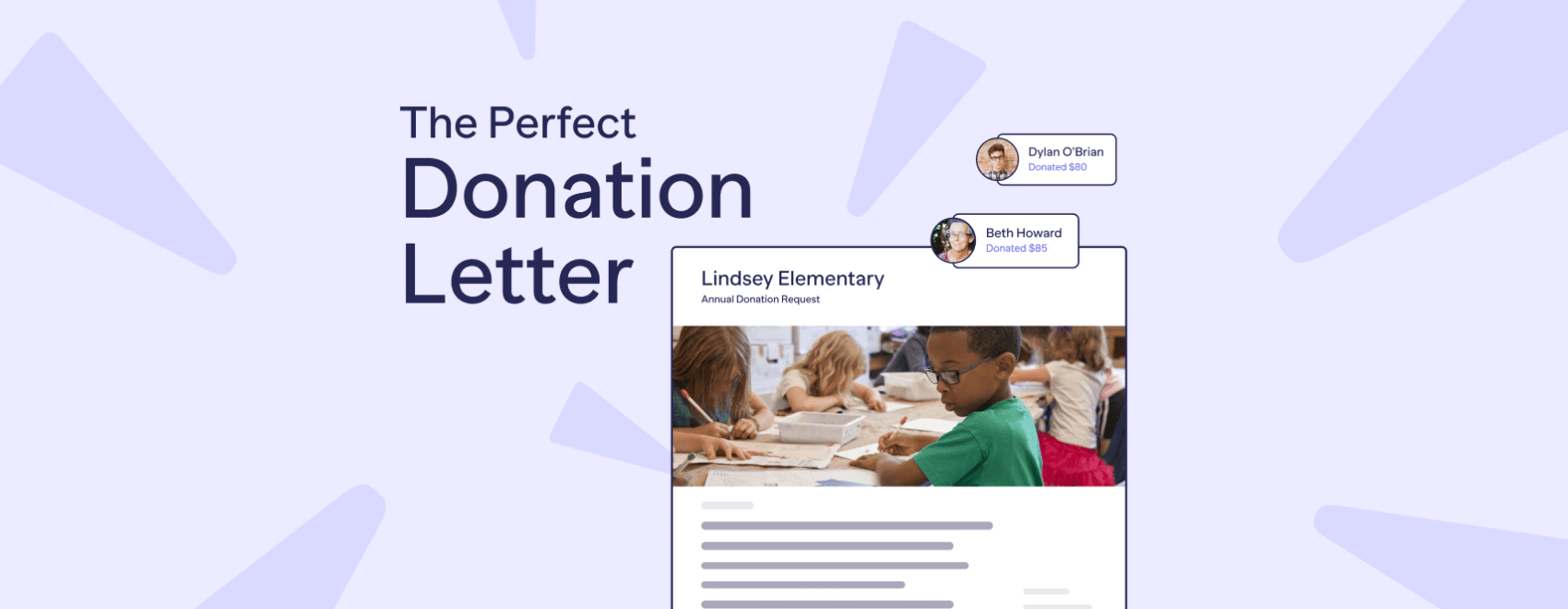
Fundraising , Operations By Evgeny Redjebov | 19 min read
How to Write a Donation Letter That Inspires Giving
When your organization relies on donations to fulfill its mission, writing a donation letter that inspires donors to give is vital. If you’re new to writing donation request letters or just want to brush up on your skills and make sure you’re writing the best donation letter possible, this article is for you. In this article, we’ll explore several topics, including:
- What is a donation letter?
- What should a donation letter include?
- Who should you send donation request letters to?
- When should you send donation request letters?
We’ll also provide a perfect donation letter template and several examples of donation request letters that inspire major giving. Let’s jump in!
What is a Donation Letter?
Put simply; a donation letter is a letter you send from your organization to potential donors that is designed to solicit donations. While donation letters should be personalized to the organization and should be written in a way that authentically represents the mission, vision, and personality of your organization, some key elements should be present in every donation request letter to ensure they are as effective as possible.

What Should a Donation Letter Include?
Your donation request letter should be easy to read, be written in a clear and pleasant tone, and get your donors excited about giving. To write an effective donation letter, be sure that each of the following elements is included.
A Personalized Greeting
The start of your letter should include a friendly greeting. This greeting should be as personalized as possible. You can include the potential donor’s name and any details you may have about their relationship to the organization, such as if they are a former or current donor or volunteer. If they are new to the organization, you can simply greet than as someone who is passionate about the issue your organization is working to address.
Some examples of effective greetings include:
Greetings Kiara, As a former volunteer with the community food bank, we know that you’re as passionate about food justice as we are.
Hello Kevin, As an ongoing donor with the youth literacy project, we know that getting kids engaged with books is important to you.
Greetings Mandre, As a community member in Evergreen Lakes, we know that you want our community to thrive.
Basic information about your organization and mission
While you don’t want to bore your potential donors with a timeline of all your organization’s projects and accomplishments over the years, it’s important to provide some basic background information that will ensure donors know that you are a credible organization with a track record of success. This section should be no more than a few sentences long. Still, it should include any impressive facts or statistics that show that your organization is making a difference in the community.
Some examples of basic facts about an organization and its mission include:
At the Community Food Bank, we’ve been helping families keep food on the table for over 50 years. In the last year, we’ve provided over 10,000 meals to local families that would otherwise have gone without.
The Youth Literacy Project has been a foundational piece of youth academic support in our county since it was founded in 2010. With over 10,000 books provided to classrooms serving kids in the lowest income zip codes in our region, 50,000 volunteer hours focused on youth literacy, and 25 high-quality, expert lead professional development sessions for educators, we know we’re making a difference.
The Evergreen Lakes Conservation Society we’ve been hard at work preserving the natural elements that make our community special for the past 11 years. Through our local breeding program, we’ve increased the natural turtle population by 30%, the blue salamander population by 12%, and the native bird population by 5%. We’ve also restored natural habitats, educated our community on safe waste disposal practices, and helped children in our local schools find beauty in the great outdoors.
Your current project or priority
Donation request letters are most effective when they are focused on a specific project or priority. While many donors are often willing to give to your general expense or operational fund, the donors you’ll be soliciting through a donation request letter will want to know exactly what project they are giving to and why.
Some examples of information about a current project or priority include:
While providing meals to families has always been a priority, we’ve learned from school leaders and lead social work agencies that many kids are going hungry when they’re home from school. That’s why we’ve launched the brand-new Weekend Meals Program.
New research has underscored what we’ve always known at the Youth Literacy Project: that the first three years of life are vital to a kid’s brain development and lifelong achievement. With a grant from the National Council on Youth and support from generous donors like you, we’ll be launching the Youth Literacy Project’s Baby Steps Initiative this fall.
With the success of our local breeding programs, we know that the wildlife we’ve helped bring back will need our support to thrive. That’s why we’re raising funds to create a permanent nature preserve right here in Evergreen Lakes.
Gripping details
Your donors need to know why this specific project or initiative is urgent. It can be helpful to share what inspired you to launch this new project or focus on this new initiative and how you envision your organization making a difference in the problem you present. This section should include any information that will help donors feel personally connected to your mission and project.
Some examples of gripping details include:
Right now, over 50% of students in our community rely on free and reduced lunch during the school week. This means that their family cannot provide funds to purchase a standard school lunch. Studies show that these students are likely to face food insecurity at home and that many do not have access to nutritious food when they are not at school. Because we know that brain development, physical growth, and the freedom to pursue interests beyond those necessary to meet basic needs are all dependent on having access to adequate nutrition, it’s safe to say that these kids are falling behind their peers and missing important developmental milestones simply because of the meals they miss while not at school.
By the time they reach three years old, high-income children will have heard millions of more words than their low-income peers. They’ll have access to three times as many books, will be read aloud to twice as often, and will have a broader and more complex vocabulary. These disparities set the tone for their academic achievement, and by third grade, low-income youth will score below their higher-income peers on reading and writing assessments. These third-grade scores are often predictive of later outcomes like middle and high school graduation, college attendance, even full-time employment in adulthood.
Each year, the world loses thousands of wildlife species forever. Our nation loses hundreds, and our state and community lose dozens. Once these wildlife species are gone, we cannot bring them back, and until they are gone, we cannot know the impact their loss will have on our ecological systems and food chains. Human interference in nature is almost always the cause of a species disappearance and, last year alone, it’s estimated that eight wildlife species were lost in our region due to illegal waste dumping, overdevelopment of wetlands, and overhunting.
A specific ask
Simply hearing about a problem and what your organization is doing to address it is not usually enough to inspire donors to give. Donors need to know what their money will make a difference, and a specific ask ensures that your donors know exactly what you need from them.
Some examples of specific asks include:
We know that the problem of child hunger is daunting, but we also know that we can make a difference. For just $100, you can provide weekend meals to a child in our school system for an entire year. Your $100 will supply a child with the nutrition they need to grow into their greatest self.
Leveling the playing field between low- and high-income youth is a big task, but we know that our Baby Steps program is going to make a big difference. With just a $50 recurring monthly donation, you’ll provide one child entrance into our book-per-month club, monthly home visits from a trained literacy and development specialist, and access to Parent’s Academy for the child’s primary caregivers. These tools and resources will provide the foundation of support a child will need to reach their fullest potential.
We have the power to help end extinction, but we need your support. The total land purchase cost for the Evergreen Lakes Nature Preserve is $500,000. So far, we’ve raised over $325,000 with $175,000 to go. That means we need just 350 individual community members to donate $500. With a $500 donation, you’ll gain lifetime access to the preserve as well as naming rights to one of the first 350 animals born or hatched on the preserve.
Gratitude
Your donation request letter should always end with gratitude. You can express gratitude for the support your donor has provided in the past, for general support from the community, or for the donation you are anticipating from them. Personalizing your gratitude to include their name can also be helpful.
Some specific examples of gratitude include:
We are so grateful for your past support of the Community Food Bank. Your donations have allowed us to serve families across the region during difficult times in their lives. We look forward to boosting our impact on children through the Meals at Home program and appreciate any support you can provide!
We all want to leave the world a better place than we found it. By donating to the Literacy Projects Baby Steps Program, you’ll be doing just that. Thank you so much for your ongoing support.
The time to act is now. We’re grateful to the community at large for prioritizing the natural all around us and to you specifically for sharing our interest in making sure the world’s wildest species have someone safe to live. Thank you for your continued support. We look forward to seeing you at the preserve!
Who Should You Send Donation Request Letters to?
You can send donation request letters to several different groups, though you’ll want to be sure to tailor them to whichever group you are sending them to. Many organizations find success in sending slightly different letters to individuals and to businesses or corporations and then further segmenting and editing their letters to previous or ongoing individual donors, new donors, previous or ongoing business or corporate donors, and new business or corporate donors.
When Should You Send Donation Request Letters?
Donation request letters can be sent at any time, but they’re most effective when tied to a specific project or initiative. Donors like to see immediate results and to feel like they are a part of something bigger than themselves so, when there is a specific project that needs to be funded, donation request letters can be particularly helpful.
Now that we’ve explored the key elements of a successful donation request letter, let’s look at some examples. These examples provide a donation request template that you can use to craft a successful donation request letter for your organization.
The Community Food Bank Sample Donation Request Letter
Greetings Kiara, As a former volunteer with the Community Food Bank, we know that you’re as passionate about food justice as we are. At the Community Food Bank, we’ve been helping families keep food on the table for over 50 years. In the last year, we’ve provided over 10,000 meals to local families that would otherwise have gone without. While providing meals to families has always been a priority, we’ve learned from school leaders and lead social work agencies that many kids are going hungry when they’re home from school. That’s why we’ve launched the brand-new Weekend Meals Program. Right now, over 50% of students in our community rely on free and reduced lunch during the school week. This means that their family cannot provide funds to purchase a standard school lunch. Studies show that these students are likely to face food insecurity at home and that many do not have access to nutritious food when they are not at school. Because we know that brain development, physical growth, and the freedom to pursue interests beyond those necessary to meet basic needs are all dependent on having access to adequate nutrition, it’s safe to say that these kids are falling behind their peers and missing important developmental milestones simply because of the meals they miss while not at school. We know that the problem of child hunger is daunting, but we also know that we can make a difference. For just $100, you can provide weekend meals to a child in our school system for an entire year. Your $100 will supply a child with the nutrition they need to grow into their greatest self. We are so grateful for your past support of the Community Food Bank. Your donations have allowed us to serve families across the region during difficult times in their lives. We look forward to boosting our impact on children through the Meals at Home program and appreciate any support you can provide!

The Youth Literacy Project Giving Donation Letter Sample
Hello Kevin, As an ongoing donor with the Youth Literacy Project, we know that getting kids engaged with books is important to you. The Youth Literacy Project has been a foundational piece of youth academic support in our county since it was founded in 2010. With over 10,000 books provided to classrooms serving kids in the lowest income zip codes in our region, 50,000 volunteer hours focused on youth literacy, and 25 high-quality, expert lead professional development sessions for educators, we know we’re making a difference. New research has underscored what we’ve always known at the Youth Literacy Project: The first three years of life are vital to kids’ brain development and lifelong achievement. With a grant from the National Council on Youth and support from generous donors like you, we’ll be launching the Youth Literacy Project’s Baby Steps Initiative this fall. By the time they reach three years old, high-income children will have heard millions of more words than their low-income peers. They’ll have access to three times as many books, will be read aloud to twice as often, and will have a broader and more complex vocabulary. These disparities set the tone for their academic achievement, and by third grade, low-income youth will score below their higher-income peers on reading and writing assessments. These third-grade scores are often predictive of later outcomes like middle and high school graduation, college attendance, even full-time employment in adulthood. Leveling the playing field between low- and high-income youth is a big task, but we know that our Baby Steps program is going to make a big difference. With just a $50 recurring monthly donation, you’ll provide one child entrance into our book-per-month club, monthly home visits from a trained literacy and development specialist, and access to Parent’s Academy for the child’s primary caregivers. These tools and resources will provide the foundation of support a child will need to reach their fullest potential. We all want to leave the world a better place than we found it. By donating to the Literacy Projects Baby Steps Program, you’ll be doing just that. Thank you so much for your ongoing support.
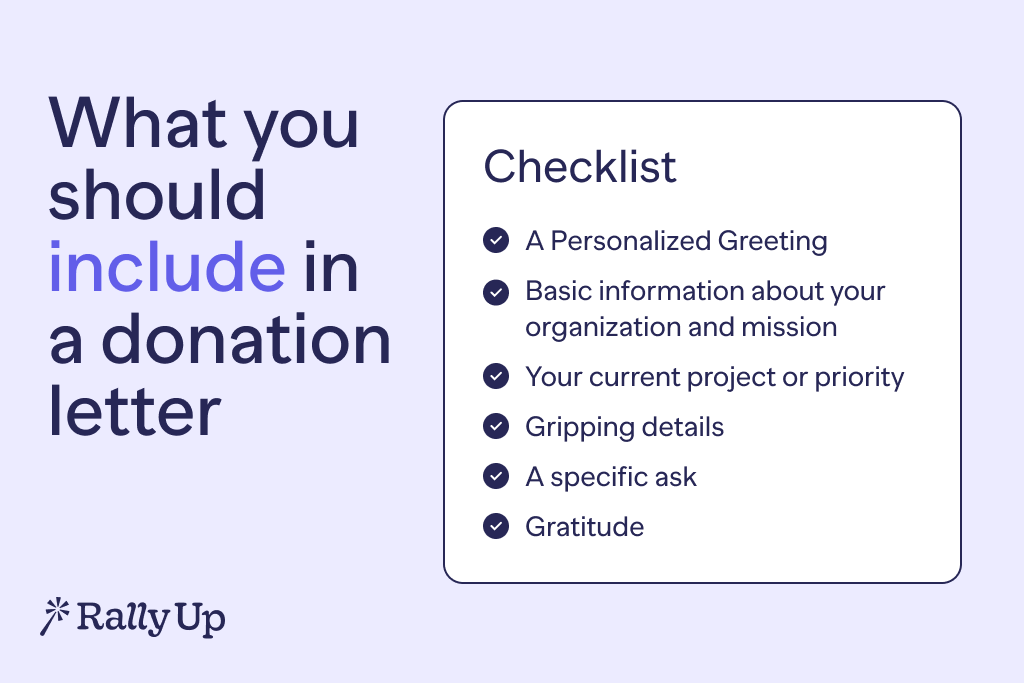
The Evergreen Lakes Conservation Society Sample Donation Request Letter
Greetings Mandre, As a community member in Evergreen Lakes, we know that you want our community to thrive. The Evergreen Lakes Conservation Society we’ve been hard at work preserving the natural elements that make our community special for the past 11 years. Through our local breeding program, we’ve increased the natural turtle population by 30%, the blue salamander population by 12%, and the native bird population by 5%. We’ve also restored natural habitats, educated our community on safe waste disposal practices, and helped children in our local schools find beauty in the great outdoors. With the success of our local breeding programs, we know that the wildlife we’ve helped bring back will need our support to thrive. That’s why we’re raising funds to create a permanent nature preserve right here in Evergreen Lakes. Each year, the world loses thousands of wildlife species forever. Our nation loses hundreds, and our state and community lose dozens. Once these wildlife species are gone, we cannot bring them back, and until they are gone, we cannot know the impact their loss will have on our ecological systems and food chains. Human interference in nature is almost always the cause of a species disappearance and, last year alone, it’s estimated that eight wildlife species were lost in our region due to illegal waste dumping, overdevelopment of wetlands, and overhunting. We have the power to help end extinction, but we need your support. The total land purchase cost for the Evergreen Lakes Nature Preserve is $500,000. So far, we’ve raised over $325,000 with $175,000 to go. That means we need just 350 individual community members to donate $500. With a $500 donation, you’ll gain lifetime access to the preserve as well as naming rights to one of the first 350 animals born or hatched on the preserve. The time to act is now. We’re grateful to the community at large for prioritizing the natural all around us and to you specifically for sharing our interest in making sure the world’s wildest species have someone safe to live. Thank you for your continued support. We look forward to seeing you at the preserve!
Start fundraising today the perfect way.
About the author.
Evgeny Redjebov
Evgeny is the Head of Marketing at RallyUp. He lives in Canada, where he spends most of his time removing snow. He also has years of experience in helping nonprofit organizations grow their supporter base.
Privacy Overview

Donation Request Letters: Fundraising Made Easy
- General Donation Request
- Corporate Donation Request
- Sponsorship Request
- Event Invitation
- Online Donation Request
- In-Kind Donation Request
- School Donation Request
- Church Donation Requests
What Are Donation Request Letters?
Donation request letters are typed or handwritten correspondences used by individuals who are looking to raise money for a project, event, expense, or other cause.
They can be sent to family members and friends, members of the community, and even corporations and businesses.
Donation request letters usually accompany another type of fundraising method, such as a crowdfunding campaign or a fundraising event.
Why Are Donation Request Letters Important?
Donation request letters are a more formal way to ask for donations from individuals and companies. They add some tangible significance to a fundraising effort.
They also allow you to spell out your needs on paper, giving the recipient a better idea of exactly what it is you’re asking for.
Donation request letters can help you connect even more with your potential donors or sponsors and bring legitimacy to your fundraising campaign.
How Should You Send Donation Request Letters?
You can spend the time creating, printing, and sending your donation request letters yourself, but it’s much more time- and cost-effective to partner with a dedicated direct mail campaign platform.
With a direct mail provider like GivingMail , you can choose from the most successful mailing options, upload your text, graphics, and supporter lists, and send your letters within minutes.
A dedicated direct mail partner helps simplify the process, from pricing to sending out your materials, so you can focus more on helping your cause.
BONUS: Download these fundraising letters + 16 bonus templates for free! Feel free to modify them however you'd like for your fundraising appeals!
Write your online fundraising appeal right now.
Eight Types of Donation Request Letters
- Types of Fundraising Letters
- #1: General Donation Request
- #2: Corporate Donation Request
- #3: Sponsorship Request
#4: Invitation to a Fundraising Event
Most individuals who need to raise money for a project, life event, or expense find themselves turning to crowdfunding as a way to raise the funds.
Many of these people end up raising above and beyond what they needed, thanks to the generosity of their friends and family members.
But other times, their crowdfunding efforts could use an extra boost.
That’s where donation request letters come in.
You can send donation request letters to your family members and friends, members of your community, and even companies.
We’ll be covering the most common types of donation request letters , when you should use them, and some best practices for each one. We’ve even got templates for you to use!
Let’s get started.
#1: General Donation Request Letters
What are they.
General donation request letters are the most standard fundraising option we’ll explore here. They’re used to ask for donations from friends and family members as well as from other members of the community.
They explain the fundraising need and address any questions that the recipient of the letter might have, such as how the money will be used and how to make a donation.
When Should You Use Them?
You should send out your general donation request letters shortly after you set up your crowdfunding campaign. The two work in conjunction with one another, giving donors two ways to donate to your cause.
You can also use general donation request letters to ask for donations for life events, various expenses, nonprofit causes, educational costs, and more!
Example of a General Donation Request Letter
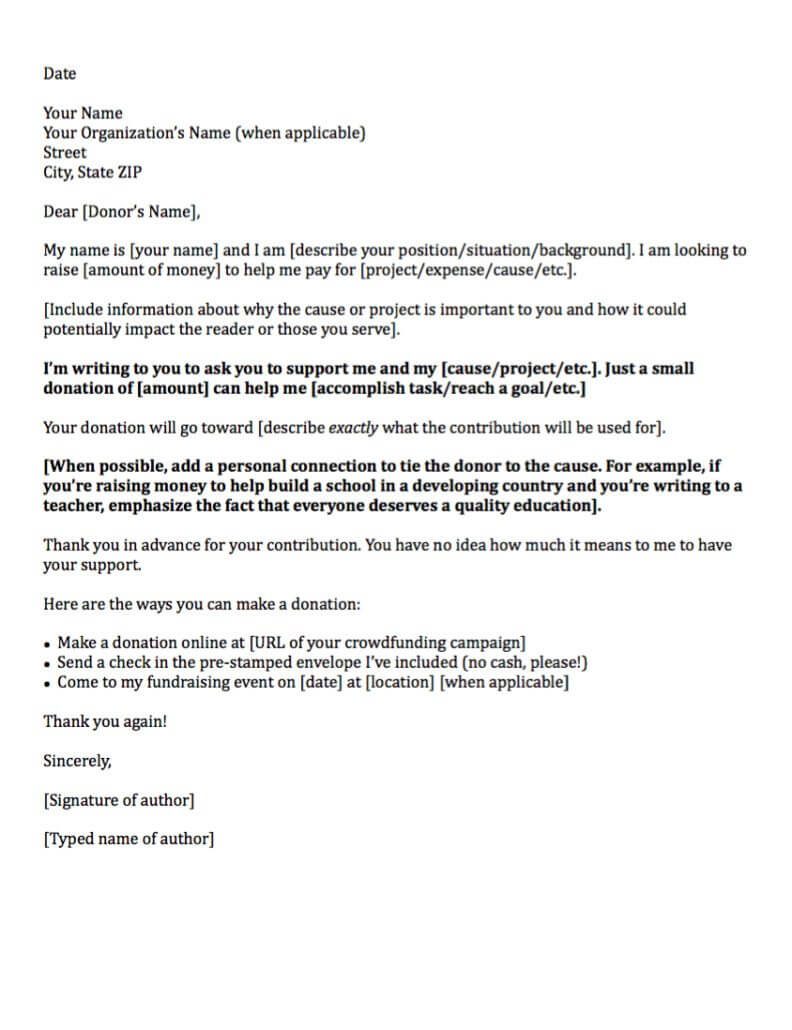
Your Name Your Organization’s Name (when applicable) Street City, State ZIP
Dear [Donor’s Name],
My name is [your name] and I am [describe your position/situation/background]. I am looking to raise [amount of money] to help me pay for [project/expense/cause/etc.].
[Include information about why the cause or project is important to you and how it could potentially impact the reader or those you serve].
I’m writing to you to ask you to support me and my [cause/project/etc.]. Just a small donation of [amount] can help me [accomplish task/reach a goal/etc.]
Your donation will go toward [describe exactly what the contribution will be used for].
[When possible, add a personal connection to tie the donor to the cause. For example, if you’re raising money to help build a school in a developing country and you’re writing to a teacher, emphasize the fact that everyone deserves a quality education].
Thank you in advance for your contribution. You have no idea how much it means to me to have your support.
Here are the ways you can make a donation:
- Make a donation online at [URL of your crowdfunding campaign]
- Send a check in the pre-stamped envelope I’ve included (no cash, please!)
- Come to my fundraising event on [date] at [location] [when applicable]
Thank you again!
[Signature of author]
[Typed name of author]
Best Practices for Writing General Donation Request Letters
Introduce Yourself If you plan on sending out general donation request letters to members of your community that don’t know you very well, you’ll need to introduce yourself. Give your readers some context as to who you are and why you’re raising money.
Make the Letter as Personal as You Can A normal letter is always personalized and doesn’t look like cookie cutter correspondence. Your donation request letters shouldn’t either! Personalize each letter and handwrite them when you can. This personal touch can go a long way with donors.
Sign the Letter Signing the letter may seem like a small detail, but if you type up your general donation request, it can be easy to just type your name at the end and drop the letter in the mail. Signing the letter helps to further personalize your donation request.
Tell Donors Where the Money’s Going Unless you have unusually trusting and philanthropic neighbors, you aren’t likely to receive any donations if you just ask for money. Let your readers know why you’re requesting donations and what you intend to do with the funds.
Raise Awareness About Matching Gifts Donation request letters are a great place to include educational content about matching gift eligibility. Make sure to mention that your nonprofit can receive even more assistance if your donors look up their eligibility and complete their matches!
#2: Corporate Donation Request Letters
Corporate donation request letters are used to ask for contributions from business and corporations. They can be sent to local businesses, the philanthropic arm of larger companies, or corporate foundations.
They typically include the reasons for fundraising and let the company know what benefit they could receive by donating to the individual’s campaign.
The deadline for sending in donation request letters to companies will differ from business to business. Each corporation will also have different guidelines for requesting donations, so make sure you’re aware of the rules.
Send out your letters with enough time to account for some additional conversations. You’ll likely need to have meetings or phone calls to clarify or explain your fundraising campaign.
Example of a Corporate Donation Request Letter

Dear [Business Owner/CEO/Manager of Corporate Social Responsibility],
[Include information about why the cause or project is important to you and how it could potentially impact the reader, the company, or the community].
I’m writing to you to ask you to support me and my [cause/project/etc.]. Would you be willing to contribute [amount] to help me [accomplish task/reach a goal/etc.]?
As a token of my appreciation, I will [offer incentive to the company].
If you would like to speak further about my [cause/project/event/etc.], feel free to reach out to me at [phone number] or [email address]. I’d love to answer any questions you have and give you more information.
If you would like, you can send a donation to [address] or contact me to set up another donation method.
Best Practices for Writing Corporate Donation Request Letters
Address the Right Person You might need to do a little research, but you will be much more successful if you write to the right person within a company. This might be a manager, a CEO, a business owner, or the person in charge of corporate social responsibility (CSR).
Make it About the Company Companies are in business to do business, and while they often have philanthropic departments, they will always be faced with a bottom line. Instead of just asking for money, make it clear that by donating to your campaign, the company will also benefit in some way.
Offer to Set Up a Meeting A company probably isn’t going to give you money just because you send them a letter asking for funds. Within your letter, offer to set up a meeting or a phone call with the recipient to discuss the particulars of the donation, your campaign, and what you plan on doing with the funds.
Ask for a Particular Amount Your corporate donation request letters shouldn’t be ambiguous when it comes to your fundraising needs. Ask around to see if you can get an idea of how much the company typically donates to campaigns like yours and focus your amount around that figure.
#3: Sponsorship Request Letters
Sponsorship letters are used whenever an individual participates in a fundraising event, such as a walkathon, marathon, or cycling event. They are written to ask friends and family members to donate a lump sum or to give a certain amount for every mile that the individual walks, runs, or cycles.
They typically include different donation options for the recipients to choose from, as well as the particulars of the event the individual is going to participate in, the nonprofit they’re raising money for, and the cause they’re participating in.
Since a fundraising event has a definitive end-date by which individuals must raise a certain amount, you should send out your sponsorship request letters as soon as you can. You want to give your recipients enough time to think about your request and make their contributions.
You might need to get in touch with your potential donors once you’ve sent the letter to ask if they have any questions about your request. Give them a call, shoot them a text message, or write another letter to follow up before the event.
Example of a Sponsorship Request Letter
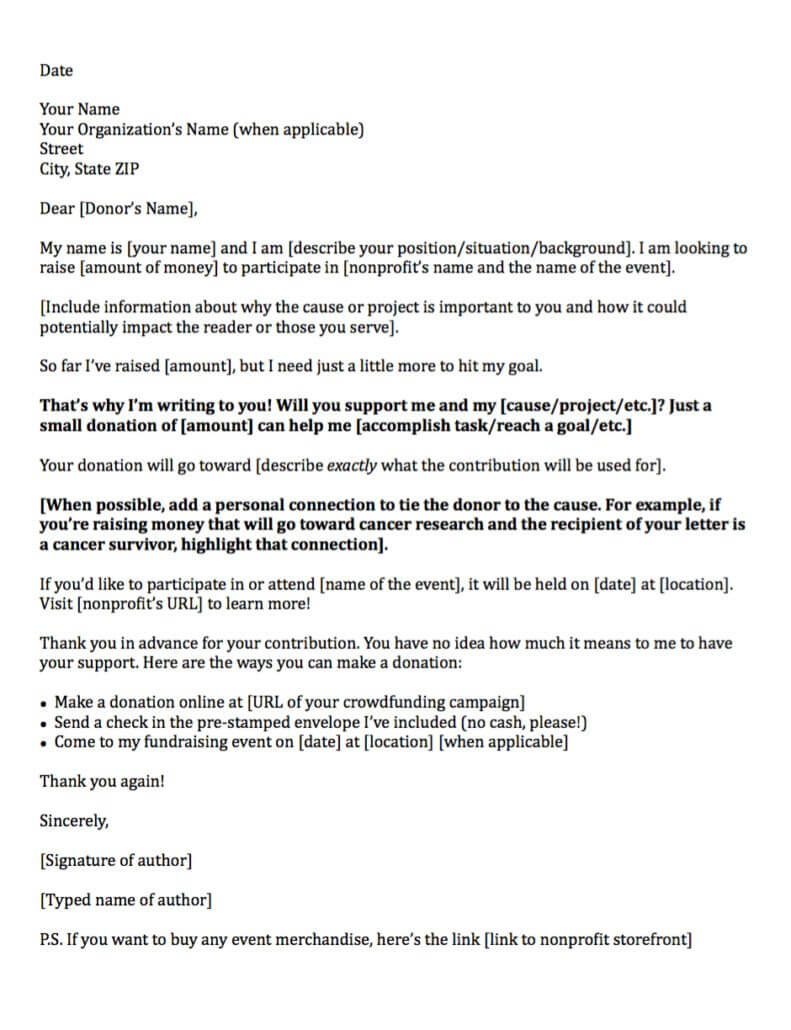
My name is [your name] and I am [describe your position/situation/background]. I am looking to raise [amount of money] to participate in [nonprofit’s name and the name of the event].
So far I’ve raised [amount], but I need just a little more to hit my goal.
That’s why I’m writing to you! Will you support me and my [cause/project/etc.]? Just a small donation of [amount] can help me [accomplish task/reach a goal/etc.]
[When possible, add a personal connection to tie the donor to the cause. For example, if you’re raising money that will go toward cancer research and the recipient of your letter is a cancer survivor, highlight that connection].
If you’d like to participate in or attend [name of the event], it will be held on [date] at [location]. Visit [nonprofit’s URL] to learn more!
Thank you in advance for your contribution. You have no idea how much it means to me to have your support. Here are the ways you can make a donation:
Thank you again! Sincerely,
P.S. If you want to buy any event merchandise, here’s the link [link to nonprofit storefront]
Best Practices for Writing Sponsorship Request Letters
Give Some Background Information Not everyone will be familiar with the cause or nonprofit that you’re running, walking, or cycling in support of. It helps to offer a little context to give your readers an idea of what they’d be supporting with their donations.
Let Readers Know How Much You’ve Already Raised People are more likely to give to campaigns that already have supporters and donations. Within your letter, let your readers know how much money you’ve raised to give them an idea of how many supporters you have.
Invite Readers to the Event Your recipients might be equally as interested in participating in the fundraising event as you are. And even if they aren’t, you can invite them to attend and encourage you and the other participants as you run, walk, or cycle past them.
Include the URL of the Event’s Online Storefront Many walkathons, marathons, and other fundraising events have an online store where participants and donors can buy t-shirts, sweatshirts, water bottles, and other merchandise. Make sure that you include the URL to this storefront in your letter, so your recipients can support your cause even more!
Invitations to fundraising events are pretty self-explanatory. They’re cards or letters that invite your friends, family members, and people in your community to a fundraising event you’re hosting to raise money for a cause, project, or expense.
They can vary in format, but they always contain the date and location of the event, any special requests for attendees, and the cause or project that you’re raising money for.
To ensure that your recipients have enough time to consider and respond to your invitation asking them to come to your fundraising event, you should send your letters no later than three weeks before the planned day. This gives you time to plan and time for them to respond.
Fundraising events themselves can be planned for any time of year, but remember to consider your attendees’ schedules. You don’t want to plan an event when everyone’s out of town for the holidays!
Example of an Invitation to a Fundraising Event
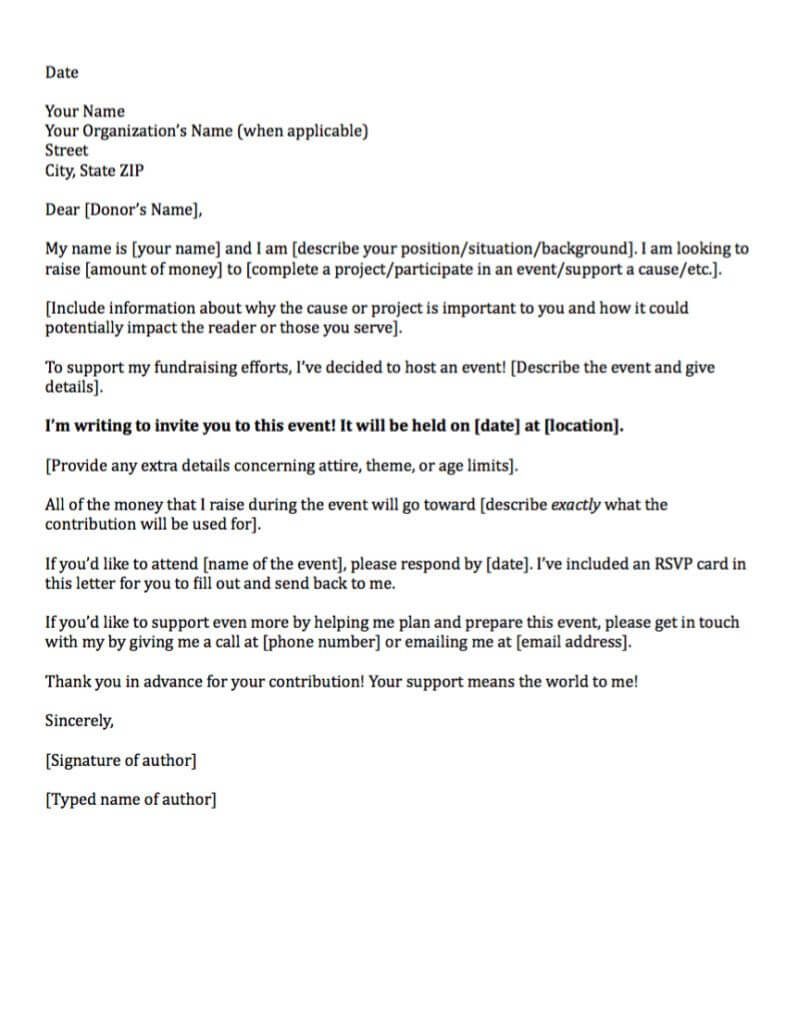
My name is [your name] and I am [describe your position/situation/background]. I am looking to raise [amount of money] to [complete a project/participate in an event/support a cause/etc.].
To support my fundraising efforts, I’ve decided to host an event! [Describe the event and give details].
I’m writing to invite you to this event! It will be held on [date] at [location].
[Provide any extra details concerning attire, theme, or age limits].
All of the money that I raise during the event will go toward [describe exactly what the contribution will be used for].
If you’d like to attend [name of the event], please respond by [date]. I’ve included an RSVP card in this letter for you to fill out and send back to me.
If you’d like to support even more by helping me plan and prepare this event, please get in touch with my by giving me a call at [phone number] or emailing me at [email address].
Thank you in advance for your contribution! Your support means the world to me!
Best Practices for Writing Invitations to Fundraising Events
Make it About the Cause, not Necessarily the Event While fundraising events can be enjoyable for you, your friends, and your family members, the real reason you’re hosting the event is to raise money for a cause or project. Make sure that your invitation highlights this cause over the event.
Give a “Respond By” Date If you’re planning a more involved or complicated fundraising event, you’ll need to know exactly how many people will be there. Include an RSVP date that recipients have to respond with their answer by.
Include any Specific Requests or Instructions Hosting a themed fundraising event? Do you want people to dress up in silly costumes to support your cause? Let them know in the invitation! If they need to bring something with them to the event, let them know that as well.
Ask if Your Recipients Would Like to Help If you’ve never planned a fundraising event, you’ll quickly learn that a lot of preparation, logistics, and money goes into the planning and execution. If you feel like you need some help, you can use your invitation letter to ask your recipients for their assistance in planning and preparing for your event.
#5: Online Donation Request Letter
Now, more than ever, the majority of fundraising occurs online. If you’ve created a crowdfunding campaign or another type of online fundraiser , how you ask for donations will vary from traditional donation requests.
Your letters (or emails) should always contain the URL of your online donation page, as well as information on how supporters can contribute.
Use online fundraising letters when you start a digital campaign. Sending out letters is a crucial step to spreading awareness about your cause. Therefore, you should send multiple letters at different stages.
Keep your campaign’s momentum going by sending letters at the beginning, halfway through, and a week before the end of your online fundraiser.
Example of an Online Donation Request Letter

My name is [your name] and I am [describe your position/situation/background]. My organization launched our [name of online fundraiser] today. Our goal is to reach [amount] to [project, event, cause you’re raising money for].
[If possible, add a personal connection to tie the donor to your cause. For instance, if you’re raising money to create a program that provides kids with toys for the holidays and you’re writing to a father, emphasize how grateful the children will be to receive a toy from their parents].
Just a small donation of [amount] will help me accomplish [explain exactly how that contribution will make a difference].
You can make contributions on our crowdfunding page [link to page]. If you can’t give, but still want to support our cause, please share our page with your friends, family members, and coworkers. With more people aware of our cause, we’ll be one step closer to reaching our goal.
The team at [organization’s name] would like to thank you in advance for your support.
Best Practices for Writing Online Donation Request Letters
Connect Recipients to Your Cause Your letter should include a personal connection to tie readers to your cause so they’re interested in contributing. You can simply explain how your cause will affect the community your recipient lives in.
Give an End Date A sense of urgency is a great motivator. Including your campaign’s end date will let donors know that they only have a little time to make a decision. Plus, if they support your mission, they’ll be more motivated to share your campaign.
Ask Recipients to Share Your Campaign Not everyone will have the means to contribute financially, but by asking people to share your donation page, you’ll reach more potential donors and provide supporters with another way to contribute.
Link to Your Online Fundraising Page After presenting your cause, you should direct readers to where they can learn more information or donate. If you’re sending an email, link directly in your message; that way, donors can easily transition from your email to your campaign.
#6: In-Kind Donation Request Letter
Nonprofits can create in-kind donation request letters when they need items or services rather than monetary contributions. Usually, in-kind donation requests are written to local businesses and corporations, but nonprofits can use them to ask for donations from individual supporters as well.
Your letters should always include the specific items or services that you’re requesting and how those donations will be used.
When you should use in-kind donation request letters will depend on your nonprofit’s needs. For instance, if you’re hosting a charity auction — a common event that requires in-kind contributions — you’ll need to send out a letter requesting auction items.
You can use in-kind donation request letters when you need items or services for an event or in other instances when receiving items will be more beneficial than monetary donations.
Example of an In-Kind Donation Request Letter
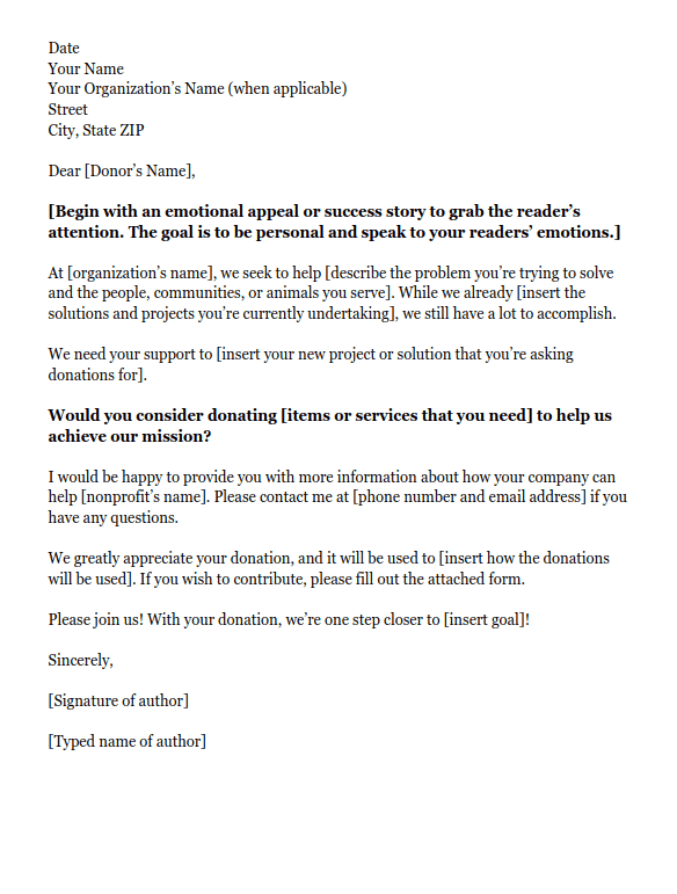
[Begin with an emotional appeal or success story to grab the reader’s attention. The goal is to be personal and speak to your reader’s emotions.]
At [organization’s name], we seek to help [describe the problem you’re trying to solve and the people, communities, or animals you serve], we still have a lot to accomplish.
We need your support to [insert your new project or solution that you’re asking donations for].
Would you consider donating [items or services that you need] to help up achieve our mission?
I would be happy to provide you with more information about how your company can help [nonprofit’s name]. Please contact me at [phone number and email address] if you have any questions.
We greatly appreciate your donation, and it will be used to [insert how the donations will be used]. If you wish to contribute, please fill out the attached form.
Please join us! With your donation, we’re one step closer [insert goal]!
Best Practices for Writing In-Kind Donation Request Letters
Provide Context for Your Request After introducing yourself, give your recipients some background information on your cause so that they understand why these items or services are valuable to your mission.
Be Specific About What You Need Since the items and services that you request will vary from one company to the next, each letter should be customized to fit the recipient. You should be very specific about what (and how much) you need and why you need it.
Include Your Contact Information Just in case your recipients want to discuss the details of the donation in more depth, include your contact information or the person responsible for receiving in-kind donation requests.
Attach a Request Form Don’t forget to include a donation request form with your address so donors know where to send their donations.
#7: School Donation Request Letters
The school donation request letter is specifically for K-12 schools, universities, and education-related organizations that need to raise funds. The recipients of this letter can be individual supporters as well as local businesses.
Your letter should include information about your school and if possible, a story from one of your students to convey the impact that the readers’ contributions will have.
If you’re a school or education-related organization, you can use this letter whenever you need donations. You should send this letter when you launch an online campaign, when you’re looking for in-kind donations, or before an upcoming event.
You can tailor this letter to meet any of your school’s different fundraising scenarios.
Example of a School Donation Request Letter
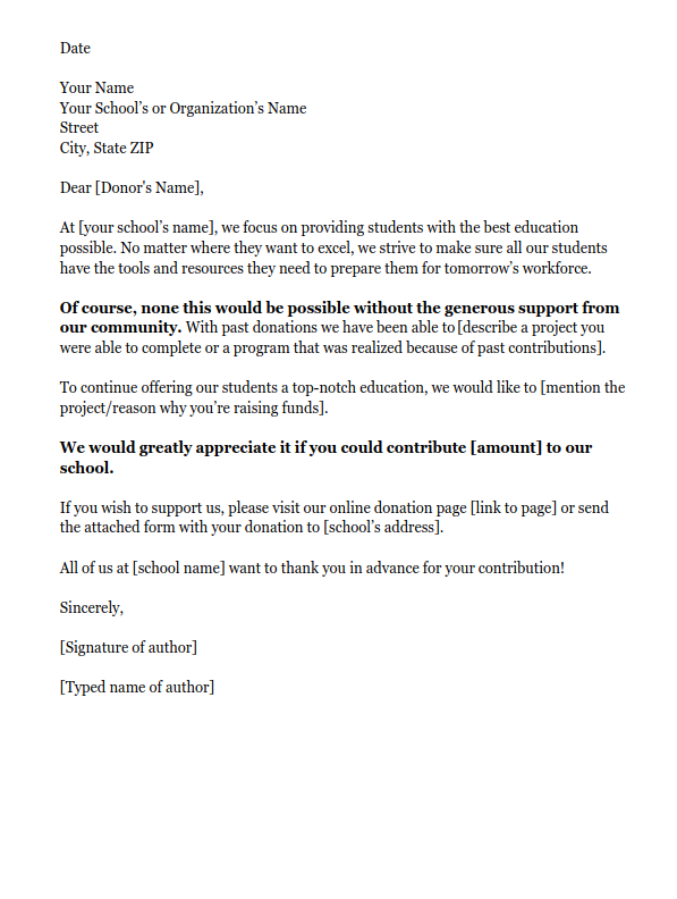
Your Name Your School’s Name (when applicable) Street City, State ZIP
At [your school’s name], we focus on providing students with the best education possible. No matter where they want to excel, we strive to make sure all our students have the tools and resources they need to prepare them for tomorrow’s workforce.
Of course, none of this would be possible without the generous support from our community. With past donations we have been able to [describe a project you were able to complete or a program that was realized because of past contributions].
To continue offering our students a top-notch education, we would like to [mention the project/reason why you’re raising funds].
We would greatly appreciate it if you could contribute [amount] to our school.
If you wish to support us, please visit our online donation page [link to page] or send the attached form with your donation to [school’s address].
All of us at [school name] want to thank you in advance for your contribution!
Best Practices for Writing School Donation Request Letters
Connect With Recipients Share a story or describe a challenge you hope to solve with this fundraiser. By opening your letter with a compelling story, your donors will feel connected to your cause and understand the impact that their contributions will have.
Focus on Your Donors With school donation request letters, it’s easy to get caught up in sharing your achievements, but don’t forget to focus on your donors. Explain how your accomplishments wouldn’t be possible without their support.
Provide Multiple Ways to Contribute Make it as convenient as possible for potential donors by giving them options on how they can contribute. Let them know about your online donation page, volunteer opportunities, and upcoming events.
Thank Recipients in Advance You should always thank your readers, regardless of whether they make a donation or not. Add a short sentence at the end thanking recipients for their time and consideration.
#8: Church Donation Request Letters
The church donation request letter is pretty self-explanatory. Churches and other faith-based organizations write these letters to solicit gifts that fall outside of your congregants normal tithing.
When addressing your congregants, your letter should include detailed information about the event or campaign you’re raising funds for.
Churches and other faith-based organizations can use this letter to ask for gifts from their congregants for any occasion.
If you’re informing congregants about an event, fundraiser, or online campaign , you can use this type of letter.
Example of a Church Donation Request Letter
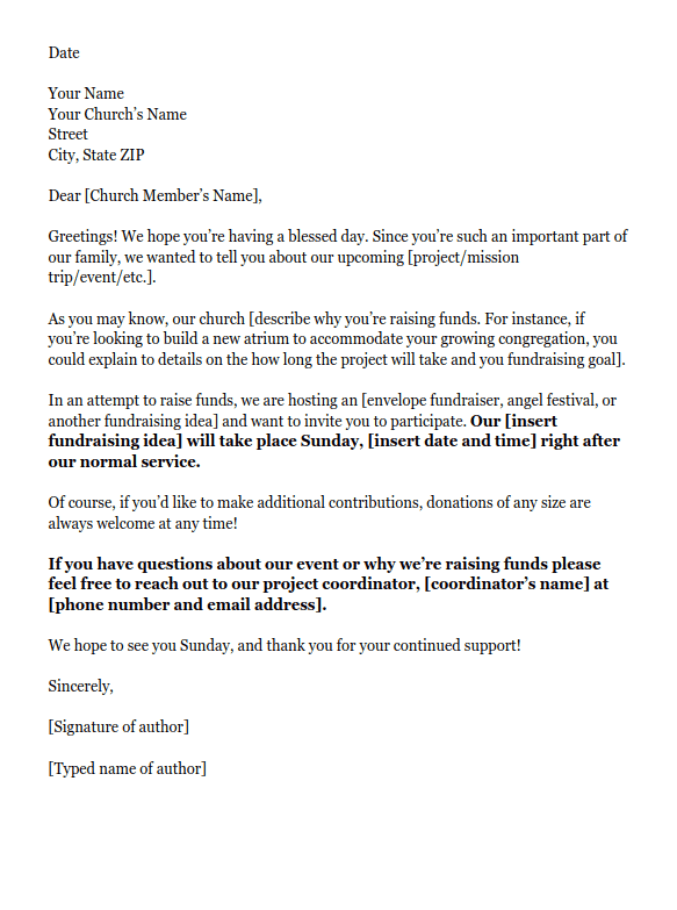
Your Name Your Church’s Name Street City, State ZIP
Dear [Church Member’s Name],
Greetings! We hope you’re having a blessed day. Since you’re such an important part of our family, we wanted to tell you about our upcoming [project/mission trip/event/etc.].
As you may know, our church [describe why you’re raising funds. For instance, if you’re looking to build a new atrium to accommodate your growing congregation, you could explain to details on the how long the project will take and you fundraising goal].
In an attempt to raise funds, we are hosting an [envelope fundraiser, angel festival, or another fundraising idea] and want to invite you to participate. Our [insert fundraising idea] will take place Sunday, [insert date and time] right after our normal service.
Of course, if you’d like to make additional contributions, donations of any size are always welcome at any time!
If you have questions about our event or why we’re raising funds please feel free to reach out to our project coordinator, [coordinator’s name] at [phone number and email address].
We hope to see you Sunday, and thank you for your continued support!
Best Practices for Writing Church Donation Request Letters
Include a Warm Greeting To let your congregants know that you value them, start your letter with a personal greeting. Unlike with many of the other letters, you can use a more casual tone.
Provide Details About Your Fundraiser Even if you’ve mentioned your fundraiser during a sermon, don’t just assume that everyone already knows about your project. Make sure to share the details of why you’re raising funds, even if you’re a close-knit congregation!
Remind Congregants That You’re Always Accepting Gifts If your fundraiser requires a contribution to participate, you should also let congregants know that you’re always accepting gifts. That way, if some church members can’t make it to your event, they still have the option to contribute.
Include Contact Information Provide your congregants with the contact information of the person organizing the event in case they have additional questions.
Additional Resources
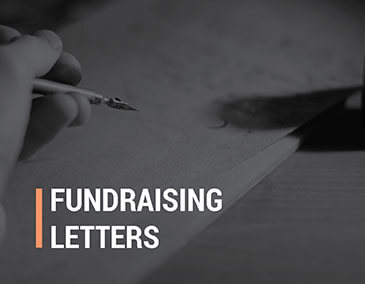
Fundraising Letters
A fundraising letter is a great avenue for nonprofits who need to ask for donations in a more formal and direct way.
Your organization, club, or school can use fundraising letters to ask local businesses and individuals for cash and in-kind donations. You can even ask for sponsorships with fundraising letters!
Take a look at our favorite fundraising letters and download your every own templates. Start raising more money with these fundraising letters!

Sponsorship Letters
Sponsorship letters are used by organizations who need help paying for larger fundraising campaigns or annual events.
Nonprofits, clubs, and schools offer perks to local businesses and individuals in exchange for donations. Each donor gives a certain amount that corresponds to a sponsorship level. The perks might include free advertising , event tickets, and more!
If you need help writing a sponsorship letter or a sponsorship levels document, don’t worry! We’ve got some awesome templates for you to use.

- How to Ask for Donations
If you want to write a successful donation request letter, you need to understand the art of asking for donations.
This guide will take you through the best practices that will make you an expert on soliciting donations. You can even use these techniques in your other fundraising letters.
Click below to learn how you can ask for donations. Plus, get tips on how you can write better fundraising letters.
Crowdfunding Resources
- Crowdfunding (Beginner’s Guide)
- 30+ Standout Crowdfunding Websites
- Success Stories
- Tell Your Story
Fundraising Resources:
- 150+ Fundraising Ideas
- 45+ Youth Fundraising Ideas
- Peer-to-Peer Fundraising Guide
Popular Resources
- GoFundMe Alternatives
- 12 Types of Sponsorship Letters and How to Write Them
- Top Companies That Donate to Nonprofits
- How to Write a Fundraising Letter

Fundly is dedicated to providing you with the tools you need to raise money for whatever your cause may be.
Your Name (required)
Your Email (required)
Your Message
Request for Donation Letter
Request for donation letter template.
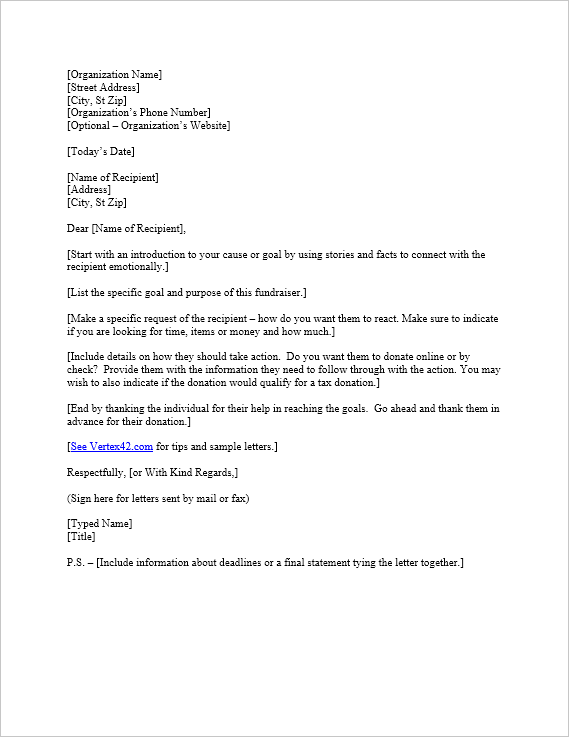
Other Versions
Description.
Download and customize this template using Word, OpenOffice, or Google Docs. The information in [brackets] should be replaced with your specific information or details. We can't guarantee the results you will get for sending fundraising letters like this, but this template and the sample donation letters below should at least provide some ideas.
Author : Brent Weight and Jon Wittwer
License : Limited Use
Tips: How to Write a Donation Request Letter
- Before writing you must know the audience, the goal and the action you are looking for.
- Use the charity organization's official letterhead and make sure it includes the organization's logo, name, address, phone number and website.
- Make sure you include the date and the recipient's full address.
- Personalize the letter as much as possible. People will respond better to personalized letters rather than computer generated letters. For example, address the letters directly to the recipient rather than Dear Sir or Dear Friend.
- Keep the letter specific and professional.
- Make your argument using success stories and facts; these will help people feel the importance of your cause.
- Communicate clearly the organization’s goal for this drive. The organization may have many purposes and projects, but make sure your letter is focused on a particular need.
- Identify the specific action you wish the recipient to take to help achieve the organization's goal – whether it is donating money, items or time and how much.
- Provide details on how they can respond including a return envelop if applicable. If you are doing Online Fundraising, then be sure to include the proper website information.
- You may wish to mention that their donations may be tax deductible if your organization qualifies under IRS guidelines.
- Be thankful – thank them for their time and their consideration or go ahead and thank them for their donation.
- Make sure the letters are signed by a real person and include their name and title below the signature.
- A post script (PS) is appropriate in this form of letter and can convey additional information such as deadlines, goals or a final reference to the story or facts used at the beginning of your message to tie it together.
- Make sure you send them a Donation Thank You Letter after they have made a contribution.
Sample Donation Request Letters
Sample non profit donation letter.
Number One Non Profit 123 Anywhere Street Best Town, Best State 88889
Mr. and Mrs. Ryan Francom 456 Somewhere Road Best Town, Best State 88889
Dear Mr. and Mrs. Francom,
In 2009 Number One Nonprofit helped over 350 underprivileged boys participated in Boy Scout activities in our community. They had a chance to learn to swim, learn basic survival and first-aid skills and learn how to work with other boys. More importantly, they were given the chance to develop confidence, to feel wanted and to develop dreams for their future, dreams that have included becoming engineers, accountants, doctors and politicians.
Here is what some of our alumni our have to say about the impact Scouts had on their lives:
" I don’t know where I would be without Scouts. My dream of becoming an Engineer really started with my first model rocket built in Scouts. " - Bill
" Scouts gave me somewhere to go after school and kept me from getting into other trouble. Frightens me to think of where I would be without the help of my leaders and friends from scouts. " - Tom
Our goal for 2010 is to help 420 boys participate in scouting activities including a full week at summer camp. Thanks to generous sponsors, we are well on our way to reaching our goal, but we still need help supporting the final 150 boys. Will you help us meet our goal to provide these wonderful boys with worthwhile activities by supporting a boy? Your donation will have a dramatic impact on the life of a young man.
Here is how your gift will impact them:
- $100 – Your boy will receive a uniform and be able to participate in weekly activities for one year
- $150 – Your boy will have a spot at a week long summer camp with activities such as horseback riding, crafts, swimming, canoeing and archery.
- $250 – Your boy will receive a uniform, a week at scout camp and participate for 1 year in weekly activities.
Send your gift directly to us using the included return envelop or, if you wish, you may use our online donation website – www.numberonenonprofit.com.
All donations to Number One Non-Profit go directly to the boys we have been helping since 1985. Your gift will have tremendous impact on the life of a boy and help him to have the skills, vision and motivation to change his life. Thank you for partnering with us to help our boys.
Bill Stevenson President
P.S. – Since activities start the first week in January, our deadline for raising funds is 12/15/2009.
School Donation Letter Example
Super Duper Academy 123 Anywhere Street Best Town, Best State 88889 www.superduperacademy.com
Mr. and Mrs. Gary Jones 456 Somewhere Road Best Town, Best State 88889
Dear Mr. and Mrs. Jones,
The Super Duper Academy is a local school that seeks to help children with disabilities and learning challenges. We currently have enrolled over 200 students and are helping them with our customized and tailored curriculum.
We have a dream this year to add a music class in the hopes that each of our students who desires will have the opportunity to develop a talent in music. The Super Duper Academy needs enough instruments to get the class started. These instruments should be in good shape and playable. Each one donated to the academy will be assigned to a particular student, one that they can take home for practice and use in class.
We are asking you to please look around your house and donate any instruments that you may no longer need, even if the instrument may need minor repairs. If you would still like to give, but do not have an instrument, consider giving a cash donation that can be used for other music supplies or check your local pawn shop for a suitable instrument.
Instruments can be dropped off at our front desk or simply call (123)456-7890 and we will be happy to drop by and pick up the instrument.
It is through generous donations like yours that the Super Duper Academy has been able to provide life changing classes and experience to thousands of special needs students over the last five years. We could not do it without you.
Bill Kennedy Principal
P.S. – We would like to invite you to our open house on August 31, 2010 at 6:00 PM to meet some of our students and to learn more about our programs.
Sample Charitable Donation Letter
Katie Brooks 123 Anywhere Street Best Town, Best State 88889
Mrs. Norah Smith 456 Somewhere Road Best Town, Best State 88889
Dear Mrs. Smith,
On June 16th, 2009 I will join thousands of others on a 20-mile walk as part of the MyCharity Walk-a-thon, an event that raises money for MyCharity and the fight against breast cancer. The goal of this event is to increase awareness of breast cancer, to highlight stories of survivors and to raise money to help fund research into curing this deadly disease.
I am writing you to ask you for your support for this event and cause.
I know firsthand what it is like to lose a loved one to breast cancer. My mother passed away five years ago after losing a three year battle with breast cancer. If she had been more aware of the risks of breast cancer, perhaps she would have sought medical attention sooner. I believe she is proud of my efforts and I like to think she will be walking beside me on this 20-mile event.
Please read the enclosed brochure that further describes MyCharity, its goals and details about our event on June 16th. Then determine how much you will pledge to help sponsor me in this event. You can make your pledge directly at www.mycharity.org or can mail your donation, along with the enclosed donation form to MyCharity. Last year I was able to raise $2750. Will you please help me reach my goal this year of $3,500.
Thank you for taking the time to learn more about breast cancer and my efforts to end it, something I wish for so that others do not have to go through the experience of losing their loved one early.
Katie Brooks
Additional Resources
- Donation Form by Vertex42.com - A customizable and printable form to send to potential donors.
- IRS Rules (Publication 526) - irs.gov - General guidelines for charitable contributions
- Tips for Writing Fundraising Letters at WriteExpress.com
Follow Us On ...

Sponsored Listings
Letter templates.
- Terms And Conditions
- Privacy Policy
- Editorial Policy

21 Donation Request Letter Samples & Templates [Free]

Organizations often need financial donations to help carry out their work. donation request letters are one way to ask for money from individuals or businesses. These letters should be well-crafted and persuasive in order to generate the desired response from potential donors. In this blog post, we will discuss how to write a donation request letter that is effective and can help your cause.
What is Donation Request Letter?
Donation request letters are a type of fundraising letter sent out to potential donors. These letters typically ask for financial support for a specific cause or charity. Donation request letters should be well-written, persuasive, and provide information about the need for donations.
They should also include a call-to-action, asking the recipient to take action by donating money or supplies. Donation request letters can be sent to individuals, businesses, or organizations.
When writing a letter, it is important to be clear about what you are asking for and why the recipient should donate. Donation request letters can be an effective way to raise money for a good cause.
Donation Request Letter format
The email format for sending a letter is simple and includes just five essential parts:
- Subject line ( How to write a good email subject line That Opened 10x )
- Opening line and body
Donation Request Letter
Template 1:
Letter Template 2:
Template 3:
Related: 23+ Thank You Letter For Help Samples & Templates
Donation letter template
Letter Template 4:
Template 5:
Sample letters asking for donations
Letter Template 6:
Template 7:
Letter Template 8:
Giving donation letter sample
Template 9:
Letter Template 10:
Simple donation letter sample
Template 11:
Letter Template 12:
Donation request letter template
Template 13:
Letter Template 14:
Sample donation request letter
Template 15:
Template 16:
Letter asking for donations
Letter Template 17:
Template 18:
Sample sponsorship letter for donations
Letter Template 19:
Letter asking for donations from businesses
Template 20:
Letter Template 21:
Donation Request Letter subject lines
Donation request letters are a way to ask for monetary donations from individuals, businesses, or organizations. The subject line of the Donation Request Letter is important because it will be the first thing that the reader sees. It should be clear and concise, and it should explain what the letter is about. For example, a Donation Request Letter for a school fundraiser might have a subject line that says “Request for Donation: Please Help Our School Raise Money for New Books.” Including specific details in the subject line will help to convince the reader that their donation is need and will go to a good cause. Thank you in advance for your generosity.
- Donation Request for [Charity Name]
- Urgent: Donation Request for [Charity Name]
- Donation Request for [Charity Name] – Time Sensitive
- [Charity Name] Donation Request – Please Help!
- Donation Request for [Charity Name] – Every Donation Helps!
- request for donation,
- help us with a donation
- how can you help? A donation
- our cause needs your support
- every little bit helps – Donation Request for [Charity Name]
How to Start Donation Request Letter
Donation request letters are a common way for individuals and organizations to raise money for a cause. While there is no one way to write a letter, there are certain elements that should be included to ensure that the letter is effective.
The first step is to introduce the organization and explain why the donations are needed. Next, it is important to provide specific information about how the donations will be used. It is also helpful to include a personal story or testimonial to illustrate the impact of the donations.
Finally, it is important to thank the reader for their time and consideration. By including these elements, donation request letters can be an effective way to raise funds for a worthy cause.
How to END Donation Request Letter
Donation request letters are typically written to businesses or individuals who are able to make financial contributions to a cause, event, or organization. While there is no one right way to write a donation request letter, there are some key elements that should be included in order to make the letter as effective as possible.
First, it is important to clearly state what the donation will be use for. Second, it is helpful to provide information about the organization or event, and how the donation will make a difference. Finally, it is polite to thank the reader for their time and consideration. By following these tips, you can write a Letter that is both professional and persuasive.
I am exited to see the potential this letter has for generating donations. Please let me know in the comments below if you have tried a similar donation request letters and what your results where. Additionally, feel free to share any tips that you may have on how to make these letters more effective.

You may also like

15+ Condolence Letter On Death Of Father Free Templates
On the death of a loved one, it can be hard to know what to say or do. A Condolence Letter On Death...

15+ Thank You Letter To Wedding Planner Email Templates
Are you looking for Thank You Letter To Wedding Planner Email? When it comes to wedding planning...

21+ Congratulatory Retirement Letter & Email Free Samples
Although retirement may seem daunting at first, it can be a very liberating and exciting time in...

21 Thank You Letter To Employee Samples [Free]
Summer is coming to an end and with the kids going back to school, it’s time to reflect on...
About the author
How to create a donation letter template.

Maximize your fundraising efforts by creating a compelling donation letter template to inspire greater contributions.
What is a donation request template used for?
A donation request letter is something you send (via email or physical mail) to potential donors asking them to support your cause. Sending donation request letters can boost fundraising for your organization. When you start with a donation request letter template, you don’t have to write your letter from scratch. A template will also help ensure that all of your letter’s key elements are in place. That way, donors have the information they need to contribute.
Personalizing a template for a donation request.
Using a template for a donation request letter is a great starting point. Still, some personalization will make your letter much more effective at bringing in resources. Here’s how:
- Using the reader’s name helps engage the reader.
- Including stories about your mission draws them in and makes them want to participate.
- Using specifics about how the donation will help the cause can help them visualize the difference they’ll be making.
- Changing the specific request based on that donor’s past contributions helps the ask to feel reasonable.
- Creating separate letters for lapsed versus recurring donors can help you use different strategies to engage them.
How to write a donation letter template.
Donation letters can vary from organization to organization, but there are a few pieces of information that should make the cut for every business. Use these as you’re learning how to write a donation letter template:
- Your information. In the header, include your organization’s name, logo, website, mailing address, phone number, and any other contact information donors might need.
- Personal greeting. Every donation letter template should start with a personal salutation that greets the potential donor by name. If you don’t know their name, use something friendly like “Dear friend, neighbor, etc.”
- Project details. Explain to potential donors what you need the money for. If you don’t prove your good cause, you probably won’t get many donations.
- A specific request. Include a specific request in your donation letter. Saying “$25 is enough to purchase new shoes for a child in need” is more powerful than a generic ask. Just don’t forget to make it clear that any donation will help and thank them for their support.
- Call to action . Finish your donation letter template with a call to action that explains the next steps you want the reader to follow. For example, this could be to follow a link to a landing page on your website.
Best practices to improve donation letter success.
Focusing on professionalism can help ensure you’re using your request for donation letter template most effectively. A professional tone lets your donors know that your cause is legitimate and that you respect their contributions. Use simple language that donors will understand, avoiding jargon you might use internally.
Consider your formatting and include graphics that represent your brand well. If you’re sending emails, make sure they’re easy to view on a mobile device as well as a computer.
To continue to improve your donation letters, you’ll need to collect data about the engagement and donations you’re getting from different types of letters. Snail mail might be the best way to seek donations if you have an older or more formal donor base. Text and social media posts might work best for young and engaged donors. Email is a great place to start since it’s formal but accessible for most donors. Your data will tell you what’s working for you.
Convert your donation letter template to PDF.
It’s easiest to write your template for a donation request letter in a word processing application like Microsoft Word, but before hitting the send button, make sure to convert the template to a PDF .
PDFs maintain formatting, whether your recipient opens it in an app like Acrobat Reader or on any device browser. Plus, donors can fill out the document and sign documents electronically with the click of a button. They can even complete the form using an online PDF editor without needing to download new software. The easier it is for donors to fill out, the more likely they’ll follow through.
Discover what more you can do with Adobe Acrobat to make it easy to send donation letters to potential contributors.

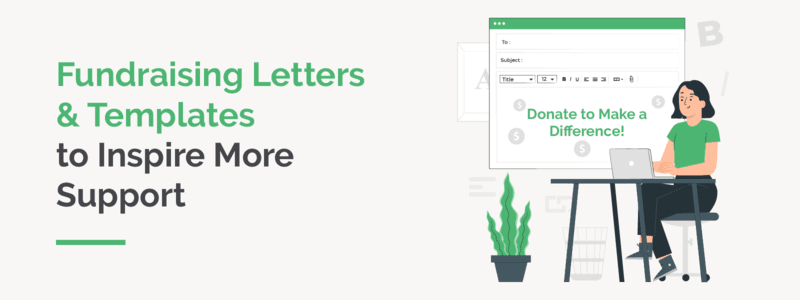
14 Fundraising Letters & Templates to Inspire More Support
Your nonprofit needs funds to power its mission, but how do you communicate this need to potential donors? Fundraising letters are a time-tested, impactful way to reach out to supporters and encourage them to play a role in your impact.
Whether you choose to send them via email or direct mail, if you’re looking for smart and effective appeal letters, you’ve come to the right place. We’ve compiled common types of donation requests, plus carefully crafted templates that your team can use to jumpstart your outreach.
Here’s what we’ll cover:
How to Send Fundraising Letters
How to write a fundraising letter, 14 types of fundraising letters (+ templates).
With the right tips, tricks, and tools, your team can connect with more donors and cultivate lasting relationships to strengthen your work. Let’s cover the basics of writing fundraising letters, then explore the specific types of requests your nonprofit may decide to send.

Before crafting your letters, you’ll want to know how you’re going to deliver each one. That way, you can tailor the formatting appropriately. Certain outlets lend themselves better to letters than others. Of course, you’ll want to deliver your solicitation letters using each recipient’s preferred contact method. Bearing that in mind, let’s explore the most common channels nonprofits use to solicit donations.
Who doesn’t love receiving a thoughtful greeting card? From special occasions to “just because,” there’s a card for everything! With a bit of creativity, you can elevate your fundraising letters by sending them as digital greeting cards. Each donor will receive a virtual greeting card alongside your letter. Delivering them in this format is more creative and effective than a plain letter.
Here’s a peek into why nonprofits use this approach to drive greater fundraising results:
- Visual Appeal: eCards are visually captivating since you can use images, graphics, and videos to grab the recipient’s attention. This enhances the overall impact of the message and encourages the recipient to read more of your message.
- Interactivity: Using this format, you can incorporate interactive elements like animations that activate when hovered over and clickable links to your donation page. Not only do these features make letters more engaging, but they also make it convenient for recipients to donate.
- Timeliness: You can deliver eCards instantly, ensuring that the message reaches your recipient promptly. There’s no need to wait for it to be delivered in the mail, making eCards especially valuable for time-sensitive appeals.
- Shareability: Recipients can forward eCards to friends, family, and anyone else who might be interested in supporting your cause. This amplifies the reach of your fundraising letter!
Not to mention, this approach is extremely cost-effective, eco-friendly, and personable. No need to waste paper or money on printing and postage. You’ll get the speed of email and the authenticity of direct mail!
To leverage this approach, choose an online eCard platform. We recommend using eCardWidget. The platform enables nonprofits to create digital greeting cards that communicate their missions. To fundraise with them, you can either sell them to supporters or send them directly to donors to solicit gifts.

Many nonprofits connect with donors by delivering fundraising letters via email. Regular email communication allows you to build relationships over time by keeping supporters informed about your organization’s initiatives and fostering a sense of belonging to a larger cause.
Through targeted email campaigns, you can reach your entire donor base while customizing solicitation messages to resonate with individual donors. You’ll want to:
- Craft compelling subject lines that grab attention and encourage recipients to read your letters.
- Segment email lists based on donor history, interests, and engagement levels.
- Include clear calls to action, guiding recipients to take action by either donating or sharing the campaign with their networks.
- Review performance metrics such as open rates and click-through rates to gauge the success of your fundraising letters.
The versatility, speed, and cost-effectiveness of email make it an essential tool in your nonprofit’s fundraising and digital marketing arsenal. You’ll have everything you need to deliver thoughtful fundraising letters and drive contributions that support your work.
Via Direct Mail
Deliver your fundraising letters via direct mail to donors who prefer a more personable touch. Known for its authenticity, direct mail allows you to connect with donors on a more intimate level.
Fundraising via direct mail makes it a bit more challenging to segment your outreach, but still take donor-specific details like giving history into account when crafting your letters. Then, you’ll want to vary your approach slightly by including easy response components. For example, include a pre-addressed envelope or QR code that leads to your donation page. This will simplify the donation process, enhancing the effectiveness of your solicitations.
Overall, the tactile nature of direct mail makes it a valuable tool for your nonprofit to engage donors, reinforce its mission, and drive meaningful contributions.
When crafting a fundraising letter for your nonprofit, the key to success lies in not only communicating your funding needs clearly, but inspiring recipients to take action and make a gift. To set your appeal up for success, follow these essential steps:
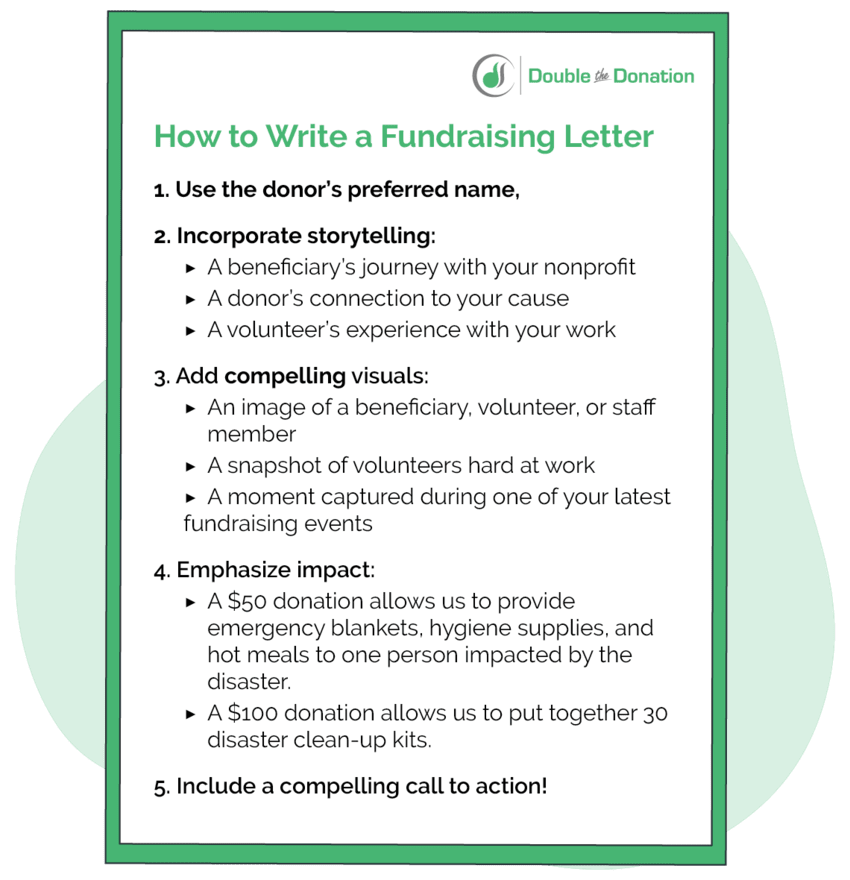
- Address the donor by their preferred name. Including the recipient’s name demonstrates that you value their support as an individual, rather than a nameless source of revenue.
- Incorporate storytelling. Make it easy for potential donors to understand the importance of your mission by sharing a story that elicits empathy and demonstrates how your nonprofit makes a real difference in the lives of those you serve. For instance, a wildlife rescue nonprofit might introduce an injured fox that it’s working to rehabilitate and release.
- Add compelling visuals. Adding an image or two can immediately grab the attention of your recipients, enhance your messaging, and allow them to better understand why they should contribute to your cause.
- Emphasize the impact of donations. Empower potential donors to act by situating them at the center of your nonprofit’s impact. Be specific as to how their gifts will further your mission. For example, a nonprofit that trains and provides assistance dogs to military veterans might communicate that a $25 gift will provide a month’s worth of food for one dog, and a $100 gift will cover all of its vaccination costs.
- Include a call to action. Once you’ve emphasized the importance of donations, use a call to action to encourage recipients to act immediately. Then, include a link to your donation page or, if you’re sending the letter via direct mail, add a QR code along with a pre-addressed return envelope.
To make your fundraising appeals stand out from the crowd, consider sending them as fundraising eCards . These online cards provide an efficient, memorable, and sustainable way to engage your supporters—not to mention they’re low-cost.
Now that you have a clearer understanding of what it takes to draft a compelling fundraising letter, let’s take a closer look at some common types and templates that may come in handy:
1. Nonprofit Fundraising Letters
What are nonprofit fundraising letters.
Nonprofit fundraising letters are typically sent by charitable organizations to individual donors and/or prospects in order to solicit donations for a cause. They can be sent on their own or included in a welcome packet that contains pamphlets, booklets, and additional information.
Typically, an effective donation request letter will include:
- A summary of your mission and vision
- How you’ll use donated funds
- A direct and specific call to action that creates urgency
Bonus: We suggest giving donors the option to reply to your letters by mailing a traditional check or directing them to give through your organization’s website .
To whom should you send them?
Send your nonprofit fundraising letters to anyone in your network of support, including:
- Current and past supporters
- Prospective donors
- Event attendees
- Board members
In other words, reach out to anyone who has previously expressed interest in your cause. Tailor your messaging to different groups based on their relationship with your organization. Keep in mind that while older generations of donors may prefer direct mail communications, younger millennials and Gen Z supporters may prefer a digital approach.
When should you use them?
You can send nonprofit fundraising letters at any time of the year! However, they are particularly effective toward the end of the calendar year when donors are calculating their pre-tax season finances. People also tend to be more charitable in December , which means that your appeal has a better chance of securing a donation.
Nonprofit fundraising letter template
Dear [Donor], [Begin with an emotional appeal: A success story or a narrative that tugs on donors’ heartstrings and hooks your readers. Keep it short and sweet, though!] Our community/nation/world is facing [problem(s) your organization aims to solve]. While we are actively [insert current solutions or related programming], we need your help to make our efforts go even further. Your support is crucial to our efforts to improve the world around us by [tangible steps toward your overall mission]. We’d love it if you could make a donation of $[suggested amount] to help us achieve our mission and [solve the problem]. Thank you in advance for your contribution. Your donation will go toward [insert ongoing effort, recent accomplishment, or current project]. Here are the ways you can make a donation: Donate online at [URL to donation page] Call us at [phone number] Send a check in the pre-stamped envelope Text [keyword] to [text-to-give phone number] Thank you again! Sincerely, [Signature of Organization Leader] [Name of Organization Leader] [Title] [Nonprofit] P.S. [End with an update about an upcoming event, volunteer opportunity, or other information on how to get further involved].
Nonprofit fundraising eCard example
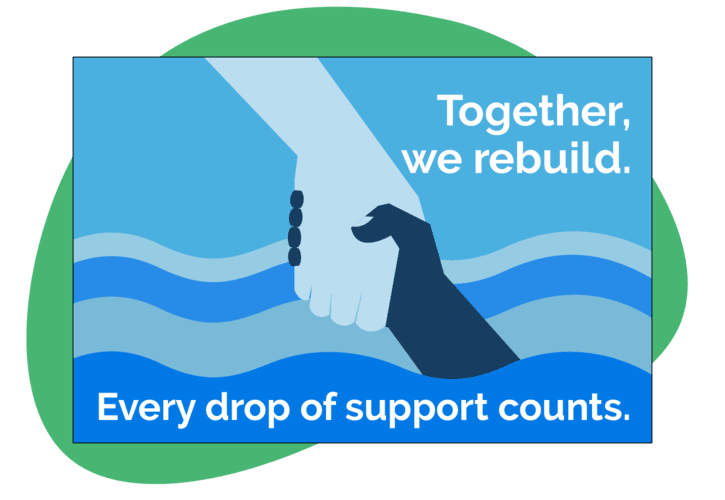
The eCard above depicts two hands uniting through flood waters. This creative design is ideal for a disaster relief organization seeking support for communities affected by flooding. While a simple design, the hands communicate the impact just one donor could have.
2. Seasonal Fundraising Letters
What are seasonal fundraising letters.
Seasonal fundraising letters are sent during specific times of the year and are typically aligned with holidays, annual events, or seasons that hold significance for the cause or donors.
These letters play into the emotional and thematic connections associated with specific seasons to engage donors and encourage contributions. Since these fundraising letters are time-oriented, the timing and context help foster a sense of urgency and prompt recipients to take action.
These types of fundraising letters are ideal for anyone who’s shown interest in your cause, including:
- Existing donors
- Lapsed donors
If you’re sending a holiday-themed letter, just make sure that the recipient celebrates the holiday. For example, you wouldn’t want to send a Christmas card to someone who celebrates Hanukkah instead.
By considering the timing of each seasonal fundraising letter, you can maximize the impact of your outreach and encourage meaningful contributions. Key times to send seasonal fundraising letters include:
- Around holidays: From Valentine’s Day to the Fourth of July, any holiday is the perfect time to send a solicitation letter. Whether you’re fundraising during Christmas , Mother’s Day, or Thanksgiving, you can encourage people to give back.
- At year-end: Considering that December accounts for 30% of annual giving , the end of the year is the perfect time to send seasonal fundraising letters. Capitalize on the spirit of giving during the year-end holiday season, and emphasize the importance of making a last-minute tax-deductible donation.
- During cause awareness months: Determine if there’s an awareness month, week, or day devoted to your cause. If so, send fundraising letters during that time. For example, Breast Cancer Awareness Month is October, Earth Day is April 22nd, and National Suicide Prevention Week falls in September each year.
- Back-to-School (August/September): As the school year begins, nonprofits focused on education or youth development can send letters that emphasize the importance of investing in children’s futures.
- Summer Campaigns (June-August): Summer months can be a great time to send letters, especially for environmental causes, youth programs, and other outdoor initiatives that align with the season’s themes of growth, adventure, and relaxation.
There are plenty of other times you can send your seasonal fundraising letters beyond these. In any case, the timing should align with the occasion’s theme and your nonprofit’s mission. This will ensure the message resonates.
Seasonal fundraising letter template
Dear [Donor’s Name], Greetings from [Your Nonprofit’s Name]! As the [Season] season unfolds, we find ourselves reflecting on the incredible journey we’ve embarked upon and are humbled by the unwavering support of individuals like you who have been a beacon of hope for our cause. This [Season], we are excited to share the remarkable strides we’ve taken toward [Mission]. With your support, we’ve been able to [Highlight a specific achievement, project, or initiative]. We invite you to join us once again in making a profound difference in the lives we touch. Your generosity has been instrumental in [Describe the impact of their previous contributions]. With every dollar you contribute, you are sowing the seeds of positive change and empowerment. As we approach [Specific Occasion or Date], consider making a [Seasonal] donation to [Your Nonprofit’s Name]. Your gift, no matter the size, will help us [Highlight the purpose or project that the seasonal campaign is supporting]. Here’s how you can contribute: Online: Visit our website at [Website Link] to donate. Mail: Fill out the enclosed donation form and send it to [Your Nonprofit’s Address]. Phone: Call us at [Phone Number] to make a donation over the phone. Your belief in our mission is the foundation upon which we build a brighter future. Together, we can create lasting change that resonates far beyond [Season]. Thank you for being a pillar of support for [Your Nonprofit’s Name]. Your generosity is a gift that keeps on giving, and we are deeply grateful for your commitment to making the world a better place. Wishing you and your loved ones a meaningful [Season] season! With gratitude, [Signature] [Name] [Nonprofit]
Seasonal fundraising eCard example

Valentine’s Day is one of the best holidays for sending seasonal fundraising appeals since people are in a loving state of mind. If you need examples to spark your inspiration, the Humane Society of Tacoma & Pierce County designed a collection of Valentine’s eCards that donors could purchase to send to loved ones. Each design featured one of their furry residents, the nonprofit’s logo, heart graphics, and animal puns.
While you can always sell eCards like this, try sending them alongside your fundraising letters to donors!
3. School Fundraising Letters
What are school fundraising letters.
School fundraising letters are a popular way for educational institutions (K-12 and higher ed, public and private alike) to solicit support for various school-related purposes. They generally provide a summary of the school’s specific fundraising needs , such as:
- Upcoming field trips
- Extracurricular activities and clubs
- Scholarships and financial aid offerings
- Educator training and professional development
- New equipment and technology purchases
- Classroom supplies
- Athletic programs and facilities
To maximize results, highlight your school’s recent accomplishments, specify how the funding will make an impact on your student body and community, and provide instructions on how the letter recipient can choose to give.
Send school fundraising letters to your school’s supporters—and those you think may be interested in getting involved. Often, this will include:
- Students’ parents
- PTA members
- Other volunteers
- Community members
You can even take a peer-to-peer approach , encouraging students to send their own fundraising letters to family members and friends who may be interested in giving.
Send your fundraising appeals at any time during the school year!
However, popular campaign periods include the beginning of the school year, leading up to the holiday season, and prior to large-scale events and initiatives.
School fundraising letter template
Dear [Name], We hope this letter finds you well. As we begin the new school year here at [School Name], we are excited to share with you some of the exciting initiatives we have planned for our students. At [School Name], we are committed to providing the best possible education and learning opportunities for our students. We believe every student deserves access to the resources and support they need to succeed, regardless of their background or financial situation. To help us achieve this goal, we are launching a fundraising campaign to support various school-related initiatives, such as [list specific initiatives]. We are reaching out to our dedicated parents, alumni, and supporters to ask for your help in achieving our fundraising goals. Your generosity can make a significant impact on the lives of our students, helping us to provide them with the best possible education and prepare them for a bright future. Any contribution, no matter the size, will be greatly appreciated and put to good use. [Include instructions on how to donate, e.g., online donation platform, mailing a check, etc.] We value your continued support. Thank you in advance for considering a donation to [School Name] and for committing to helping us create a brighter future for our students. Best wishes, [Signature] [Name] [Title]

If you’re designing an eCard for school fundraising, create an engaging design like the one above. Your eCard platform will likely provide plenty of graphics related to education, like graduation caps, apples, and anything else you need. Be sure to incorporate childlike elements like handwritten font to make your design more authentic.
4. Church Fundraising Letters
What are church fundraising letters.
Church fundraising letters can take many forms. They can be used to ask for general church-related contributions , as well as fundraising efforts such as:
- Charity auction item requests
- Fundraising event donations
- Sponsorship requests
- Mission trip funding
- Church building funds
- Missionary support
Churches commonly send out fundraising letters to notify congregants when church events or other fundraising initiatives are occurring. These types of fundraising letters can be used to share the details—date, time, location, etc.—of the event and encourage those who can’t attend to give in advance.
Depending on your specific needs, you can send church fundraising letters to your congregation or to a broader community audience.
For instance, a fundraising appeal to collect donations in support of a new church building will likely be sent only to those involved with the church, while a campaign to raise funds for sending youth to a summer camp might solicit donations from students’ family members and friends, regardless of their affiliation with your ministry.
You can send out church letters whenever you have a fundraising need! Churches rely on the generosity of their congregants to keep the doors open and the lights on.
Of course, you’ll want to limit your fundraising letters to a few per year and rely on in-person appeals during a church service for the majority of your fundraising efforts.
Church fundraising letter template
Dear [Name], We hope this letter finds you well. Because you’re an important part of our church family, and we’ve so appreciated your support in the past regarding our [example campaign the individual supported] initiatives, we thought you’d want to know about our big plans for this new year. As you surely know, our congregation is growing. Just like any family, the more members you have, the more room you need. We’re pleased to invite you to be an important part of this exciting process! [Church Name] is raising money for a brand-new sanctuary and bell tower. How blessed are we to have so many members like yourself that we need to build an entirely new structure? That said, we are currently accepting donations that will make this exciting new project possible, and we ask that you consider giving to support our efforts. Your donation, no matter the size, will be greatly appreciated and put to good use. We invite you to be a part of this new chapter in our church’s history and help us create a space where we can come to worship, learn, and grow together. If you would like to contribute, please visit our website at [URL] or mail or drop off a check to [church office address]. Feel free to reach out to our special projects coordinator, [Name], at [phone number] or by email at [email address] if you have any questions about our fundraising initiatives or the new sanctuary or bell tower. As always, have a blessed week. We hope to see you Sunday! In Him, [Pastor’s Signature] [Pastor’s Name]
Church fundraising eCard example

When designing an eCard for a church, be sure to infuse spiritual elements like this eCard does. The graphic on the card design shows stained glass in the shape of a cross, helping the reader to draw a connection between eCard Recipients will immediately understand what the rest of the email is about by simply reading “In Every Act of Giving, We Feel God’s Grace.”
5. Individual Fundraising Letters
What are individual fundraising letters.
Nonprofits aren’t the only ones with fundraising needs! Sometimes, individuals aim to raise money for a cause, project, or life event, whether on their own or as part of a peer-to-peer fundraising campaign.
Common individual fundraising letter needs include:
- Personal medical expenses
- Disaster relief
- Political campaign funding
- Grassroots advocacy needs
- Travel or education expenses
Make it as easy as possible for supporters to contribute. You can set up a crowdfunding campaign to supplement your fundraising efforts and use the fundraising letter to direct people to your campaign page to give. This can be highly impactful, as in North America alone, crowdfunding generates around $17.2 billion each year .
Depending on the specific fundraising need, an individual may send personal fundraising letters to their family members, friends, acquaintances, colleagues, and more.
Consider tailoring your recipient list based on the purpose behind your efforts. For example, an individual raising funds to go on a religious mission might prioritize individuals within their church community.
You can send individual fundraising letters whenever you need to raise money for a cause that means a lot to you. If you’re collecting donations for an upcoming event or project, be sure to start planning, drafting, and sending your letters at least a few weeks in advance.
Individual fundraising letter template
Dear [Donor], My name is [Name], and I am [describe your position/situation/background]. I am looking to raise [amount of money] to help me pay for [project/expense/cause/etc.]. [Include information about why the cause or project is important to you and how it could potentially impact the reader or those you serve]. I’m writing to ask you to support me and my [cause/project/etc.]. Just a small donation of [amount] can help me [accomplish task/reach a goal/etc.]. Your donation will go toward [describe exactly what the contribution will be used for]. [When possible, add a personal connection to tie the donor to the cause. For example, if you’re raising money to help build a school in a developing country and you’re writing to a teacher, emphasize the fact that everyone deserves a quality education]. Thank you in advance for your contribution. You have no idea how much it means to me to have your support. Here are the ways you can make a donation: Donate online at [URL of your crowdfunding page] Send a check in the pre-stamped envelope I’ve included Thank you again! Sincerely, [Signature] [Name]
Individual fundraising eCard example

While you can use drawings and graphics for individual fundraising eCards, you’ll evoke emotional connections by featuring a picture of who the donations will impact. This eCard is the perfect example of this strategy in action! The sender draws an emotional reaction instantly and can use their fundraising letter to dive into storytelling and their request for support.
6. In-Kind Donation Request Letters
What are in-kind donation request letters.
In-kind donation requests are often sent by nonprofit groups that ask for gifts of tangible goods or services instead of traditional monetary donations.
Most often, these letters will request a specific gift from the recipient, such as:
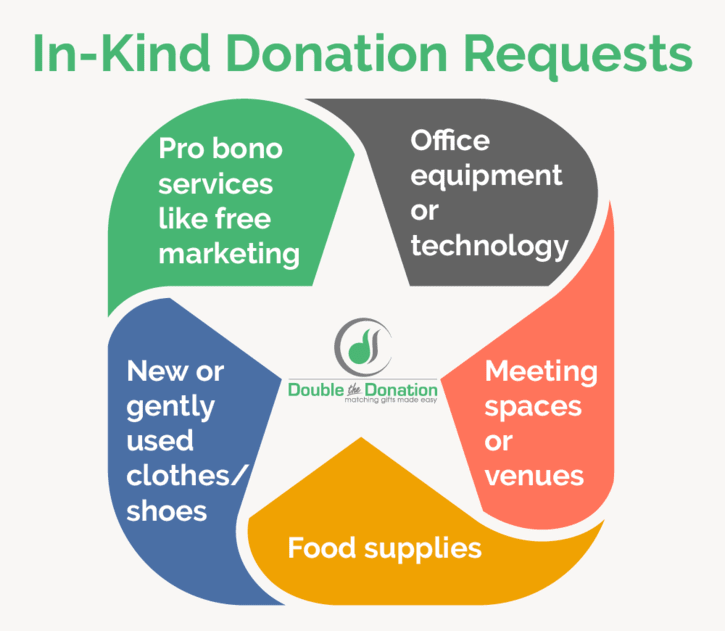
- Office equipment or technology
- No-cost meeting spaces or venue rentals
- Food supplies
- New or gently used clothing or shoes
- Pro bono services like free marketing, accounting, or legal assistance from an associated firm
In-kind donations can allow charitable organizations to offset some of their largest operational costs with goods and services made available by supporters. A well-written donation request letter lets your audience know what kinds of things you’re looking for and how they can be of assistance!
You can send in-kind donation letters to individual supporters as well as corporations, foundations, and even other nonprofit groups.
Remember: these letters should be specific. If you’re seeking free marketing assistance , be sure to reach out to a local marketing agency. If you’re looking for appealing items to auction off in your upcoming fundraising event, you might reach out to a wider range of individuals or businesses. This might include restaurants, travel agencies, salons, retail stores, and more.
You can send these types of letters whenever you have a specific need! Some of the most common use cases include fundraising events (e.g., requesting auction item donations), community food or clothes drives, or a new campaign or initiative that would benefit from in-kind gifts.
In-kind donation request letter template
Dear [Individual Donor or Corporate Sponsorship Manager], I hope this letter finds you in good health and spirits. I am writing to request your support for [Nonprofit], a nonprofit organization that is committed to [mission statement or general purpose of the organization]. As we strive to fulfill our mission, we rely heavily on the generosity of donors like you. We are reaching out to request an in-kind donation of [specific goods or services needed], which we believe would make a significant impact on our efforts by [description of benefits made available by such a donation]. Your contribution would be an invaluable asset to our organization and would help us to [achieve a specific goal or outcome]. In return, we would be happy to offer [recognition or publicity for the donor, such as inclusion in event materials or social media shoutouts]. We will also provide a receipt for the value of the donation for tax purposes. We appreciate your consideration of our request, and we welcome the opportunity to discuss this further with you. If you have any questions or need further information, please do not hesitate to contact us at [phone number or email address]. Thank you for your generosity and support. Sincerely, [Signature] [Name] [Title] [Nonprofit]
In-kind donation request eCard

This eCard is perfect for food banks seeking in-kind donations of food. Within the design, the depiction of people working together communicates the collective effort necessary to end hunger. The text really drives that point home by saying, “From your pantry to their plates, every meal matters.” In turn, the organization can retain donors by emphasizing the vitality of their continued support.
7. Matching Gift Fundraising Letters
What are matching gift fundraising letters.
Matching gift fundraising letters are a specific type of outreach that nonprofits send donors to inform or remind them about relevant matching gift opportunities.
Matching gifts are a popular (yet continually underutilized) type of corporate giving program. In fact, it’s estimated that $4 to $7 billion in matching gift funds goes unclaimed every year. The process typically follows these basic steps:
- After an employee donates to an eligible nonprofit, they submit paperwork to their company to match
- If the donation meets the company’s predetermined requirements , the business will make a contribution to the nonprofit as well.
- Though companies often match gifts at a dollar-for-dollar ratio, many are willing to triple or even quadruple their employees’ gifts!
Unfortunately, many donors are unaware that their employer offers a matching gift program.
That’s where a matching gift fundraising letter comes in!
In this letter, you’ll inform the donor about their employer’s specific workplace giving initiatives and how to get involved. If you don’t have a record of a supporter’s employer, simply use your matching gift letter to direct them to your online matching gift web page and company search tool.
All donors should receive matching gift letters after making their initial gifts to your organization.
However, since direct mail can be costly, we recommend sending email follow-ups to the majority of your supporters. Reserve your direct mail letters for your most lucrative matching opportunities or for particularly high-value donors who have a known preference for physical communications.
The best time to promote matching gifts is immediately after a donor gives. Your nonprofit is still fresh in their minds, so they’ll be more likely to submit a matching gift request when encouraged to do so promptly.
After a donor makes a gift, send out an email that:
- Thanks them for their donation
- Encourages them to submit a matching gift request
Furthermore, you can consider leveraging matching gift auto-submission to streamline the process even further and make it easier for donors to submit their requests. Once they’re determined to be eligible for matching gifts, all they need to do is provide a few key pieces of information, and the software automatically completes the request for them. Check out this video to see how auto-submission simplifies the match-fulfillment process:
Matching gift fundraising letter template
Dear [Donor], Thank you for your generous support in the amount of $[gift size]. Your donation is helping us make a real impact in the lives of those we serve. We wanted to let you know about an exciting opportunity to make your gift go even further. Did you know that many employers offer matching gift programs? This means that they will match their employees’ charitable donations, doubling or even tripling the impact of your gift. We encourage you to visit our matching gift page here [URL] to see if your employer participates in a matching gift program. This resource provides an intuitive company search tool with easy-to-follow instructions on how to take advantage of this opportunity and make your donation do more. By taking a few minutes to submit a matching gift request, you can make an even greater impact on our mission. Thank you again for your generous support, and we look forward to continuing to work together to make a difference in the lives of those we serve. Sincerely, [Signature] [Name] [Matching Gifts Coordinator] [Nonprofit]

8. Event Fundraising Letters
What are event fundraising letters.
A fundraising event can be a highly impactful way for nonprofits to generate revenue. However, before the event takes place, it’s crucial to mobilize donors and the greater community to participate.
You can achieve this through event fundraising letters. These letters provide details about the event and encourage the recipient to attend in support of the nonprofit’s mission.
When drafting the letter, include a clear and persuasive case for support, as well as an explanation of how funds will be raised during the event (for example, through ticket sales, donations, or auction bids). A well-crafted fundraising event letter should make the reader feel enthusiastic about supporting the cause and eager to register for the event.
For an in-person event, send fundraising letters to all of your organization’s supporters who reside in your local area. However, hybrid and virtual events open up the possibilities, allowing your team to engage attendees over any distance.
As you craft your recipient list, include donors, volunteers, board members, previous event attendees, and even businesses that have interacted with your organization in the past.
Send your fundraising letters well in advance of your event date. While the perfect timeline can vary from one organization to the next, aim to notify your supporters at least six to eight weeks before the big day. This will allow them to make any necessary arrangements for attending and enable your nonprofit to maximize the overall turnout.
Event fundraising letter template
Dear [Supporter], I hope this letter finds you well. I am writing to invite you to [Nonprofit]’s upcoming event, [Event Name], which will take place on [date] at [time] at [location]. [Event Name] is a [type of fundraising event, like run/walk/ride, charity auction, gala, etc.]. This annual fundraising event helps us to raise funds for our organization, [Nonprofit], which is dedicated to [summary of mission statement or purpose]. We believe that every member of our community deserves access to [insert services provided by your organization], and your support helps us to achieve this goal. We have exciting activities planned for the evening, including [details about the event such as entertainment, keynote speakers, or other activities]. And the best part is that all proceeds go towards supporting our programs and services. We would be honored if you could attend this special event and support our cause. Your ticket purchase or donation will help us make a difference in the lives of those we serve. Learn more about the opportunity at our event page here [URL]. We appreciate your consideration and hope that you can join us for this meaningful evening. Thank you for your support. Sincerely, [Signature] [Name] [Title] [Nonprofit]
Event fundraising eCard example

Designed by Vineyard Church North Phoenix , this event invitation was originally designed for congregants to invite their friends and family to an upcoming service. However, you can copy their approach by featuring photos you’ve taken and featuring welcoming text such as “You’re Invited” or “Join us!”
9. Recurring Gift Fundraising Letters
What are recurring gift fundraising letters.
Recurring donations provide nonprofits with steady and predictable income that allows them to plan for and maintain effective operations over time. In fact, recurring donors contribute 42% more each year than one-time donors. Whether you’re looking to expand your recurring gifts program or get started for the first time, well-written recurring donation letters can be immensely useful.
Recurring donation letters are tailored to appeal to dedicated supporters who may be interested in supporting your cause on a regular, automated schedule. These letters should provide an overview of the benefits of recurring gifts (for your mission as well as for the donor) and provide instructions on how they can sign up if interested.
Send recurring gift letters primarily to donors who have already recently supported your cause, especially those who have made several one-off donations. However, first-time donors can also be good candidates for these programs if they’ve shown a commitment and a willingness to support your cause in the past.
You should send a recurring donation letter to an existing supporter after they contribute a one-time gift to your organization—ideally within a few weeks following the most recent donation.
Additionally, you might decide to host a “recurring gift campaign” and promote your monthly giving program to all supporters. This can take place at any time during the year but may be particularly effective during the end-of-year holiday giving season. You can even set and communicate a goal for the number of recurring donors you’d like to sign up by a target date to drive urgency and leverage a sense of social proof.
Recurring fundraising letter template
Dear [Donor], I hope this letter finds you well. I wanted to reach out to you about joining [Nonprofit]’s recurring gift program. By setting up a recurring gift, you can provide ongoing support for our mission to [summary of mission statement or purpose] and provide services for [primary audience benefitting from your organization’s programming]. Recurring gifts are a convenient and effective way to support our organization. By making a regular monthly gift, you can help us to offer [list specific services provided by your organization] to those in need. To sign up for the program, go to our website here [URL for recurring donation page] or text [recurring donation keyword] to [fundraising shortcode]. Thank you for your generosity. Sincerely, [Signature] [Name] [Title] [Nonprofit]
Recurring gift fundraising eCard example

Imagine you receive a fundraising letter paired with an eCard of a cute dog with pleading eyes. Wouldn’t you be compelled to donate to whichever animal rescue organization sent it to you? Try creating a greeting card like the one above and featuring text that communicates the impact of ongoing support.
10. Capital Campaign Fundraising Letters
What are capital campaign fundraising letters.
A capital campaign is a fundraising initiative that aims to meet a high-dollar goal over a relatively long time frame (often one to three years). Dedicated fundraising letters are an excellent choice for soliciting support for this campaign.
This letter should explain the purpose behind the dedicated fundraising effort, which is often used to reach a significant goal. Oftentimes, nonprofits launch capital campaigns to collect funding to build a new facility, purchase high-cost equipment, or establish an endowment fund, so you’ll want to specify the need and how it will impact your cause as a whole.
Capital campaign letters are generally sent to your nonprofit’s existing donors. And don’t count them out if they’ve recently given to a different fundraising initiative, either. A capital campaign donation is generally considered an “above and beyond” contribution. Just be sure to acknowledge their other gifts and explain how the efforts are differentiated.
To produce optimal campaign results, segment your contact list according to donors’ previous engagement with your organization, giving history, and estimated capacity to give.
Since a capital campaign is split into two key phases (the Private Phase and the Public Phase), it’s important to understand when you should employ your fundraising letters.
Generally, the Private Phase kickstarts your campaign by exclusively engaging major donors , board members, and other particularly high-value individuals. While you may opt to utilize capital campaign letters as a cultivation or stewardship strategy in this phase, you’ll likely make your largest asks in person (or, at the very least, over the phone). Nonprofits typically raise at least 75% of their goals in this phase.
Once you get to the Public Phase, however, your well-crafted fundraising letters can be an excellent tool for driving your campaign to the finish line with donation appeals sent to low- and mid-level supporters.
Capital campaign fundraising letter template
Dear [Donor], On behalf of [Nonprofit], we are excited to announce a new and exciting capital campaign. And we’d like to invite you to join us in our efforts! This large-scale fundraiser has a lofty goal of $[fundraising goal] to [summary of campaign purpose]. As you know, our organization is committed to [brief description of mission]. With your support, we’ve been able to make great strides in these areas, but we know that there is still much work to be done. That’s why we’re launching this campaign to raise the funds we need to [reiterate campaign purpose], which will have a transformative impact on our ability to fulfill our mission. This is a critical time in our organization’s history, and we need your support to make our vision a reality. We believe that with your help, we can [describe the impact of the campaign, such as improving the lives of those we serve, expanding services, etc.]. This campaign will span over the next three years, and we are committed to transparency throughout the campaign. We’ll provide regular updates on our progress and milestones achieved. We appreciate your consideration and hope that you can join us in this important endeavor. Thank you for your support. Sincerely, [Signature] [Name] [Title] [Nonprofit]
Capital campaign fundraising eCard example

Capital campaigns require substantial amounts of support. If you’re building something, try including a stock photo of blueprints or actual project renderings on your nonprofit eCards . This will show you’re serious about the end result and your plans are already underway. You can also include a witty phrase like “Lay the foundation for tomorrow” or “Help build our future.”
11. Annual Fund Fundraising Letters
What are annual fund fundraising letters.
An annual fund is a nonprofit’s ongoing fundraising campaign that seeks to collect unrestricted funds—money not set aside for a particular project or program—for the organization. These funds often cover facility costs, staff salaries, and other “non-mission related” expenses. Annual fund fundraising letters solicit donations that go toward the fund.
These letters should focus primarily on the good work your organization is doing, highlighting recent, ongoing, and future projects made possible by generous donor funding.
Just about anyone who has shown interest in your organization and its mission can be a great candidate for your annual campaign fundraising letters! This includes:
- Prospective donors in your pipeline
- Newsletter subscribers
- Social media followers
You can also send these letters to try and re-engage lapsed donors, so consider sending your annual fund letters to that segment as well.
An annual fund is typically a never-ending initiative with no set “finish line,” so organizations often collect donations for their annual funds year-round!
Aim to have a few annual fund pushes throughout the year to devote a good deal of time and resources toward driving support for the campaign. Then, you may decide to send one-off annual fund letters as a way to engage new supporters as they get involved with your cause.
Annual fundraising letter template
Dear [Donor], I am writing to you on behalf of [Nonprofit] to invite you to support our annual fund campaign. Your donation helps us to provide [summary of services provided by your organization] to those in need. Plus, it allows us to continue our mission to [brief overview of mission statement or purpose]. This year, we aim to raise $[fundraising goal] from generous donors like you. We collected a record $[funds raised in the previous annual fund campaign] for our annual fund, and I think we can surpass it this year. We appreciate your ongoing support and hope that you can consider making a donation to our annual fund campaign today. If so, please mail a check using the enclosed pre-stamped and pre-addressed envelope or make an online donation by scanning the QR code below [QR code redirects to your online giving form URL]. Thanks again for your generosity. Sincerely, [Signature] [Name] [Title] [Nonprofit]
Annual fund fundraising eCard example
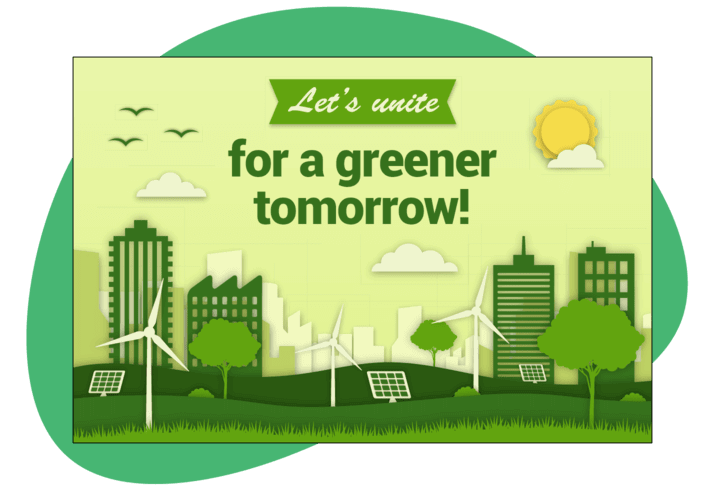
This eCard is perfect for an environmental organization to solicit donations year-round. It features a nature-inspired design complete with green, Earth-themed graphics. An alluring eCard like this can help capture attention for your fundraising letter.
12. Corporate Sponsorship Letters
What are corporate sponsorship letters.
Corporate sponsorship letters are used by nonprofits, schools, or other organizations looking to receive support from for-profit companies for a specific project or event.
Though they can vary depending on the company or nonprofit, sponsorship letter packages typically include the following components:
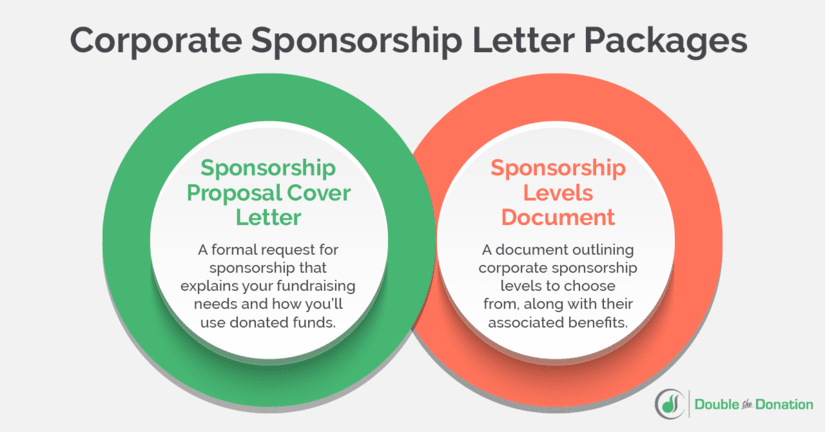
- A sponsorship proposal cover letter, or the formal request for a sponsorship donation. It explains the nonprofit’s fundraising need and details how the funds will be used.
- A sponsorship level document , which determines how companies decide how much they’d like to give. This resource often lists a few sponsorship levels to choose from and the perks that come with each. The higher the donation, the more perks the company receives.
Plus, there’s typically a sponsorship acknowledgment letter sent afterward to thank the company for its contributions.
Send your corporate sponsorship request letters to any businesses with which you’re interested in partnering. A few ways to locate top prospects include identifying companies already in your network, such as your donors’ employers and top matching gift-givers, local businesses in your own community, and companies known for being particularly charitable .
Sponsorship letters should be sent out well in advance of your event or project. This gives companies enough time to consider and respond to your donation request.
Furthermore, your nonprofit should send sponsorship acknowledgment letters immediately after a donation has been made and after the event has ended.
Corporate sponsorship letter template
Dear [CEO/CSR Manager/Business Owner], I am writing on behalf of [Nonprofit], an organization dedicated to [summary of your mission, vision, and how you serve your community]. We are hosting our [event name] on [date] at [location]. Last year’s event was such a huge success that we decided to host it again! In the past, this event has raised $[amount] and has [list out specific accomplishments using statistics and figures]. This year we’re hoping to raise even more! Our goal is $[amount], and we were hoping you could help us reach that goal. By becoming one of our corporate sponsors, you’ll be able to [list projects that corporate donations could help accomplish]. We’ve also listed out some of the incentives and perks that your company can enjoy should you decide to become one of our corporate sponsors in our attached Sponsorship Levels Document. Regardless of the amount you choose to give, your company name will be included in our event program, and you’ll be mentioned in the press release that we’ll publish on our website. We’re accepting cash donations as well as gifts-in-kind of goods or services. Please browse the Sponsorship Levels Document to find the giving level that’s right for your company. If you’re ready to make a donation, tear off the perforated section of the following document and send it back to us in the self-addressed envelope we’ve enclosed. I’d like to thank you in advance for your generosity. Please don’t hesitate to contact me directly at [phone number] or [email] if you have any questions. All the best, [Signature] [Name] [Title] [Nonprofit]
Corporate sponsorship eCard example

Connect with prospective sponsors on an emotional level by including images of your beneficiaries. You can showcase their situations and make your case for support that much more compelling when sending your sponsorship letters.
13. Donor Thank-You Letters
What are donor thank-you letters.
Donor thank-you letters are pretty self-explanatory. These letters (or emails!) thank supporters for their contributions to a recent fundraising campaign. Sending personalized gift acknowledgments is an excellent way to deepen your relationship with supporters and keep your cause at the forefront of their minds.
Best practices for effective thank-you notes include:
- Greeting the recipient by name
- Acknowledging the donor’s specific means of support
- Addressing the impact made possible through their gift
Plus, you can share additional involvement opportunities ( without asking for another gift ). Encourage supporters to follow your social media pages, subscribe to your newsletter, or request a matching gift from their employer!
Send thank-you letters to all of your supporters. In addition to traditional donors, this includes volunteers, in-kind givers, corporate sponsors, peer-to-peer fundraisers, matching gift donors, and more.
Thank-you letters should be sent out as soon as possible after receiving a contribution. Ideally, this should be done within 48 hours of the initial gift being made.
It’s not a bad idea to use multiple channels, either. Consider sending an automated acknowledgment email immediately and following up with a tangible note in the days or weeks afterward. You can never be too appreciative of your donors!
Donor thank-you letter template
Dear [Donor], I can’t tell you how much all of us at [Nonprofit] appreciate your generous support of our cause. Thanks to your donation of $[amount], we’ll be able to [list out specific goals, objectives, etc., made possible through the gift]. We are so grateful for your belief in our organization’s work. At [Nonprofit], we are committed to transparency and accountability. Therefore, we’ll be sure to keep you informed about how your donation is making a difference in the lives of those we serve. We couldn’t do it without you! I also wanted to let you know that we’ll be hosting an exclusive donor appreciation event on [date]. We’d love to extend an invitation to you to participate in this opportunity, with more details to come! Our current donors have all enjoyed developing a stronger partnership with our organization, and I’m hoping you’ll do the same. Thanks a million, [Signature] [Name] [Title] [Nonprofit]
Donor thank-you eCard example
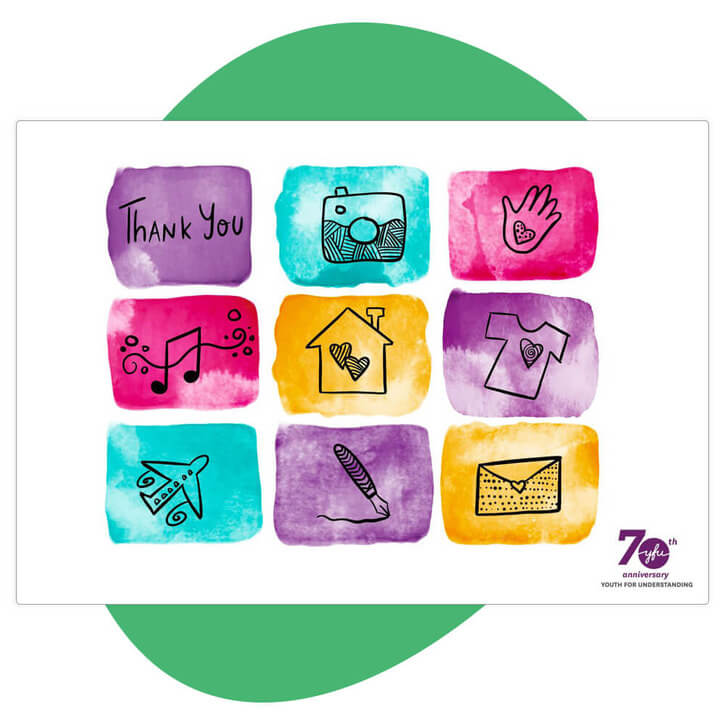
Show donors some love with an eCard alongside your thank-you letters. Youth for Understanding offered several eCards that past beneficiaries could send to thank anyone who made their experience with the organization memorable. Add a custom note alongside an eCard like this, and the recipient will have a thoughtful keepsake that inspires them to keep giving!
14. Fundraising Update Letters
What are fundraising update letters.
Fundraising update letters are post-fundraising campaign communications sent to supporters. These messages allow you to wrap up loose ends, celebrate success, and look to future plans and goals.
This letter should contain a summary of your recent campaign (e.g., event, crowdfunding effort, peer-to-peer fundraiser, capital campaign, etc.) and your overall level of success (whether you reached or exceeded your fundraising goal). Plus, you’ll want to provide additional context, reminding your audience how the funding will be used to further your mission. And don’t forget to thank each recipient for the role they played in driving your fundraising efforts forward.
Anyone involved with your fundraising campaign should receive a campaign update letter! This includes donors of all giving levels, volunteers, corporate sponsors, peer-to-peer fundraisers, and more who made your fundraising success possible.
You might even decide to send fundraising update letters to existing supporters who opted not to partake in your fundraiser. This can allow them to stay up to date on organization happenings and celebrate the generosity of their fellow donors.
Like donor thank-you notes, fundraising campaign update letters should be sent as soon as possible. Rather than following each donor’s contribution, however, wait until the entire campaign has wrapped up. Then, send your letters in the following days or weeks to celebrate their support.
Think of this type of fundraising letter as the big finale after your solicitation letters and other engagement efforts!
Fundraising update letter template
Dear [Donor], I wanted to reach out and provide an update on our fundraising efforts at [Nonprofit]. Thanks to your generous support, we were able to surpass our fundraising goal of $[insert fundraising goal] by over $[amount raised beyond your goal]. All in all, we collected $[total raised through the campaign] that is going to make a huge difference in the lives of [primary audience benefitting from your organization’s services]. Now, we will continue to work toward [nonprofit vision] by [list several specific projects or programs receiving funding from the recent campaign]. And we’ve already gotten started! Check out this photo to see how things have been going over here: [Insert picture showcasing your organization’s efforts; ideally, a new project or program. Ex: breaking ground on a new building] We are so grateful for your ongoing support and appreciate your commitment to our mission to [summary of mission statement or purpose]. We could not do this important work without your help. Thank you for your ongoing generosity. Sincerely, [Signature] [Name] [Title] [Nonprofit]

Perfect for an environmental nonprofit, this eCard emphasizes a core mission of rebuilding the planet. It features a nature-inspired design that reminds the recipient of the cause at hand. Then, the sender can use the thank-you letter to provide concrete updates and explain the donor’s role in making the mission possible.

Wrapping Up (& Sending Off!)
Crafting effective fundraising letters is vital to just about any giving campaign. This is true for nonprofits as well as churches, schools, and even individuals.
To make your appeals impactful, it’s essential to understand your recipients and personalize your message accordingly. From there, you’ll want to convey your organization’s mission in a way that resonates with your audience and provide a clear call to action to support your cause.
For more valuable fundraising tips and tricks, check out these additional resources:
- What Is an Email Append? All Your Questions Answered. Want to make sure your fundraising letters are reaching their recipients? Use email appends to keep your supporter contact information accurate and up to date.
- 6 Best Practices for Producing Impactful Matching Gift Videos. Take your matching gift fundraising strategy to the next level by learning how to create informative and effective matching gift videos for your nonprofit.
- Donor Retention: A Comprehensive Guide + 6 Strategies. Set your future fundraising appeals up for success by exploring the key strategies for donor retention in this detailed guide.
![how to write application letter for donation Learn how eCardWidget can help you revamp your fundraising letters and send them as eCards.]](https://doublethedonation.com/wp-content/uploads/2023/08/Fundraising-Letters_Large-CTA.png)
Get started
- Explore our Product
- Auto-submission
- Browse our Integrations
- Meet our Customers
- Get Pricing
- Attend a Demo
The Database
- About the Database
- Add a New Company
- Update Company Information
- Matching Gift Basics
- Volunteer Grant Basics
- Top Matching Gift Companies
- Top Volunteer Grant Companies
- Webinars and Matching Gift Videos
- Meet the Team
- Common Questions
- Trust Center
Request a Quote
Ready to start with 360MatchPro? Request a demo and quote today!

- Apply for a Discount
- Sign Up for Free

- Nonprofit Fundraising
How to write a donation letter
Steps to write a donation letter
- Understand your audience and tailor your appeals accordingly
- Remember that presentation matters
- Pay attention to format and design
- Use the appropriate salutation and a personalized greeting
- Include information about your organization and mission
- Explain the current project, priority, or need
- Share persuasive details about the project’s impact
- Make a specific request
- Add a clear call to action
- Express your gratitude
- Sign the letter
- Proofread and edit your letter before sending it out
Of all the things on your to-do list as a nonprofit professional, attracting donors and raising money to support your organization’s cause are among the most important. And one of the best fundraising tools at your disposal is the tried-and-true donation letter.
In this post, we cover how to write a donation letter and which key components to include. Plus, we’ll share a few examples and templates for writing your own.
The importance of donation letters for nonprofit fundraising
Donation letters and fundraising appeals are obviously essential for soliciting support. Donation letters can also demonstrate your organization’s impact, strengthen relationships with existing donors, build relationships with new ones, raise awareness about your cause, and build trust with donors by showing how their gifts make a difference.
An effective donation letter includes the following key components:
- Your organization’s letterhead or branded email template
- A personalized greeting
- Information about your organization and mission
- The current project, priority, or need that you are seeking to fund
- Specific details about the impact the donation will have
- Your specific request from the donor
- A call to action
- An expression of thanks
Read on for more information on each of these elements in our step-by-step guide on how to write a donation letter.
A step-by-step guide to writing a donation letter
Now that you know the key components to include in your donation letter, let’s look at each element in more detail and go through the steps of writing an effective donation letter.
1. Understand your audience and tailor your appeals accordingly. To ensure you’re writing the most effective donation letters, be sure to customize your fundraising appeals to specific groups of donors rather than sending a donation letter to everyone in your database. You can segment based on donor history, gift amount, recent and frequent gifts, donor age range, and donor type (i.e., annual or cause givers), to name a few categories.
2. Remember that presentation matters. Send donation letters on your organization’s letterhead if you’re mailing a physical letter, or use a branded email template if you’re sending emails. You may also want to include information about your nonprofit’s tax-deductible status and your employer identification number (EIN), as some donors will need this information for tax purposes.
3. Pay attention to format and design. You also want to ensure that your letter uses fonts and colors that are easy to read and in line with your organization’s branding. You can also use images and other visuals to help tell the story of your nonprofit’s mission, impact, and progress, if applicable.
4. Use the appropriate salutation and a personalized greeting. Address each of your donors by their preferred name and include a friendly personalized greeting. People are more likely to ignore letters that don’t include a name or are addressed to “Dear Donor.”
5. Include information about your organization and mission. Share a brief overview of your nonprofit’s overall mission and purpose, as well as the goals you hope to achieve, to give the donor context for the specific request you’re making. Include facts or statistics about your organization’s impact in the community and/or share a story of someone who benefited from your organization’s support. This helps the donor see the direct connection between their gift and its effect in the wider community.
6. Explain the current project, priority, or need. While there may be times when you’re raising funds for operations and general expenses, a donation request letter is most compelling when it’s geared to a specific project, priority, or need. In this section of the donation letter, explain the specific project or need you’re seeking funds to support.
7. Share persuasive details about the project’s impact. These should help you explain why you’re asking for support. Describe the project or need and how funding for it will positively impact the community. Explain exactly how the donor’s contribution will make a difference and why this program is so important. Communicate a sense of urgency to help them understand why they should take action now.
8. Make a specific request. A donation letter isn’t the way to make generic requests. Ask for a specific amount, but also share how grateful your organization will be for any support. For example, an environmental organization could say, “Your donation of $50 will support one day of waterway cleanup and help us buy the necessary supplies,” or a nonprofit that helps support school-age children could suggest, “Your $25 donation will provide school supplies for one local student in need.”
9. Add a clear call to action. Finish your letter with specific next steps you’d like the potential donor to take. If you’re sending a physical letter, provide instructions on how to make a donation (e.g. where to send a check). For an email, you can simply include a link to the appropriate donation page on your website. You want to make this step as effortless as possible, so provide several ways for them to give, and be sure to provide clear instructions for each.
10. Express your gratitude. End the communication by thanking your donor for their time and attention. Thank them for helping your organization reach its fundraising goal, for the support they’ve provided in the past, or for the current donation they’re considering.
11. Sign the letter . Don’t forget to include your contact information.
12. And finally, proofread and edit your letter before sending it out. This step ties directly to the goal of making a great first impression on your donors.
Examples of successful donation letters
Before you write your own donation letter or fundraising appeal, it might be helpful to study examples of real donation letters that have gotten results for their organizations. We’ve rounded up a few examples of successful donation letters here.
Check out 10 letters that raised funds for nonprofit organizations , including a letter that got a 100 percent response, the well-known United Negro College Fund letter, and a successful United Nations fundraising letter, among others.
To get the behind-the-scenes story of one of the most successful fundraising letters ever written (and see the letter itself), check out the story of the Sea Turtle Rescue Fund letter Richard Armstrong wrote for the Center for Environmental Education.
If you’re looking for templates, you’ll find several donation letter templates here , including a standard donation request letter, sponsorship request letter, peer-to-peer campaign letters, and more. And for even more ideas, check out 14 different kinds of fundraising letter templates here .
Donation and fundraising resources from Jotform
Jotform offers a robust selection of easy-to-use, no-code donation and fundraising tools to help your nonprofit organization raise money, including free donation forms and donation apps . With the Donation Box feature in Jotform Apps, you can collect donations through over 30 payment gateway integrations, display a fundraising goal progress bar, and customize donation amounts.
You can also use our customizable donation request letter template to make donor requests. You can fill in the fields with details about the recipient, your organization, the project that needs funding, and accepted donation methods. Share the letter with potential donors via email, and they’ll be able to e-sign it from any device using Jotform Sign .
And because we believe in supporting those who make a difference, Jotform also offers a 50 percent discount to nonprofits on our paid plans .
Learn more about creating professional-looking forms with our nonprofit forms and templates , read about how to start a nonprofit , learn how to run a successful nonprofit fundraising campaign .
When it comes to requesting — and receiving — donations to support your organization’s good work in the community, Jotform wants you to have every resource you need at your fingertips. By following the donation letter tips here, you should be well on your way to a successful fundraising campaign.
Photo by Gustavo Fring
Thank you for helping improve the Jotform Blog. 🎉

RECOMMENDED ARTICLES

Nonprofit Fundraising: Guide to Running a Successful Campaign

Perfecting your year-end fundraising: 6 essential tips

How to make a fundraising calendar
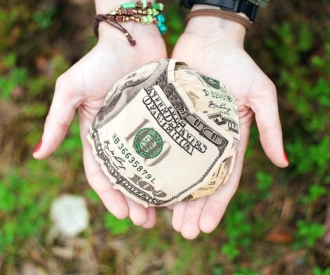
100+ charity fundraising ideas

Top 10 fundraising software solutions for nonprofits

Create a Great Donation Form for #GivingTuesday

5 steps for better online fundraising

The top 15 online fundraising platforms for nonprofits

5 of the best event ticketing software tools for nonprofits
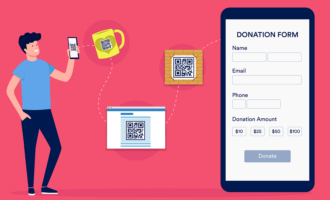
How to use QR codes to maximize donations

28 virtual fundraising ideas for nonprofit organizations

Apple Pay for nonprofits: How to accept donations

How to host a successful virtual fundraiser

Webinar: 4 nonprofit forms you need to level up now
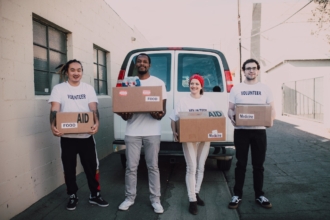
DonorScape vs WealthEngine
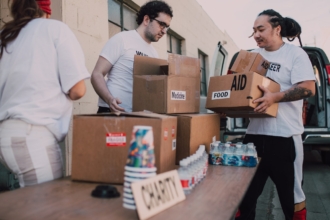
DonorSearch vs WealthEngine: Which is better?

Fundraising during a crisis: 4 tech tips to weather COVID-19

25 great PTA fundraising ideas

How to create a donation page

How to create a fundraising page
Send Comment :

Published In: Letters
How to Write the Perfect Donation Letter (Sample Letters)
In recent years, there has been an unprecedented increase in the number of fundraising activities. More and more people have come forward to join non-governmental organizations (NGOs) and similar charities to help unfortunate people. Non-profit organizations, including fundraising activities, fundraising ideas may differ in their concepts and practices.
However, donation letters, whether at the personal level or the corporate/business level, are an essential tool for raising funds. A detailed guide about the donation letter will give you an overview of what you must write in the donation letter.
What is a Donation Letter?
A donation letter is a letter that can be written by an individual or organization to ask for donations from other individuals or organizations. Most of the donation letters are written for some humanitarian cause. The nature of the contribution requested can be different.
Types of Donation Letter
There are two main types of donation letters. They are:
Personal donation letter
An individual writes this type of donation letter. It can be written to request donations from either an individual or organization. If you are writing on behalf of an organization, it will be considered a personal donation letter.
Corporate donation letter
A non-profit organization usually writes this type of donation letter to ask for donations from their mailing list. It can also be reported to an individual or organization like state institutions. If an organization writes a letter on behalf of an individual, it will still be considered a corporate donation letter.
Formatting Your Donation Letter
The first paragraph and the Post Scriptum are usually the most read parts, and on which the most attention falls: for this reason, they should not be neglected. They must express what you want to communicate and contain a donation request.
Also, to guide you in reading, you can make use of different fonts such as italics and bold. What most values the work of the fundraiser are the reasons behind the efforts he makes. For this reason, even when writing a letter, we must not forget why we are doing it, putting the cause for which we are fighting before everything. A few additional things you must keep in consideration while formating your donation letter are as follows:
- Don’t make it too stuffy
- Indent each paragraph.
- Avoid paragraphs that are longer than seven lines.
- Use bullets to add to your points.
- Use subtitles. If the letter is long, try to center and underline the subtitles.
- Underline sparingly but consistently to draw attention to keywords and phrases.
Whereas the format of your letter must be in the following order:
The first paragraph : Introduce yourself/your organization and the reason for the letter.
Second paragraph : Give brief information about yourself, your association, and how you have a common goal of working with other NGOs to raise funds. It can be divided into two or up to three segments with two segments-3 lines per line.
Paragraph 3 : In the last section, thank the reader for his/her valuable time and briefly summarize your goals for writing this letter. Don’t forget to give your contact information, and your donation can make him/her feel when you contact them.
Attached documents : You can include your organization’s brochures and booklets to explain information about the event.
Elements of Donation Letter
There are a few components that you must form your donation letter on.
These components are as follows:
- Organization / Charitable / Trust Name
- Complete Address
- Dear Mr / Ms. Client / Agency/person personal name of mail being processed
Donation Letter Samples
Here are two donation letter samples that will guide you to write your letter:
Personal Donation Letter Sample
Cancer Care
ABC Street,
4646-464-748
January 18, 202X,
My dear wife, Jenny,
We have a fundraising walk 25 miles Cancer event held in the city. It would be August 2010 Held on June 16.
Participation in this event requires a considerable number of walkers. With the promise, complete this event and propose a minimum donation of 31.45 USD for participation.
This year, I am going! Before this, I participated in such a pursuit. I have been an active member of “cancer care” for the past eight months. I have seen this NGO doing fantastic work for cancer patients.
I have made this promise, and I need your help to meet my goal of contributing $31.45 so that I can participate.
I hope you will support Cancer Care and help them provide intensive care units for cancer patients in our city.
Many organizations out there Raise funds for charity, but I hope you will donate to Cancer Care and help them build much-needed facilities.
I hope I can count on you to help support Cancer Care.
(signature)
abcd_3737 # abchmail.com
Corporate Donation Letter
Christina Molarei
Augustus Montessori School
3535– Park Canal
Park Avenue Road
USA – 474 758
October 7, 202X,
Customer relationship management
South Carolina
United States –575,896
Requirements: arrange a raffle prize
Dear Mr. John,
I am writing this letter to you on behalf of Augustus Montessori school. The school’s cultural team, CreativeFlowers, “planned the annual fundraising event-” Super Sports Event” on December 1, 2021 location. This will include morning and afternoon activities, dedicated to the students and their families will conduct some Sports competitions, track and field are the same as everyone else.
Also, it will be a unique program for parents. In the past four years, we have attracted big companies such as “Champion Bikes,” famous bicycle manufacturing companies and publishing houses, “Reading Fun” is a prize for the winners.
The funds raised in the event will be used to expand our school library facilities.
If you are willing to help us, please direct your donation to the school’s address above. Because we hope you are entirely sure about your donation, you can contact us for more inquiries about our email ID: [email protected] or call any 7474-57547- 6464, from 9 am to 9 pm.
We are very willing to seek your appointment and tell you more about the plan.
Thank you in advance from Augustus Montessori School. We appreciate your time and energy spent in reading this letter.
Best Time to Send a Donation Letter
Writing an eloquently written donation letter is important and so is sending it at the right time. That is why it is essential to consider time while sending a donation letter. The best time to send a letter depends on your targeted audience. However, according to Brady Josephson the best time to send a donation letter is between 6 am to 9 am, or 10 am to 1 pm.
Requesting donations is not an easy task, even for the most experienced. If you get someone to donate your funds regularly, make sure you send a thank you letter for the money sent by such a person.
Tips for Writing a Donation Letter
Often, the people who write these messages need not only to master the language but also to know what things are essential to the recipients of the letters. What factors induce them to act, and what they expect before and after making their contributions.
Use simple words
Don’t pretend to sound more cultured, smarter, or trendier than the reader of your piece. Use simple, ordinary words. No matter how complex the mission of the right public entity you have to make known is, try to put it in day-to-day terms. Don’t be afraid to use words like “donation” … even “alms.” By the way, “alms” in Greek is “eleemosynary, which comes from “éleos,” which means “sharing” and “mercy.”
Remember you are making a letter, not a brochure
Focus on the reader: the “you,” the “you,” or the “you” should dominate the communication agenda, rather than the “we.” For the same reason, tell him things that interest him (or her). Don’t overwhelm him with paragraphs and paragraphs about the history of your institution. Especially if it is already well known.
Write with your heart
Comment on personal experiences, or ask the people who collaborate with the entity, short stories, phrases, sayings, or experiences. Those stories and sensations are invaluable material. Never fear being cheesy.
Tell the truth without falling into cruelty
No matter how harsh the reality that the NGO is trying to remedy, the reader needs to know the truth and, thus, will be more convinced to act. “Tears are effective. With them, you will soften even the diamonds ”, said the Latin poet Ovid.
If the text ends up syrupy, not only will the recipient not pay attention to the order, but they will get the wrong impression of what that organization does. In any case, due to an excess of truth, do not fall into morbid or yellowishness. The reader could become repulsed.
Use names and surnames, and specific cases.
If, for example, you are going to talk about child malnutrition, mention a real case with a first and last name. And focus on that undernourished boy: his problems, his family, what his house is like, how he spends his days. When confidentiality reasons prevent you from giving the last name, limit yourself to the first name.
Use guilt with caution
Some direct and interactive marketers find that people sometimes respond to fundraising campaigns out of guilt or “wash away” bad behavior.
While this is difficult to verify, never make the recipient feel responsible for the situation the NGO is attacking. Yes, help him to see all that he has and has received and to discover that there is the possibility of sharing some of that with people who own much less.
Use testimonials
Both recipients and donors can provide exciting testimonials. These make the letter closer.
In its communications, the SALES Foundation, which supports cancer research, shows people cured and scientists who made progress thanks to the funds received.
Make the reader a protagonist
Make the person feel that with their contribution of money, objects, or time, they are making a change.
Instead of “Together we can make this real change,” mention “It is in your hands to make this reality change forever.”
Don’t forget to mention that the payment mechanism is simple
Make sure the way you contribute is fast and straightforward. Since you are asking the recipient for a favor, please help them to finalize their collaboration.
Also, highlight that fact. For example, state: “Making the deposit will only take 4 minutes” or “You do not need to move from your home. Just call 1234-5678, and we will guide you to make your contribution ”.
Use comparisons
Convert the abstraction of the figures into images: “Your daily help of $ 3 allows us to provide each elderly person with a two-course lunch and dessert” or “For every $ 16 you contribute, our library buys eight books for the Initial Cycle.
Show that you are thrifty
Nobody will give money to an entity that, although its objective is to help those most in need, misuses resources. Expose the austerity of the institution.
Naturally, the savings must also be made visible, especially in printed communications, using matte papers, few colors, and a straightforward but not sophisticated design.
Divide
When you mention the amount you are asking the recipient of the shipment, divide it by the value of certain products that, for the general public, may have little relevance.
An example: “The contribution of $ 18 that we are requesting is equivalent to 1 pack of cigarettes per week, for one month” or “With that money, you can buy four sports magazines, but there is also the possibility of converting that amount into a microcredit for six spinners from our forgotten North.”
Likewise, the division makes it possible to minimize the impact of the original value: “The $ 27 per month of your collaboration is equivalent to less than $ 1 per day.”
Use few numbers when it comes to donations
When requesting a monetary contribution, use as few figures as possible: “$ 125” is not the same as “$ 125.00”, although both values are identical.
On the contrary, when you have to express how much you need to rise to carry out a job, use all the numbers, including the pennies.
Avoid “round” numbers
Keep in mind that “round” numbers or rounded figures are not always credible. It is better to ask for “$ 29” or “$ 31” than “$ 30”.
Use “factor 99.”
“Factor 99”, as old as street stalls, helps people perceive specific figures on a smaller scale. Asking for “$ 14.99” or “$ 14.90” is more compelling than “$ 15.” The resource looks old or out of use, but it still works.
Thank you before
In your communication, thank the reader for their time, for their interest, for the mere fact of not throwing the letter away, and for any other legitimate and reasonable reason.
Free Donation Letter Templates
Now that you know what donation letter, how it is written, and the technical aspects. You can download and use our 100% customizable donation letters to kick start your fundraising campaign with guaranteed success.
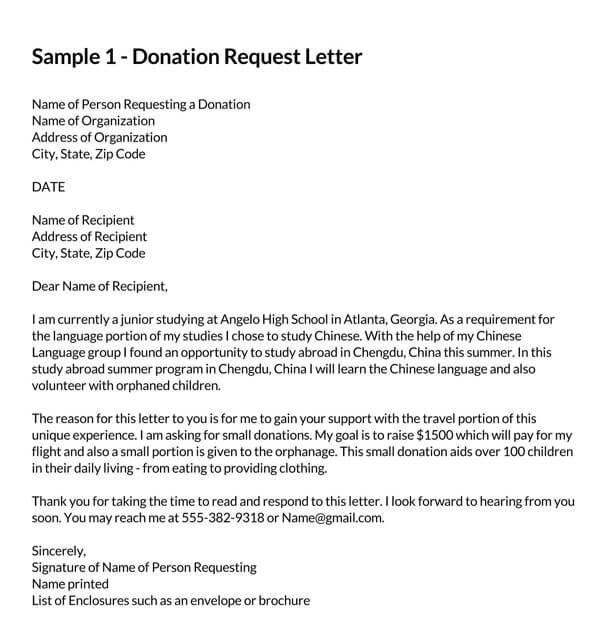
The most critical questions that donors or potential donors ask are what is the objective or mission of fundraising and why should they trust you.
Donation receipts are the accounting records of the donations received from a donor.
The information required in a donation receipt is the name of the person and the amount he/she has contributed to a fundraising campaign.
The art of persuasive donation writing is hidden in the sentence; simplicity is the ultimate maturity. If withstood long or obscure, it will not help you raise funds. It would help if you mobilized your efforts to write a simple, straightforward ,and technically sound donation letter to raise funds for your individual and corporate appeals.
Related Documents

Business Trip Approval Request Letter (Free Templates)


COMMENTS
Corporate Donation Request Letter. Subject: [organization's name] needs you. Dear [donor's name, for more effectiveness, find the business owner or CEO], My name is [name] and I am in the [position] for [organization's name]. Our team works hard to support and bring awareness to [organization's cause].
Center your letter on how the donor's actions will make a difference to your cause, using pronouns like "you" and "your" to help paint a picture of how they're included in your mission and impact. 4. Deliver an emotional yet focused appeal 💓.
We have written an article on writing fundraising letters in the past. This article explains different types of donation letters and gives examples of how organizations have used them. Here are the 8 types of donation letters you'll learn about in this blog -. Individual donation. Corporate donation.
How to write the perfect donation request letter in 10 steps. To write an inspiring donation letter, follow these simple steps: 1. Start with a personalized greeting. The first thing that your donors look for is a personalized salutation, begin your letters with a nice greeting and include your recipient's name. Donation letters without a ...
Letter #1: Friends of the Larchmont Library. This donation letter receives high marks for its structure, content, and overall appearance. Although this copy doesn't speak to a specific donor, it does address their past support, current happenings at the library, and the current need.
6 Donation Request Letter Best Practices. Good donation request letters clearly state what you want, how the donors will benefit, how you'll use the money, and what you've already accomplished. These showcase a vision for your nonprofit's future and a strong belief that you can achieve it with the requested funding.
If possible, tie your request to a specific impact it will have. For example: "Your donation of $25 will help provide a backpack full of school supplies for a local student in need.". A call-to-action. Wrap up your letter with the concrete next steps that you want the reader to take.
The best charitable donation request letter templates include details about the difference each dollar amount can make. For example, "Just a $25 donation can provide a holiday meal for a family of four.". Build trust. Mention your organization's history and achievements, like awards or partnerships, to build credibility.
Sign off: Add your signature, job title and name, and thank them again for their support. 1. Individual fundraising donation request letters. The most common type of fundraising letter is the individual letter, sent to supporters, donors or volunteers on your database during major fundraising campaigns.
A donation request letter template is a reusable form that can be used by charities and non-profit organizations. Donation request letters are an important part of any charity seeking funding for a certain cause or fundraising for charitable events. Donation request letters allow organizations to reach a wide range of people all across the world.
This guide will walk you through the structure of a donation letter and tips for personalization, follow-up letters, and corporate recipients. Structuring and Writing Your Donation Letter. A donation letter's fundamental structure should be familiar if you've written other letters. Follow these steps for writing and using donation letters.
Donation Thank you Letter. Donation thank you letter is written to thank the donor for fulfilling the donation request letter. Here is a sample of the letter. Dear Braddon, Your recent donation of $1,500 was warmly received. We are glad that you are concerned with what we are trying to achieve as an organization.
A Personalized Greeting. The start of your letter should include a friendly greeting. This greeting should be as personalized as possible. You can include the potential donor's name and any details you may have about their relationship to the organization, such as if they are a former or current donor or volunteer.
Donation request letters are typed or handwritten correspondences used by individuals who are looking to raise money for a project, event, expense, or other cause. They can be sent to family members and friends, members of the community, and even corporations and businesses. Donation request letters usually accompany another type of fundraising ...
Sample Non Profit Donation Letter. Example request for donation letter, seeking assistance to fund a youth program for boys. 11/1/2009. Dear Mr. and Mrs. Francom, In 2009 Number One Nonprofit helped over 350 underprivileged boys participated in Boy Scout activities in our community. They had a chance to learn to swim, learn basic survival and ...
Donation Request Letter. Template 1: Hello FIRST_NAME, Thank you for considering supporting our organization. We rely heavily on the generosity of our community to sustain our programs and services. In order to request a donation from your company, we have put together this brief questionnaire.
Every donation letter template should start with a personal salutation that greets the potential donor by name. If you don't know their name, use something friendly like "Dear friend, neighbor, etc.". Project details. Explain to potential donors what you need the money for. If you don't prove your good cause, you probably won't get ...
I'm writing to ask you to support me and my [cause/project/etc.]. Just a small donation of [amount] can help me [accomplish task/reach a goal/etc.]. Your donation will go toward [describe exactly what the contribution will be used for]. [When possible, add a personal connection to tie the donor to the cause.
As you will see by the examples below, your letter will contain: Your name, address and contact information. The current date the letter was typed. Your Recipients name, address and contact information. Subject line. Salutation. The text body, single spaced with double spacing in between paragraphs. Closing. Your signature.
Tip # 3: Ask for Money. When it comes to writing a donation letter, you should ensure to ask for the money explicitly. Asking for support may be a generic term that may make them think what you are asking for. Once you have explained about all the benefits and details, clearly ask for donation.
Use the appropriate salutation and a personalized greeting. Include information about your organization and mission. Explain the current project, priority, or need. Share persuasive details about the project's impact. Make a specific request. Add a clear call to action. Express your gratitude. Sign the letter.
Avoid paragraphs that are longer than seven lines. Use bullets to add to your points. Use subtitles. If the letter is long, try to center and underline the subtitles. Underline sparingly but consistently to draw attention to keywords and phrases. Whereas the format of your letter must be in the following order: